Our Catamarans
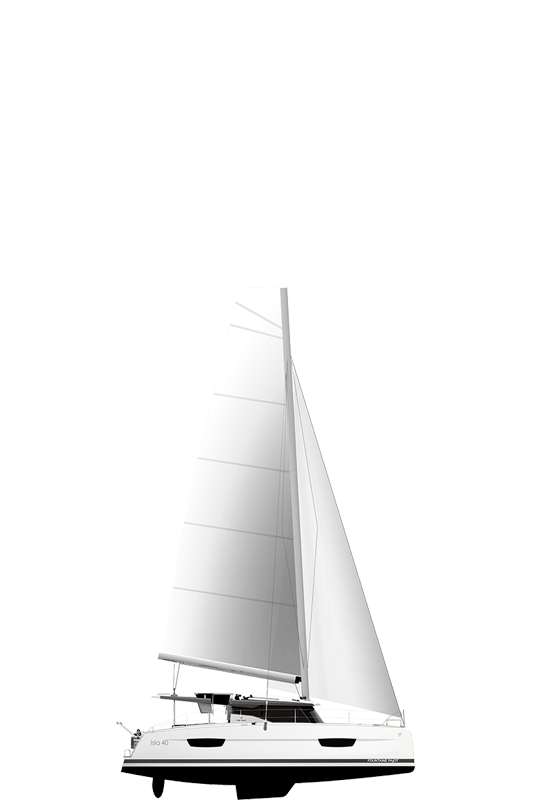
Explore our models in a different way thanks to the virtual marina
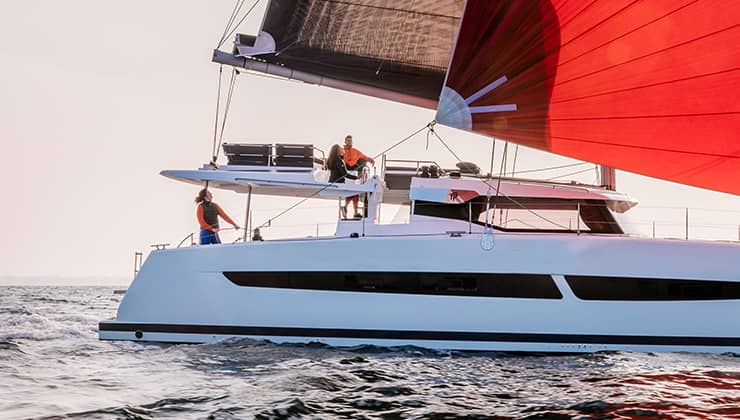
Efficiency through design
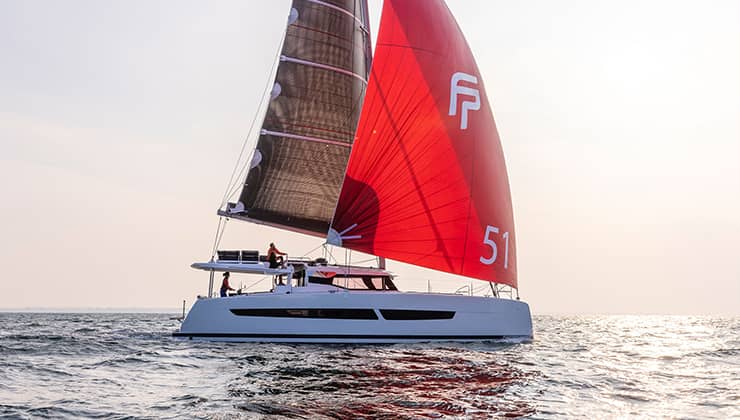
A feel for the sea: sailboats first and foremost
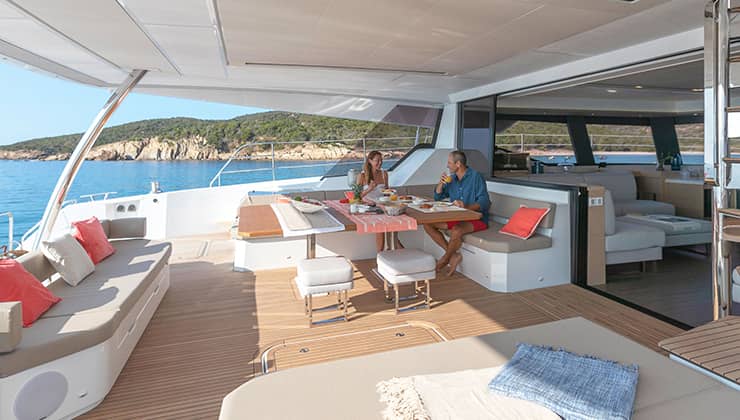
When volume transforms to real space
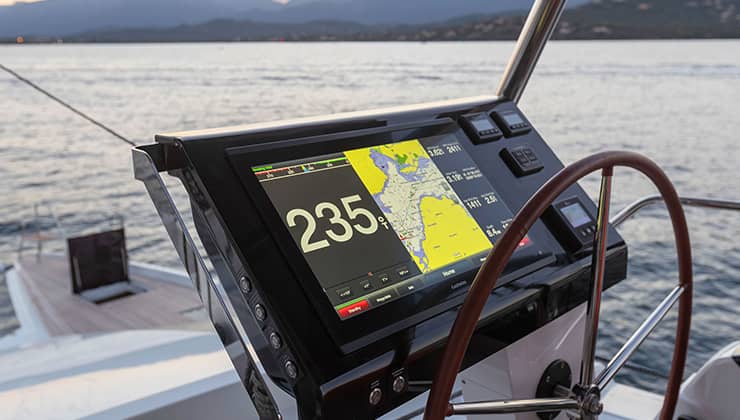
Innovation as a foundation
- Smart Electric
- Virtual marina
- Experiences

A circumnavigation sailing trip on a catamaran : a 1,546-day adventure across 27 countries
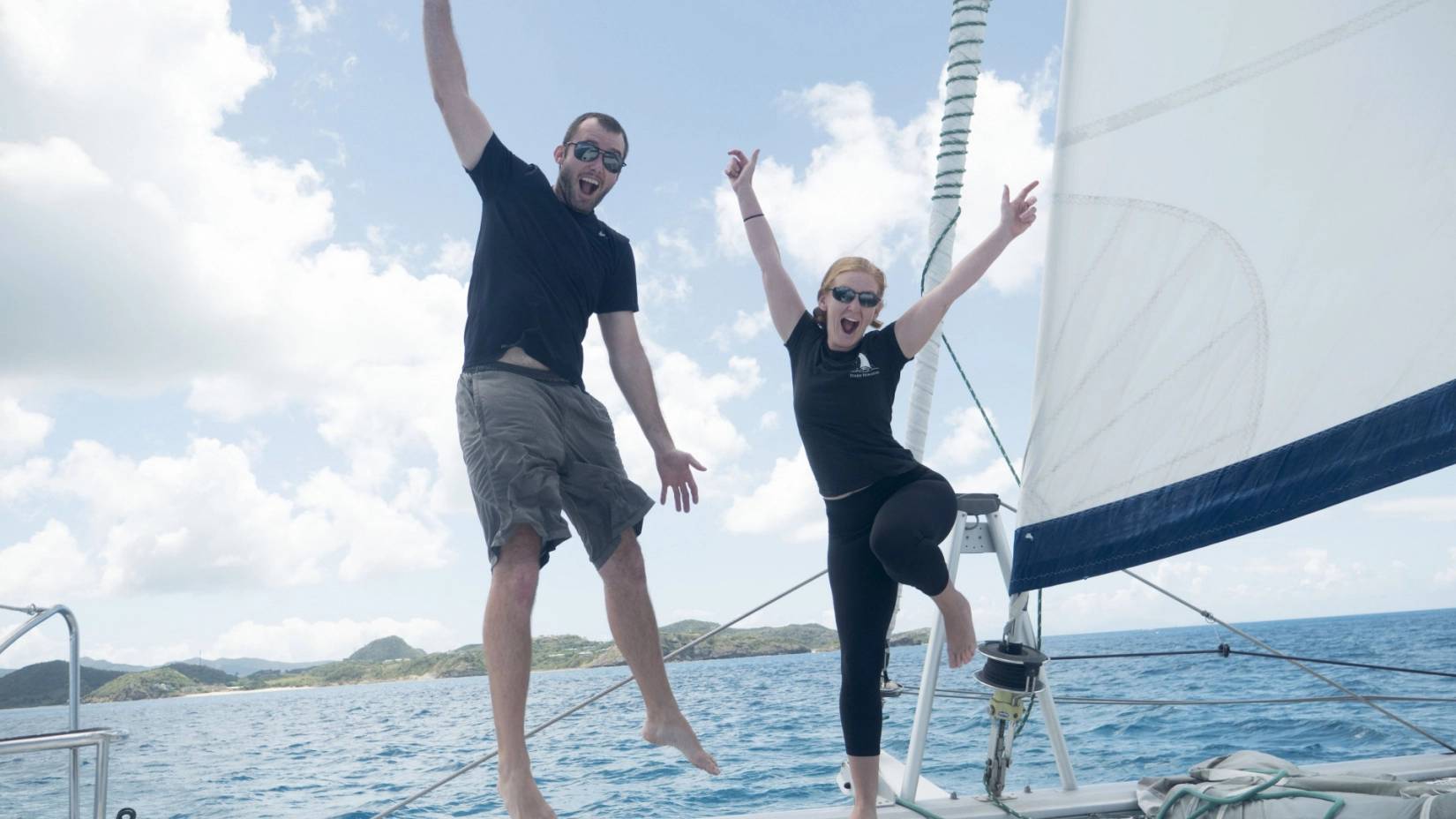
David and Amy
Round-the-world
Trip duration
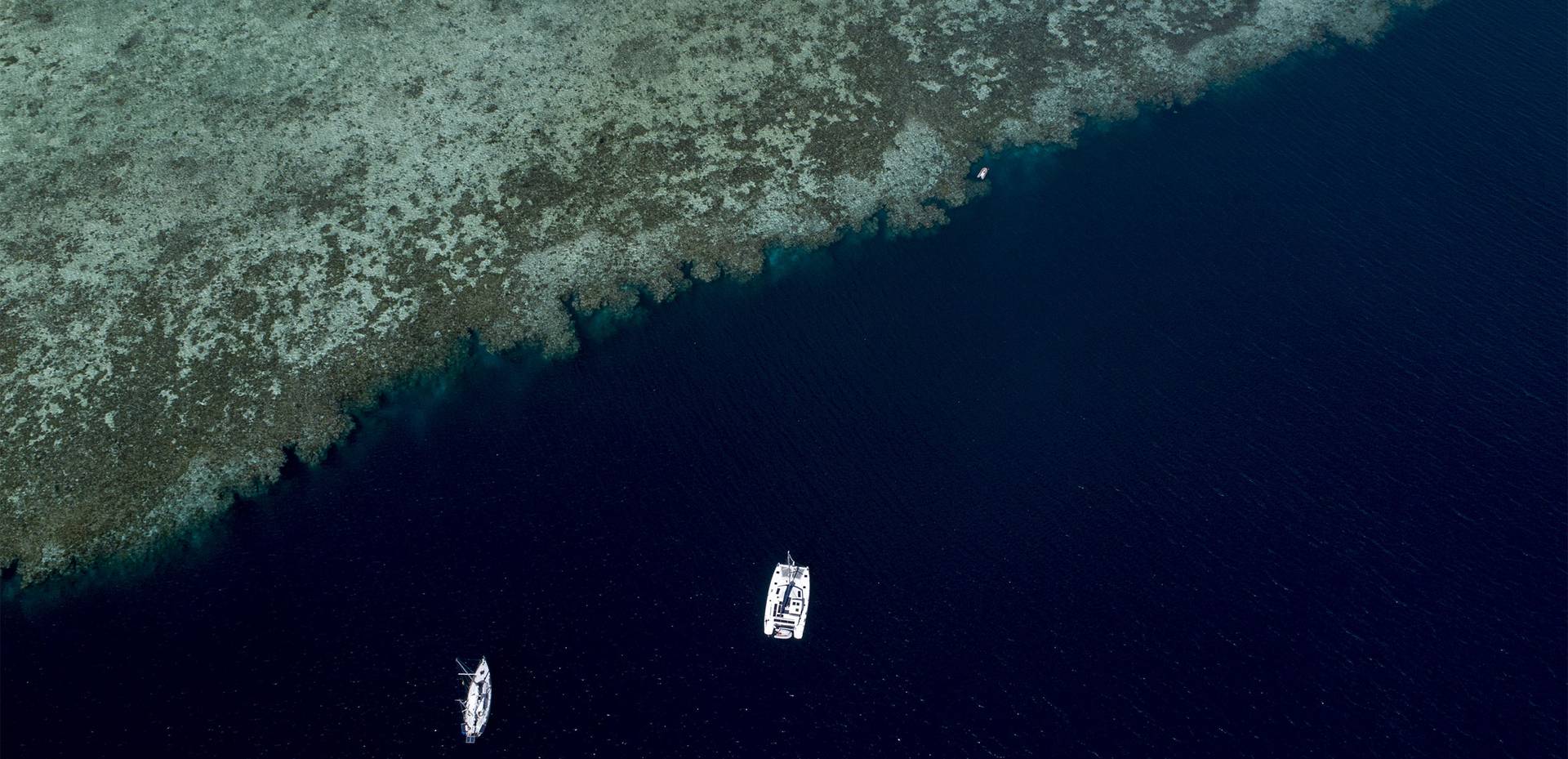
A round-the-world in 1,546 days
Onboard their Fountaine Pajot Hélia 44 “Starry Horizons”, the couple criss-crossed the seas and oceans for no less than 546 days, covering more than 34,140 nautical miles and 27 countries from the port of Antigua in the Caribbean, forming a loop around the equador.
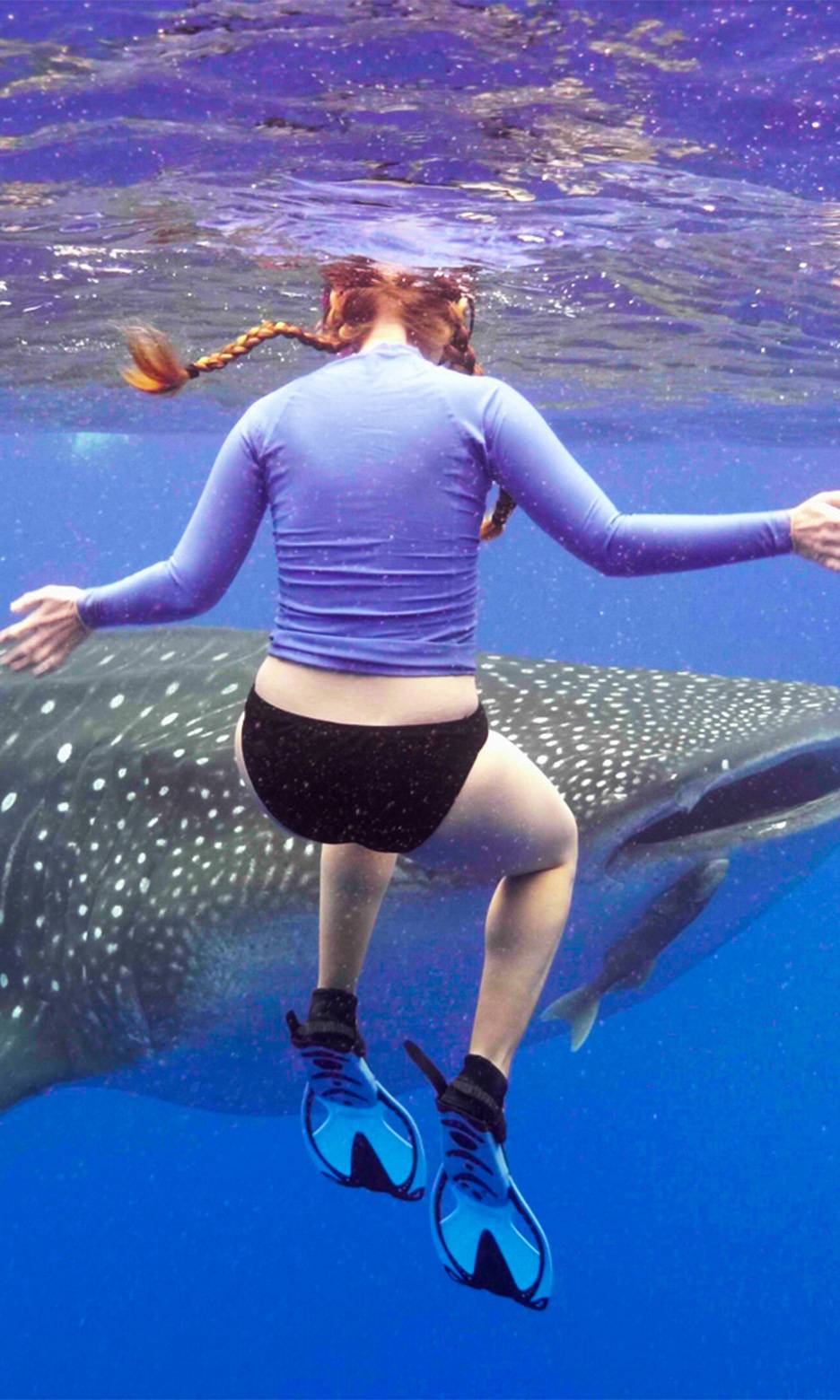
Presentation of the crew
“We are David and Amy Alton, two thirty-something-year-old Americans. When we met, Amy was an engineer and David was in the oil and gas industry in finance. While Amy had grown up around boats all her life, David had only been sailing once! Soon after we met, Amy took over the family business in the maritime industry.
Eventually, we both got our USCG 100 Ton Master’s licenses and David came to work for Amy driving her boats. This is why we call her the Admiral!”
Preparation for the circumnavigation
“Since we were both licensed captains and had been day sailing around Galveston Bay on our previous 30 feet catamaran, we had an advantage over cruisers who are starting from scratch. We did want to get more experience on bigger boats, so we chartered down in the Caribbean.
Of course, we read a lot of books, blogs, and magazines. There were hardly any sailing YouTube channels out at the time, so that wasn’t a big thing for us.”
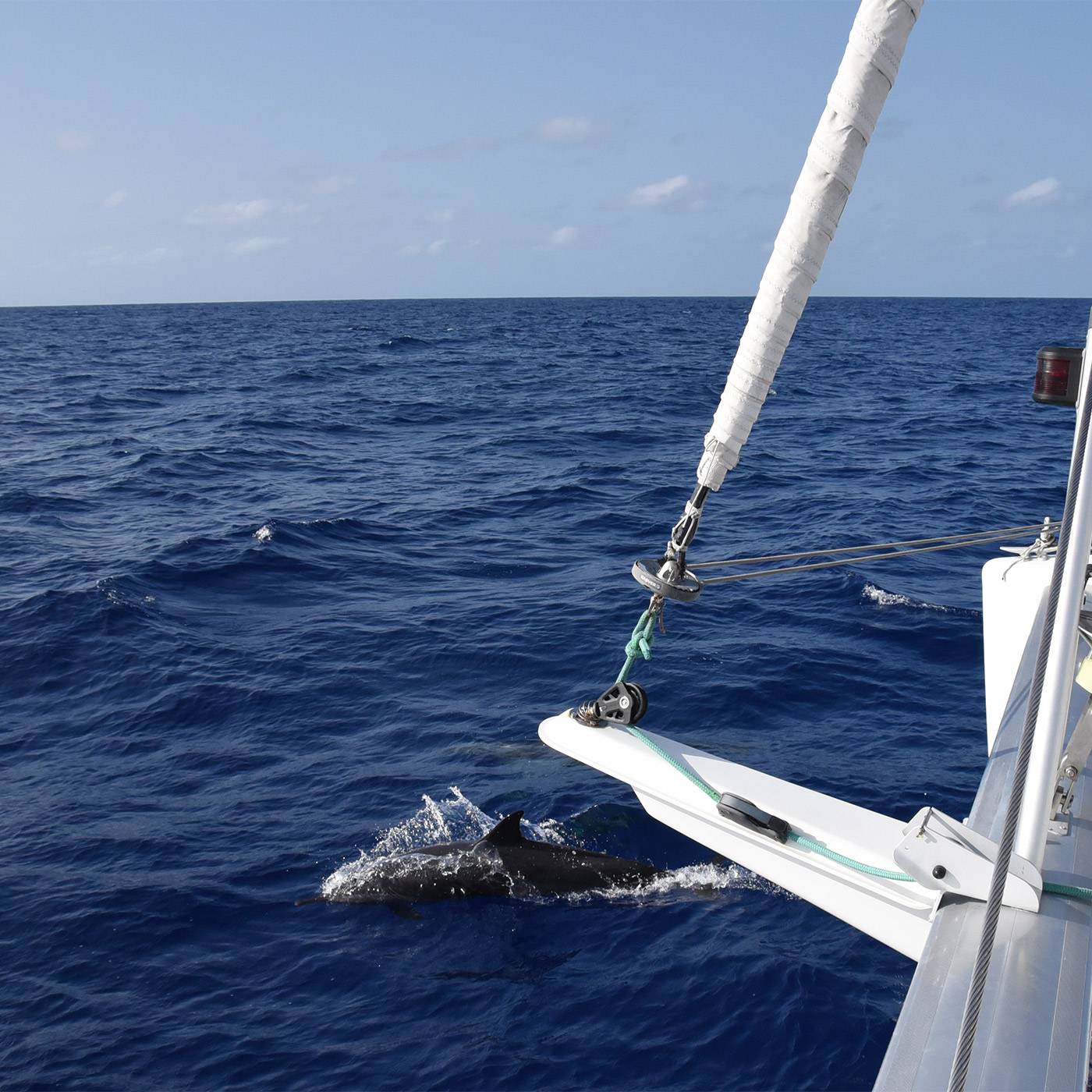
A cruise of more than 34,140 nautical miles
“We picked up our boat from the factory in La Rochelle in October of 2014. From there, we did a self-delivery, bringing the boat to Florida in three steps to do some outfitting to kit her out for a long-term cruising boat.
From Florida, we sailed the Bahamas, then up to Nova Scotia and Maine before heading down to the Caribbean. Three months later, we passed through the Panama Canal and spent two seasons in the South Pacific.
After seven months in Australia, we sailed up through Southeast Asia, then across the Indian Ocean, exploring lots of remote islands. In December of 2019, we passed the Cape of Good Hope in South Africa, and in March of 2020, we docked in Antigua, crossing our wake and completing our world circumnavigation. “
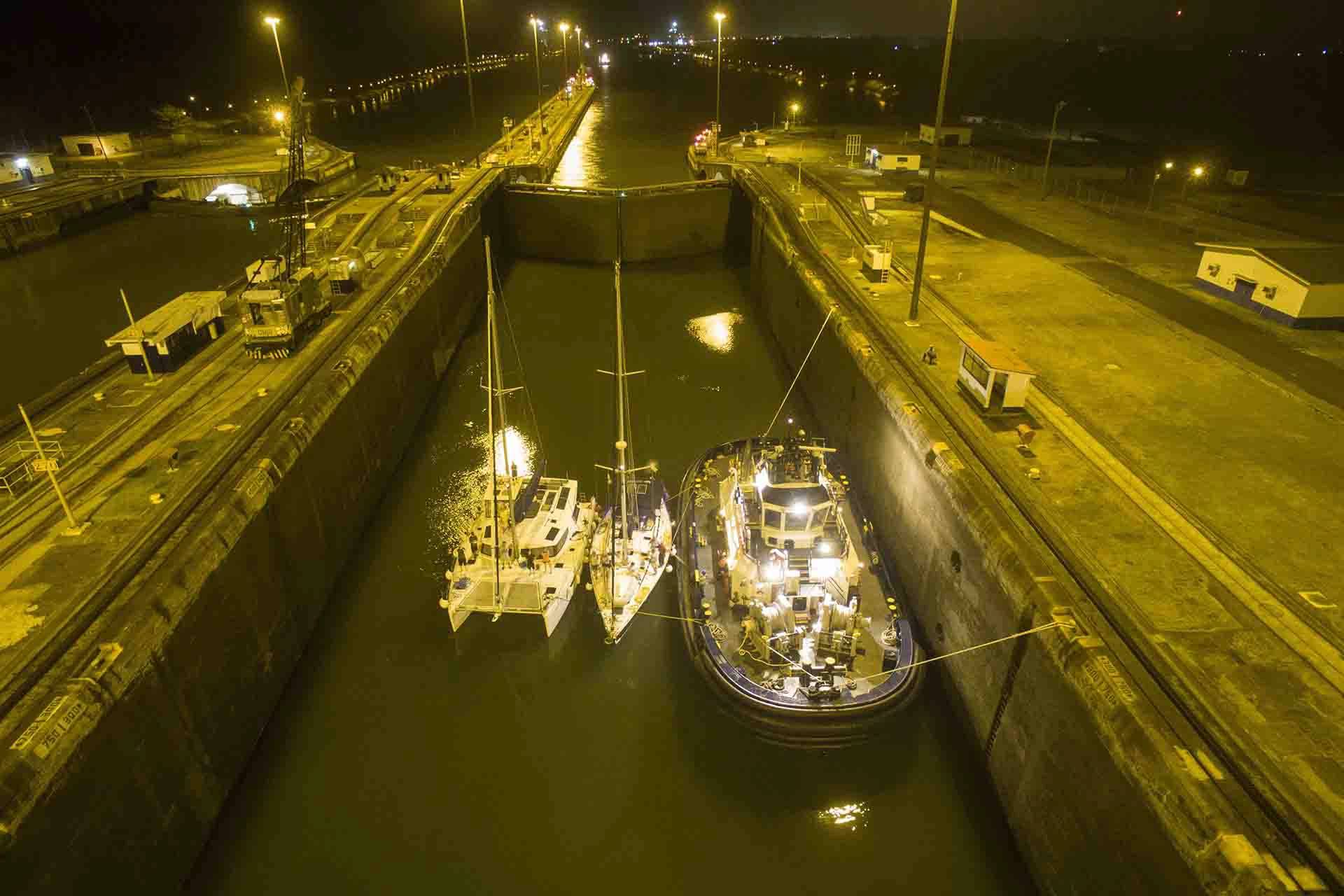
Favorite sailing areas
“The South Pacific is easily our favorite sailing ground. The islands are remote and incredibly beautiful, and the people are amazingly friendly. French Polynesia is a dream destination, with rugged islands in the Marquesas, or idyllic atolls in the Tuamotus. Bora Bora exceeded expectations with crystal clear water and manta rays.”
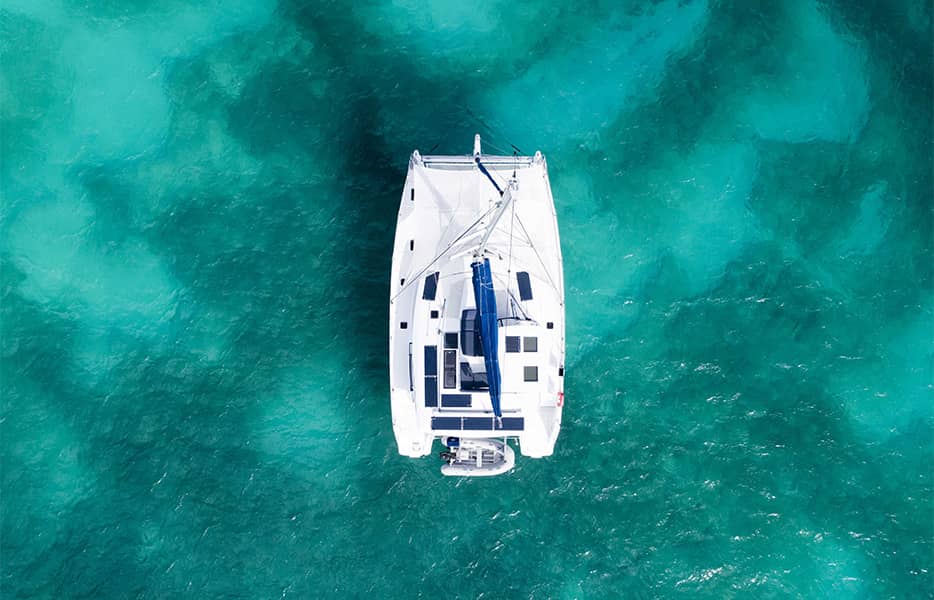
Choosing the right catamaran for a circumnavigation
“When we were boat shopping, we had a list of requirements that we wanted. We did primarily look at the biggest production yards because we wanted to keep a strong resale value and yards like Fountaine Pajot have a good reputation – they’ve been building great boats for so long.
We went to the Annapolis Boat Show with a few models in mind, and when we got on the Helia is was an easy decision. The layout of the boat is amazing, and while she’s got plenty of space, she is definitely on the faster side for cruising boats.
All around the world we have meet Fountaine Pajots of all ages and sizes. Starry Horizons has held up very well in the nearly six years we have owned her, so we’ve been very pleased with our purchase.”
Circumnavigate on a catamaran
“On our entire circumnavigation, we spent less than 13% of our nights at sea. This means that 87% of the time we were stationary, at anchor or in a marina, taking advantage of the space our catamaran offered us.
Moreover, when we were sailing, we were mainly sailing downwind. Although we didn’t have much experience with monohulls, many friends complained about the performance of their boat downwind. Starry Horizons is super comfortable downwind.
It is also extremely performant and very safe, we always had confidence in our boat, even when the sea was rough, in squalls or tropical storms.”
Next adventures
“Right now, Starry Horizons is taking a well-deserved rest on the hard for hurricane season. We are back in Texas visiting our families.
We will launch again sometime within the next twelve months and cruise close to home; the Bahamas, Chesapeake Bay, or other nearby places. After that, we don’t have any plans!”
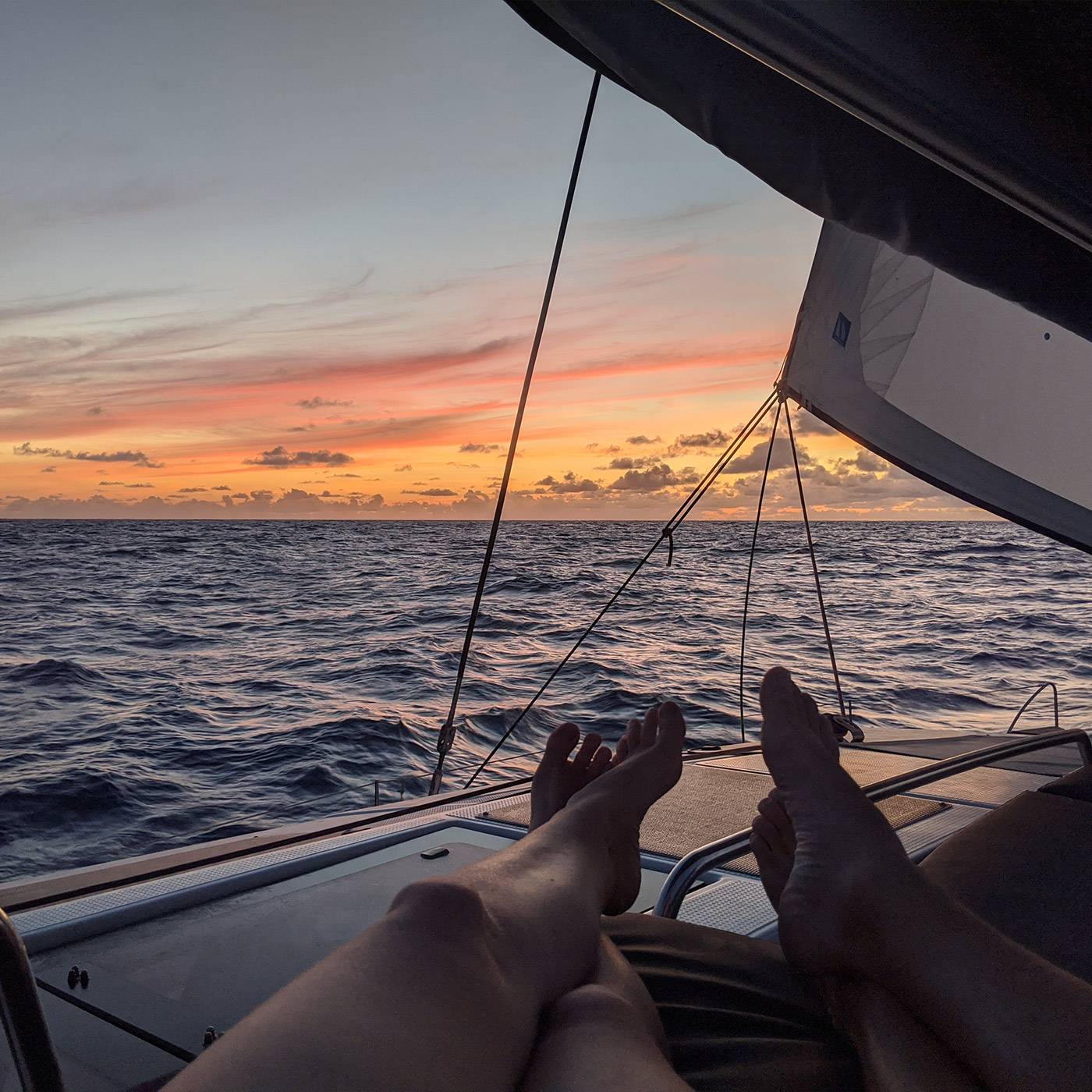
David and Amy regularly share tips and surprising anecdotes on their blog to accompany you in your navigations, the preparation for long cruises or simply to share their most beautiful sailing experiences and anchorages.
Starry horizons’ circumnavigation in a nutshell
- Leaving Antigua on December 30, 2015
- 10 navigations au long courslong-range navogations (1,000+ nm)
- 1,546 sailing days
- 4 crossings of the equator
- 22 nautical miles/day in average
- 34,140 nautical miles travelled
- 6 hauls out
- 27 countries and territories crossed
- 7 home returns
- 93.5% of the miles sailed as. a duo
- Arrival in Antigua on March 26, 2020
Subscribe to the newsletter
Follow the adventures of Fountaine Pajot Owners, discover the latest news and upcoming events, and take part in the development of the Boat of tomorrow!
Compare models
Catamaran Isla 40
Catamaran Astréa 42

Hosting capacity
Motorisation
Technical information
User-friendly areas
Sunbathing Non
Kitchen Non
Sunbathing Oui
Discover the prices
Double rooms
Your contact details
One last step before reaching the next page & discovering the prices proposed & main options for this version! You'll then be able, to schedule a live chat with your local dealer to discuss all the options and configurations available for this model!
Your home port
Any questions?
No pack information currently available online for this Flagship model. We will get back to you directly. Thank you
Would you like to configure this model’s options or set up another model?
Make an appointment with your nearest dealer and choose the boat of your dreams.
- Outremer 45
- Outremer 4X
- Outremer 4.zero
- Outremer 52
- Outremer 55
- Outremer 51
- Outremer 5X
- All the Outremer Fleet
- Personalized support
- Blue Water Sailing Seminars
- Our concept
- The Outremer team
- Our commitments
- Construction principles
- Our catamaran services
- After-sales customer service & Quality control
- Offshore Connected Catamaran Maintenance
- Concierge Services
- Our owners’ stories
- FAQ – Outremer catamarans

- Brokerage: used catamarans for sale
- Privacy Policy
- Legal Notice
- Grand Large Yatching
Catamaran VS Monohull: what should you choose to sail around the world?

Sailing around the world is a dream come true: you discover the world to the rhythm of the wind and the stopovers, exploring new destinations every day as you sail. If you’re just starting to read this article, you’re probably nurturing this project. Are you planning to sail around the globe? Then the choice of ship for your next voyage is crucial. It alone will determine how you experience this adventure! Catamaran VS Monohull : Do you know the differences between single-hulled and double-hulled sailing yachts for an ocean voyage? What are the advantages of sailing around the world in a catamaran, rather than a monohull?
Aboard a multihull, greater comfort and stability
When you decide to sail around the world, whether you’re going alone, as a couple or as a family, you’re always leaving your home and comforts behind to move aboard a monohull or catamaran. While you’ll always have to get used to living in different spaces, in a changing environment, the living space on each boat can vary. So, if you’re setting off on an adventure on a monohull, for example, you’ll inevitably have less living space than in a unit made up of two hulls. It’s up to you to work out how much living space and storage volume you need, depending on the crew you’re putting together!
The length of the hull, of course, will have a big influence on the interior layout of the boat and its facilities: the number of cabins, washrooms and the width of spaces often depend on the waterline length of a boat. Fortunately, choosing a larger catamaran for greater living comfort doesn’t mean sacrificing sailing comfort. Bénédicte Héliès, owner of the first Outremer 55, Saga, confided as much to our yard: “After our first round-the-world trip on our Outremer 51, our children were growing up and taking up more space, so we wanted a saloon that was a little more spacious, but just as easy to manoeuvre. We were delighted! Our new catamaran has proved to be very agile in light airs despite its size, powerful in a breeze and comfortable at sea. The platform is exceptionally spacious for such a seaworthy boat, and the living space in the saloon is very appreciable.
As you know, the comfort of a boat is mainly experienced when sailing. By opting for a catamaran on a round-the-world trip, you will always choose to heel less than you would aboard a monohull yacht. When sailing or at anchor, you’ll notice the difference aboard a catamaran: by definition, it is much more stable!
Read also: Monohull to multihull – Nikki Henderson

The evolution of catamaran performance
The perception of catamarans has evolved considerably over the last few decades, from boats mainly associated with chartering to multihulls capable of competing with monohulls in terms of performance.
In the 1960s and 1970s, catamarans began to appear in regattas, where their speed potential was already evident. At the famous Transpacific Yacht Race, for example, catamarans such as the Seasmoke broke records, proving their ability to sail fast over long distances.
A catamaran’s ability to sail upwind and close-hauled, once considered inferior to that of monohulls, has been enhanced by slimmer, more efficient hull designs, as well as improvements in rigging and sails. These technological advances have enabled catamarans to achieve previously unattainable performances, making them suitable for fast and safe ocean crossings.
Bénédicte can testify to this development: “The catamaran we’ve chosen sails easily in light airs. From 4-5 knots, it moves under sail, whereas classic catamarans need 10 to 15 knots to move properly, depending on the points of sail. So we use the engine very little and sail almost exclusively.
On long journeys, sometimes the weather conditions are not as forecast. They can also change more quickly than expected. If, for example, there’s a storm approaching that we weren’t able to anticipate, a good sailboat will enable you to reach your destination more quickly. Bénédicte explains: “On our boat, being able to ‘swallow’ 250 miles a day is very interesting. This means we can shorten crossing times and avoid being caught out by bad weather, as most phenomena can be predicted within 4-5 days”.
In short, today’s catamarans are no longer simply cruising boats designed for coastal sailing. They represent a serious choice for sailors looking to combine comfort, performance and safety, capable of competing with monohulls in the most demanding sailing conditions.
Read also: Why every serious cruiser should go racing
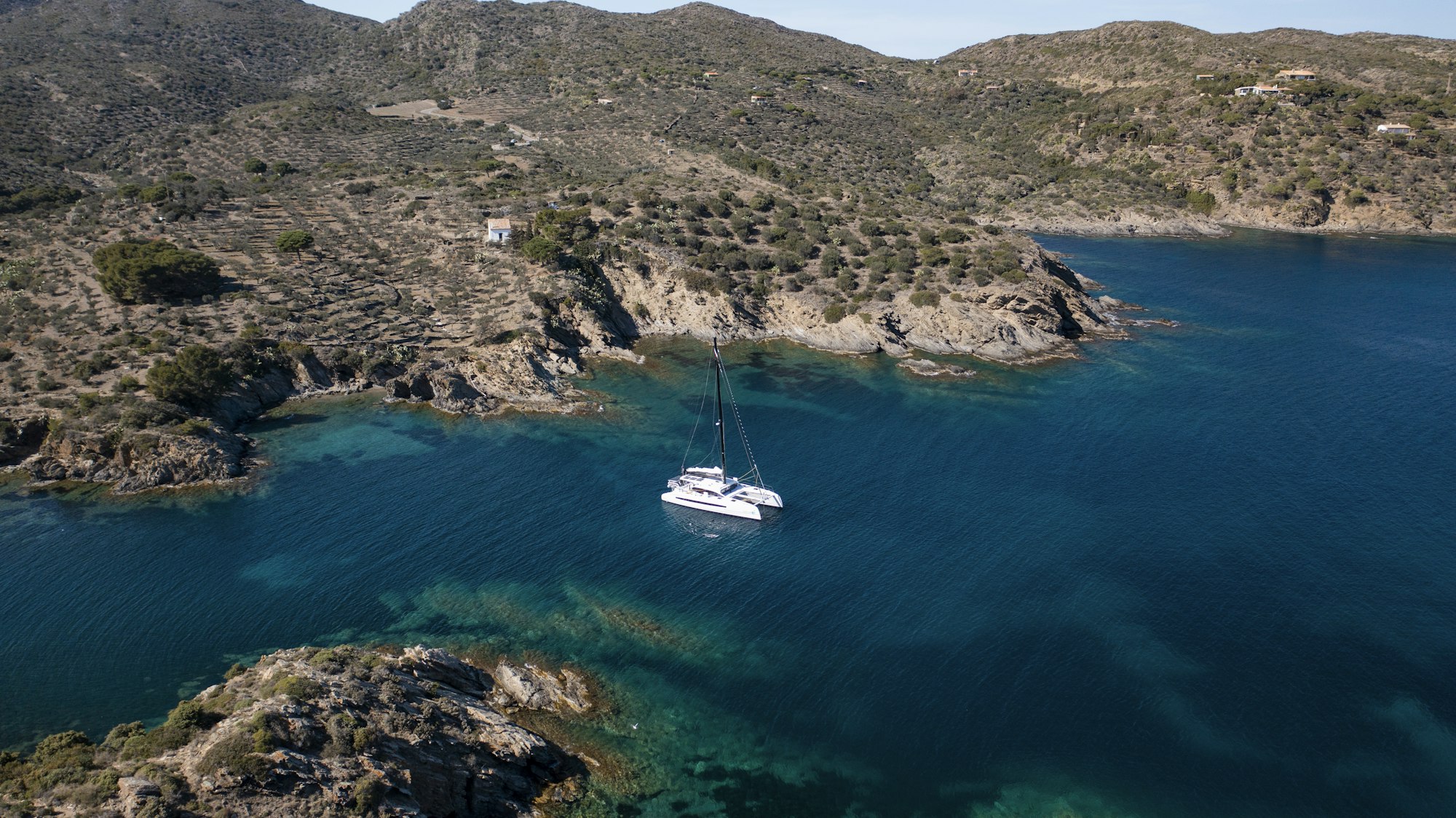
On a round-the-world catamaran trip, make the most of stopovers
You’ve probably already decided which islands or ports you’d like to visit.
Bear in mind that some catamarans allow you to make the most of anchorages and places to stop off: with a shallower draught than most monohulls, many allow their owners to get closer to the coast and beaches. With a catamaran, you can choose anchorages less frequented by other yachts to make the most of your time, and disembark more easily.
When you arrive in port or at an anchorage, for mooring, anchoring or taking a locker, catamarans also generally have the advantage of being more manoeuvrable than monohull yachts. So your arrival at your port of call will be much easier.
When you sail around the world, you inevitably meet other crews who are also travelling, and with whom you always find things in common. If you like having people over, welcoming them aboard your catamaran will be ideal!
Continue navigation
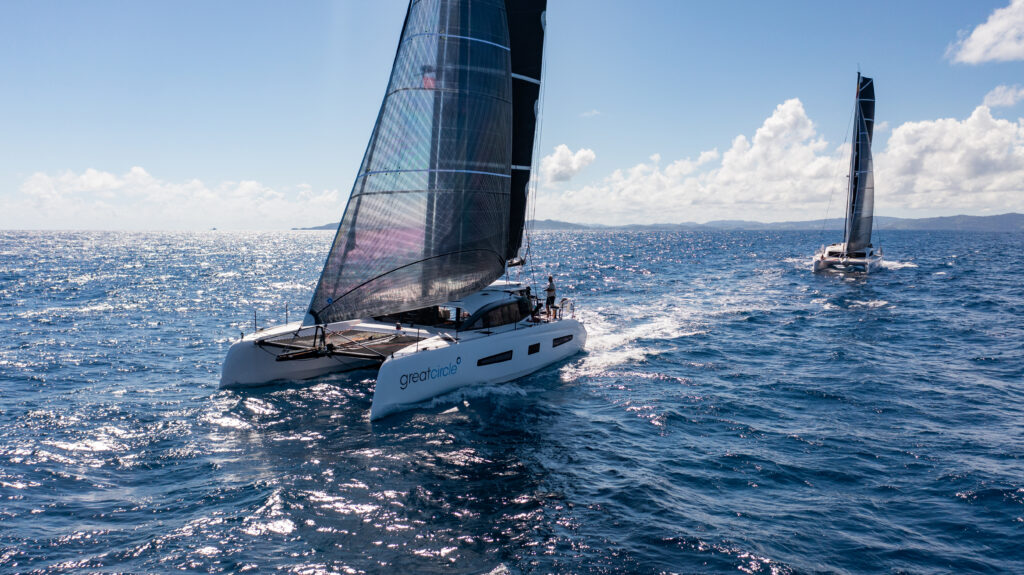
40.000 miles and 3 years to get from La Grande Motte to La Grande Motte
Marijke and Mark sail the Outremer 55 Great Circle.
Since its launch in 2021, the boat has sailed around the world with the GLYWO 500.
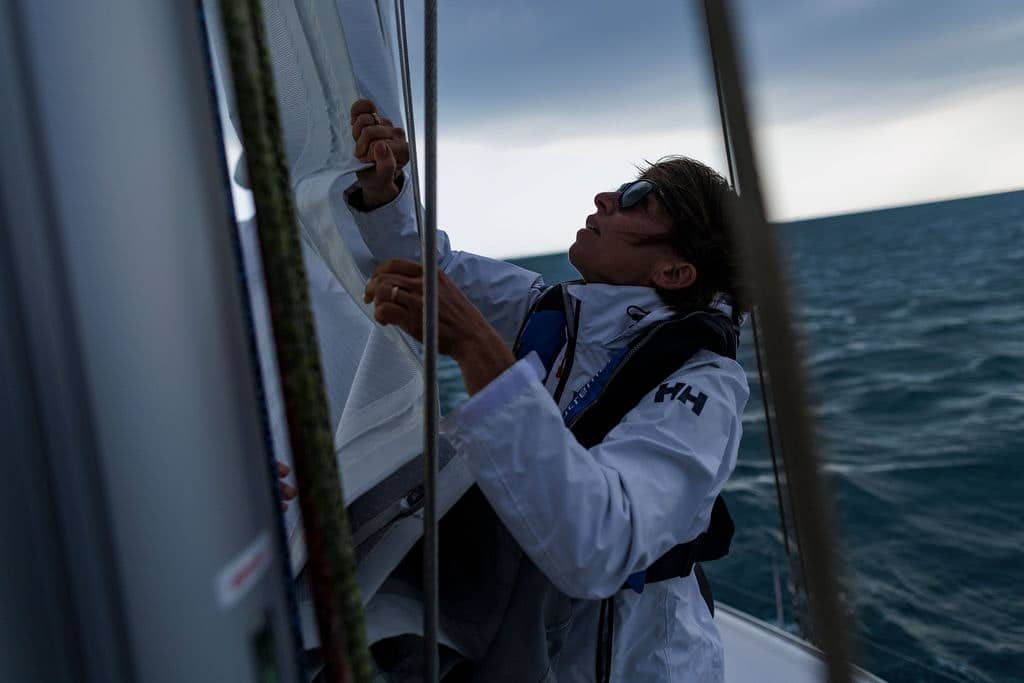
Setting off on a catamaran with the best sailing weather
When you’re getting ready to set off on a sailing trip, it’s vital to find out about the seasons and weather phenomena in your chosen sailing area. Even before choosing your cruising destination or travel itinerary, or even selecting your yacht!
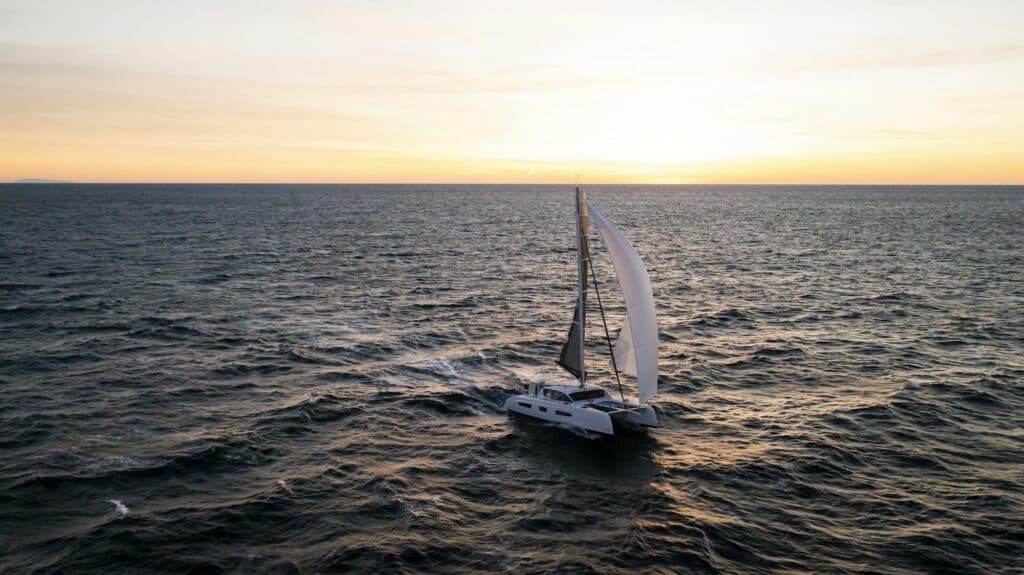
The Importance of Defining Success
In the Autumn of 2023, I ran a ‘Webinars for Women’ mini-series on transatlantic preparations. The first session was titled: “How to approach transatlantic preparation.” As I zoomed out of the nitty gritty of canned food recipes, spare parts inventories, and preventative sail repair and took a broader look at the framework for a successful crossing, I homed in on what I think the first and most important step is: defining your goal.
7 Best-Known Routes for Sailing Around the World (with Maps)
Route planning is among the most crucial bits of preparation, especially when it comes to circumnavigation. This article will give you seven of the most commonly used routes for sailing around the world. Some routes have been sailed many times by many people, others are obscure or even dangerous.
- The Fast Route - for the minimum time
- The Pleasure Route - for the maximal pleasure
- The Traditional Route - the road most taken
- The Arctic Route - for the rough ones
- The Dangerous Route - without regards for piracy
- The Cheap Route - with a budget in mind
- The Coast Lover's Route - never going far from the coast
Since circumnavigation is quite a complex matter, let's go through this list one by one below.
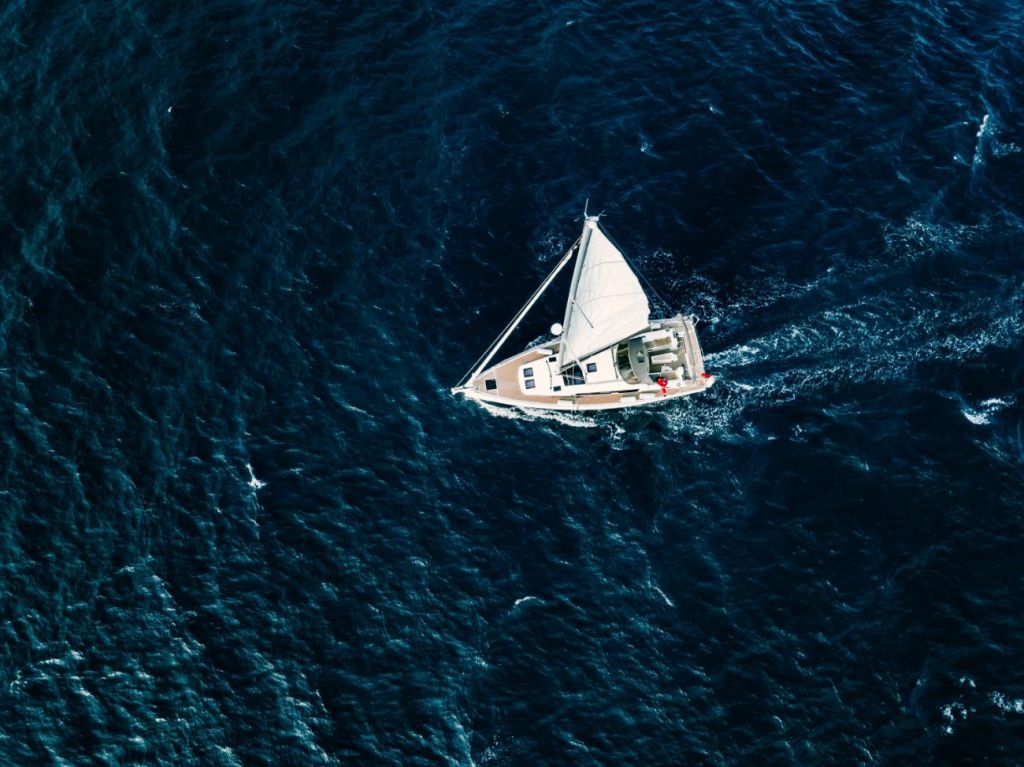
On this page:
How to choose a route for you, route for speed, the pleasure route, the traditional route, the arctic route, the dangerous route, the cheap route, the coast lover's route.
What route you will take depends on what kind of journey you are looking for. If the goal is to do it in the least amount of time possible, you will be choosing a different path than if you don't care about time and put emphasis on sightseeing.
Similarly, if safety and convenience are at the top of your priority list, you will choose a route that might differ greatly from that of a person ready to spend more on security and cut corners through tricky territories.
If you have specific locations in mind, you will take turns that are, logistically speaking, quite impractical, while if efficiency is what you want, there are certain places it would make little sense to visit.
And finally, if you are after comfort, you will avoid some bumpy places and times of the year, as opposed to somebody who won't mind venturing into the corners of the oceans that require a hell of a warm jacket.
There is no right or wrong answer here; don't feel some approaches are better than others. Just look at what you want from the journey, read through this article, and then choose what best suits you.
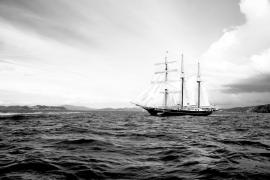
21 Places to Avoid Sailing Around the World (In Order)
Let's kick this off with a racing spirit. This is the route taken by those competing in Vendée Globe, a circumnavigation race. It takes a bit under three months...
...that is if you are a racer and so is your boat. If you are a cruiser kind of person, it will take more time, but the point is that this route is as straightforward as it gets.
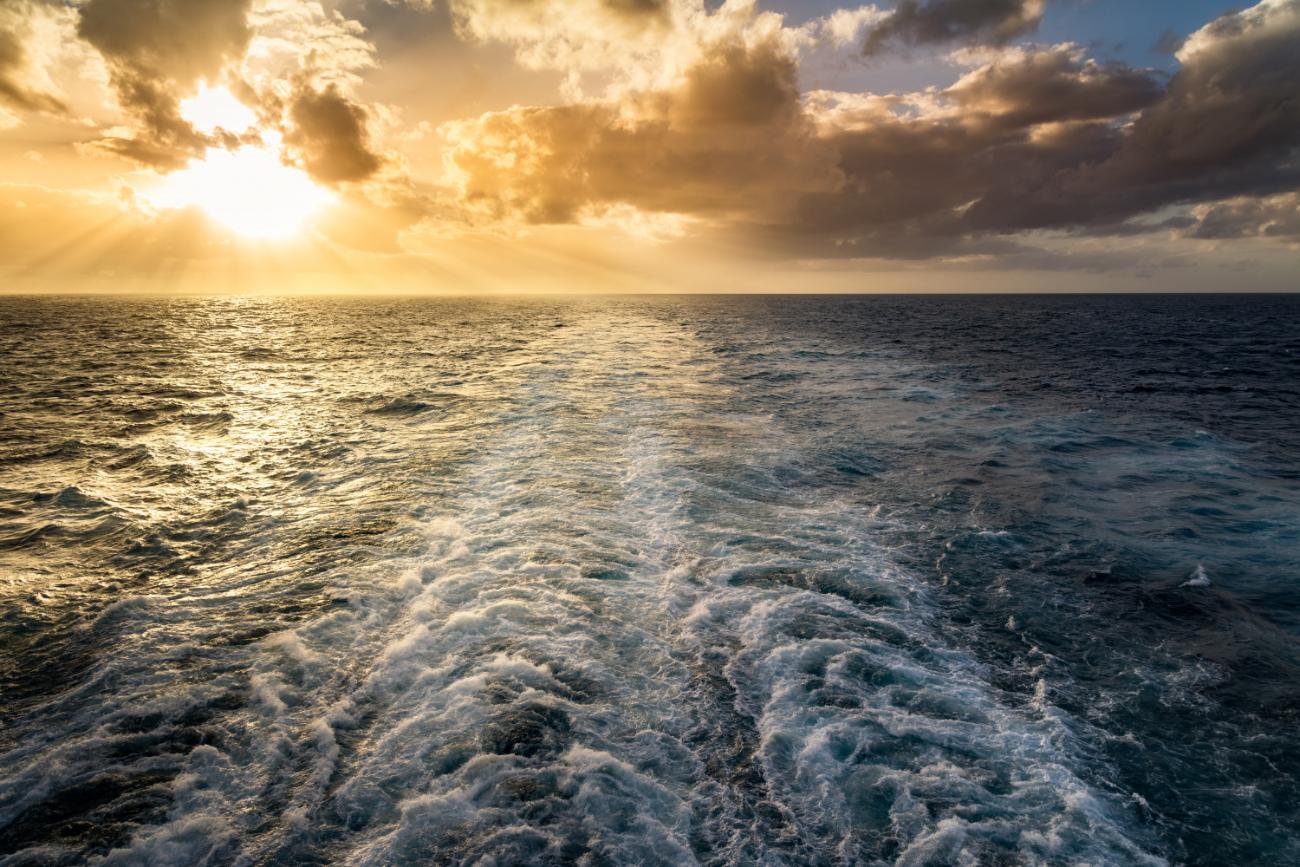
So what waypoints does it touch? Vendée globe racers start in France, then head down towards the Cape of Good Hope, circle Antarctica as close as the rules allow, and after getting to Cape Horn, head up to France again.
Of course, based on where you start from, your route might differ. But the idea is as follows:
- head south towards the Southern Ocean
- sail around Antarctica through the Southern Ocean
- after reaching the point where you met the Southern Ocean for the first time, head back up
The Southern Ocean is not a breeze, the cold waters mixing with the warmer ones coming from the north, plus the danger of icebergs, as well as the cold temperature, isn't how your typical holiday dream looks. That being said, it's up to you how close to Antarctica you will want to be when going around it.
This route doesn't touch down at any land, so you must be prepared for months on the sea as far as provisions, spares and mental capacity goes. Of course, this is variable, you can easily make landfall in Azores, South Africa, South Australia, or South America, and some of the South Pacific islands, if you need to. Either way, it is demanding logistically, so be sure to have your checklist in check .
It is among the most straightforward routes. Not just because it is probably the shortest one or the fastest one, but all the hassle with visas, check-ins, going through canals, and other lengthy land creatures' business will be foreign to you.
If you make it through the Southern Oceans unharmed, you will certainly have one hell of a story to tell.
Now let's go on the opposite side of the specter.
Let's suppose you theoretically have unlimited time. Instead of doing things quickly and efficiently, you want to take it at a leisurely pace while admiring all that there is to see.
This route will begin and end in the Mediterranean, but that's just because that's where I am based, sailing-wise. Wherever else you are, just pick the point of the route closest to you and begin there.
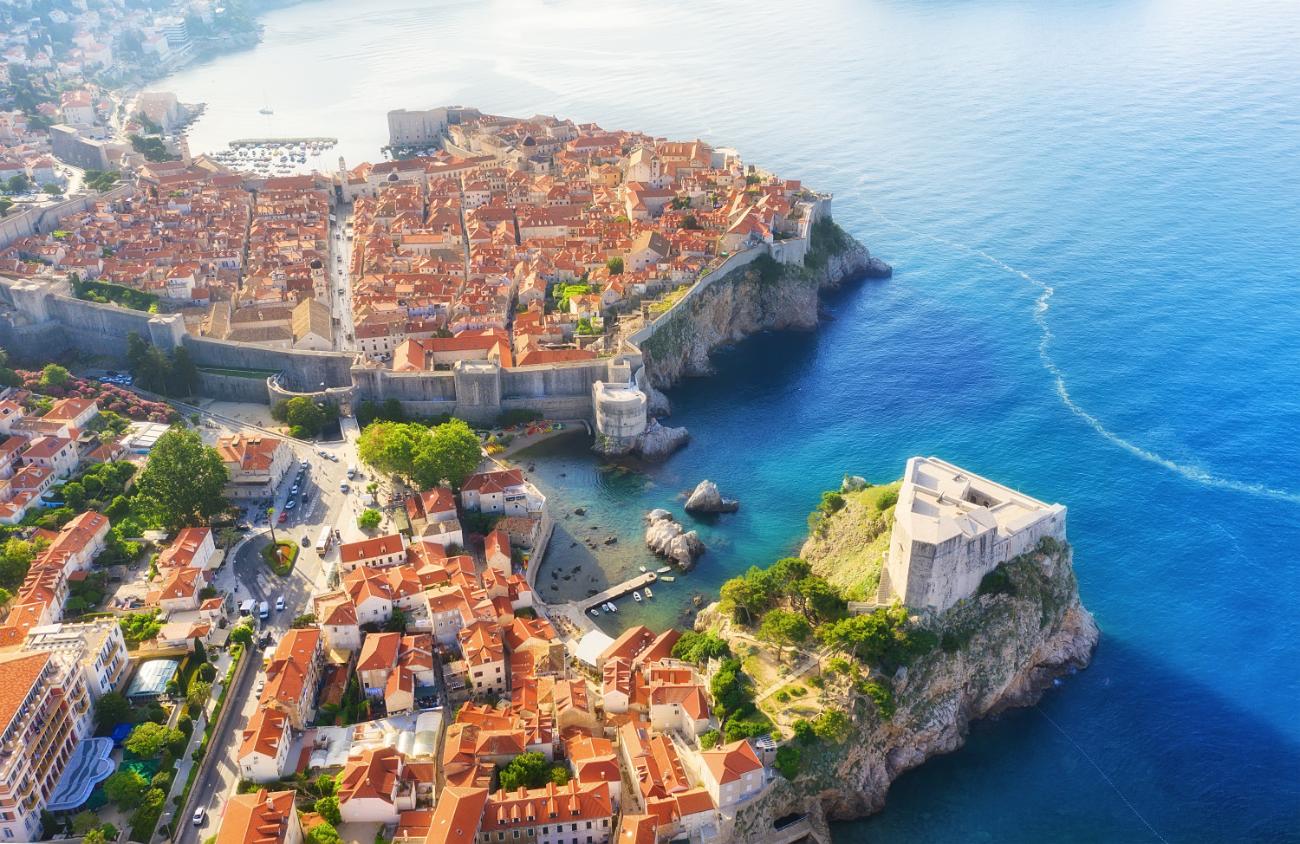
We will begin in Croatia, because it has beautiful shores and islands, travel around Greece with even more islands, the south around Italy, through Gibraltar. After that:
- head south to the Azores
- west to the Caribbean and through the Panama Canal
- west to Hawaii
- south to French Polynesia
- west to New Zealand, then Australia and Papua New Guinea
- northwest to Indonesia, Philippines, Vietnam, Thailand, India
- south to Madagascar, then along the African coast to Cape of Good Hope
- north to the Azores and then through Gibraltar back home
This route takes time since it aims to explore all it can even remotely touch. It's not just that the route is long, because the aim is to visit pretty places. You might also find yourself having to wait months at some places for the bad weather season to clear before you can make your next crossing. Have a look at our article about things to think about when planning for a long trip .
Because of that, this route is more demanding when it comes to planning, visa hassle, check-in research, more ports and anchors, more provisions planning. Also, your boat will need to be a solid liveaboard , since you will spend so much time on it. Logistically, it will be demanding.
But for all that hassle, you will literally get to see the world. You will visit many fantastic cultures, get to taste the cuisines from all over, and the long times waiting for the winds to calm down will be spent on exploring the place you are 'stuck' at.
What more does one need...
...except perhaps some middle ground. Now that we've been to two extremes, let's look at something in the middle: the route most commonly taken when circumnavigating.
It is rather similar to the Pleasure Route above except for skipping the Mediterranean, Pacific, and Southeast Asian stops.
Thus it goes as follows:
- From Europe, head south to the Azores
- west to Australia
- west to Cape of Good Hope
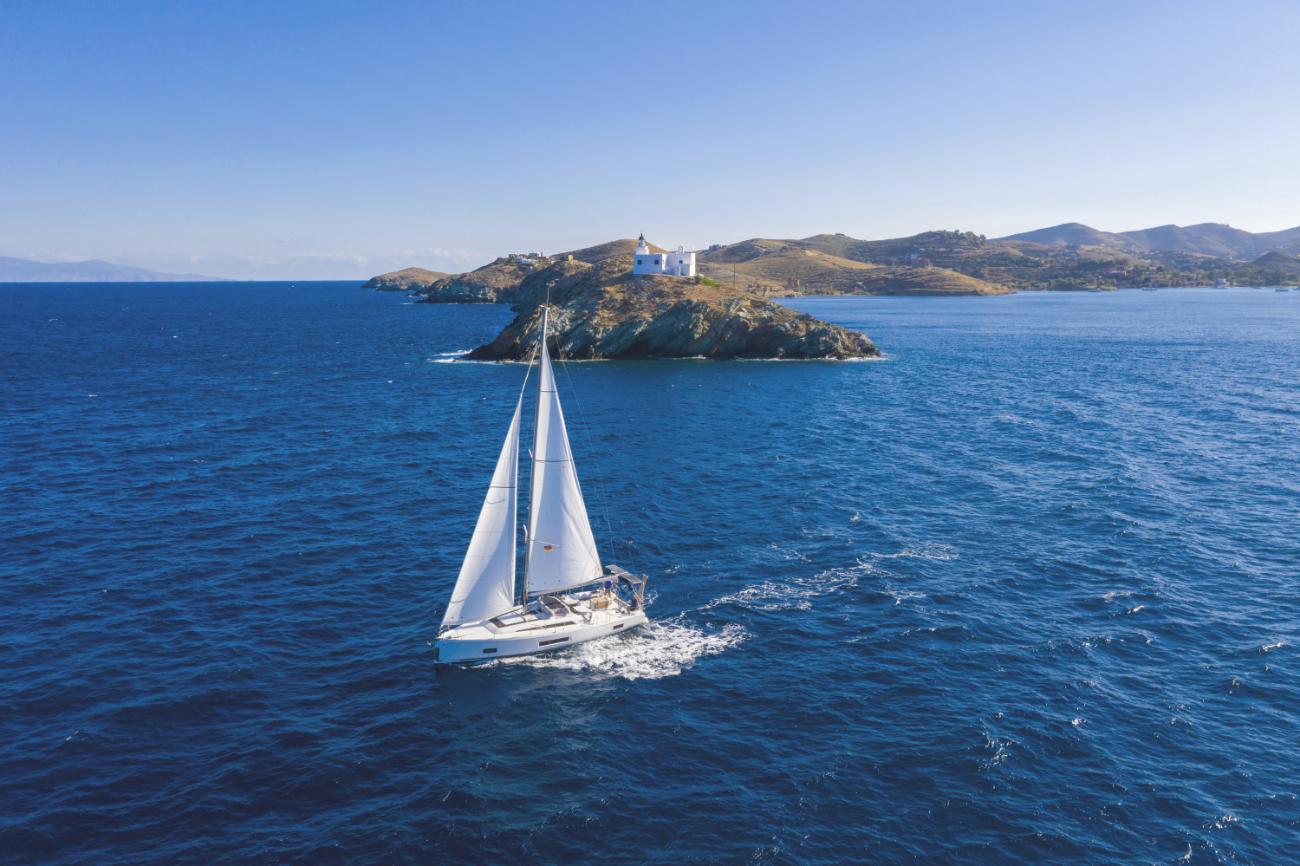
This route accomplishes the circumnavigation while stopping at beautiful places but doesn't necessarily explore everything that happens to be around. Its strong suit is the variability. If you like the Caribbean, you stop and cruise around there. If Australia excites you, you do the same there. If you want to see Madagascar, well, it will be almost on your way. And so on.
It has been a traditional route to take because it is relatively painless and does not go through any hazardous areas.
It has been traveled by many before you, so there is a lot of info floating around if you want to do your research on specific parts of the journey.
On its own, it has a lot of long legs where you will not see anything but the ocean on the horizon. So for those of you who mind this, you gotta make it your own, customize it a bit, so that you spend more time at places that you like.
This planning really is important. Some of those legs can't be made during certain seasons if you want to be careful, so to make sure you don't get stuck somewhere you don't particularly like, you should plan well.
With that, let's get crazier.
For those who want to do things the hard way. Perhaps you really like the scenery, perhaps you want to test yourself, or maybe you've done every other passage, and now it is time for the icy one.
There is a circumnavigation route that leads through regions so far up north you mostly don't encounter them even on a map. Because why would you look up there.
Now I don't know how long this article will survive on the internet, but note that this route is rather climatically contextual. Given enough time, it might freeze over and become unavailable.
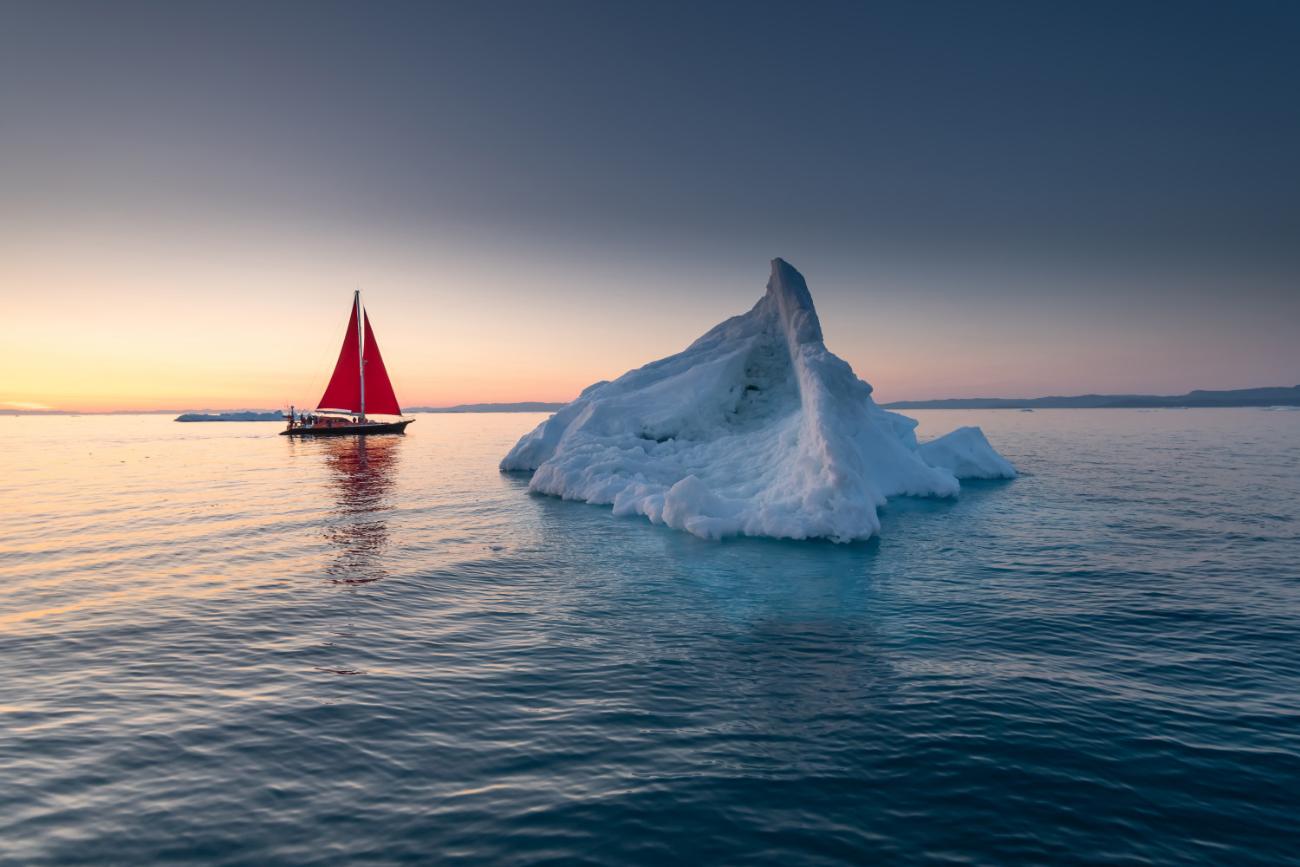
For me, it would begin in one of the northern ports of Norway and then:
- continue west to Iceland
- west to the south of Greenland and then up its western coast to the Baffin Bay
- south of Devon Island and through the archipelagos to Beaufort and Chuchki Seas
- west along the northern coast of Russia under the Lyakhovsky Islands
- west under the Yuzhny Island to the Barents Sea and back to the north of Norway
To this, you will have to add the most straightforward route north from wherever you are to any point on the route above.
Cold. Thus this requires clothing, equipment, and a boat that can withstand the polar temperatures along with chunks of ice floating around.
How much more adventurous can you get? Circumnavigation has been accomplished by plenty of people. This, not so much.
With the above, the major sailing routes have been covered. So what follows are mostly variations. Important ones, though.
Imagine this one mostly as the Traditional Route, except with a few twists. One of them leads through the Gulf of Aden, the Red Sea, and the Suez Canal.
Why take it? Because if you look on the map, you will see that when going from the general direction of Australia or Southeast Asia west, meaning you are probably aiming for the Azores or further for the Caribbean, it will save you a lot of time.
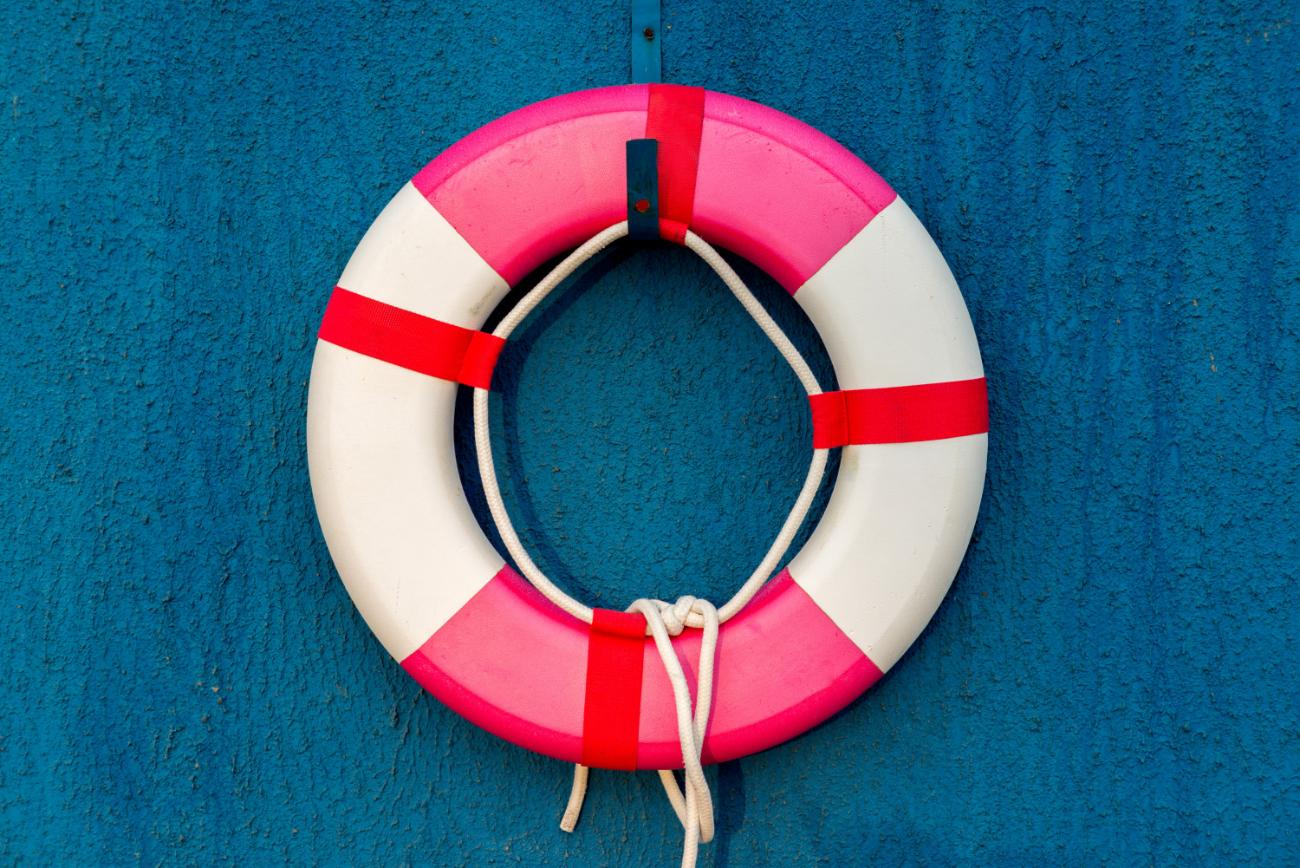
Money, not so much. You will have to pay for security. Because although you will save yourself the long southern route around the whole continent of Africa, which is nearly a 10,000-mile detour, you will have to go through the aforementioned areas that are famous for piracy and require professional armed company if you want to be on the safe side.
Not that it hasn't been done without it, but you know… Furthermore, many insurances won't cover you there since the risks are just too high.
Similarly, the area around Malaysia and the Philippines, which you might encounter during your Southeast Asia travels, bears the same story. No coverage by many insurances for piracy reasons.
Then again, exploring Southeast Asia while avoiding these regions means a few detours and no-go zones.
So if you want to explore the world on your sailboat and don't mind the risk, add these to your route plans.
Obviously, the risk or costs related to security. You will find plenty of sailors arguing that there is no real danger unless you are a cargo ship or a kidnapping worthy target. You will also find plenty who would rather travel in a fleet through there. And plenty who would never set sail towards those places.
Then there is the insurance issue.
With Suez, the upside is the saved time as well as not having to go around the treacherous South African cape waters.
With the Philippines and Malaysia, it's the convenience of being able to go wherever you want to in one of the most beautiful regions worldwide.
See this one as a variant of the Traditional Route and the Pleasure Route.
Some places are cheaper than others. And some places straight up make very little sense to go to.
Going through the Panama Canal is at least a $1,300 expense. Or, there are countries, like Ecuador, where check-in can cost you a $1,000 fee. And last but not least, prices of resources, like food, vary too. The Caribbean is famous for its steep prices in the provisions area.
The prices change, so it would not be bulletproof to give you a precise circumnavigation route exclusively through cheap places. Still, the moral of the story here is that when planning your route, do have a look at the local prices when it comes to check-ins and visas, food and various passes.
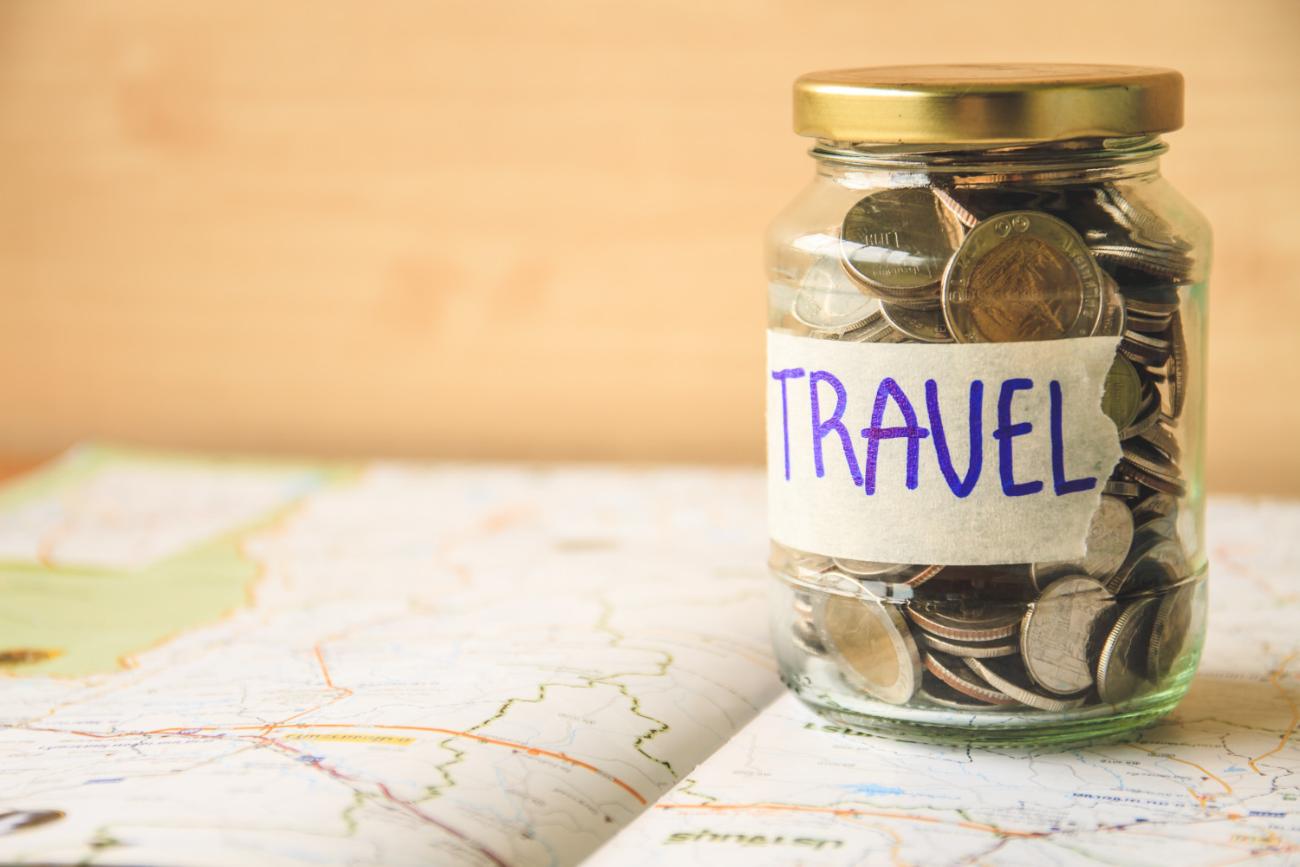
The result should be a route you are comfortable with financially. Avoiding the Panama Canal means a detour around the whole of South America, so it rarely pays off. Avoiding Ecuador, on the other hand, won't hinder your progress and save you money. Stocking up on food before getting into the Caribbean is also a sound logistical choice - unless you plan to stay for longer than your stocks can take you.
Saving money can mean detours, inaccessibility of various places, and more thought put into logistics. So it can result in a less elegant route.
On the other hand, being smart about it can result in a much lower bill overall.
Let me start this one by admitting that I don't believe anybody will actually take this route in its entirety, as delineated here. But it serves as an inspiration to those who are perhaps a bit unsure or simply like to combine two different sailing styles.
Some like to cross vast oceans and love to see nothing but the horizon for months. And then some like to stick to coastal waters for most of their journeys. Nothing wrong with that; at least it gives you something to look at any given moment.
And then there is the benefit of relative safety, a port or an anchorage close by most of the time, the ability to resupply whenever you like, to pick up and drop off people, and last but not least the lack of need for a really ocean-worthy boat and equipment.
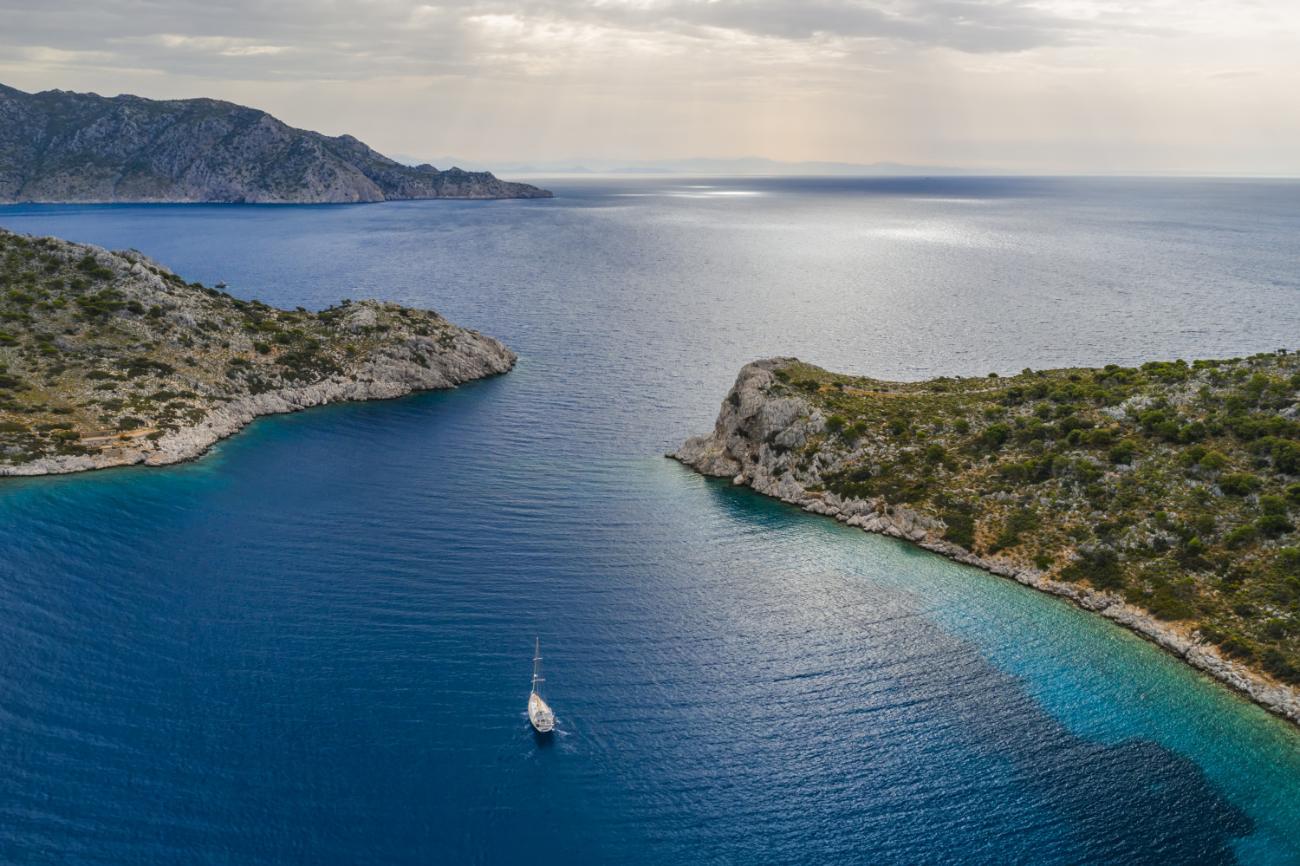
I'm talking about the coastal cruiser's dream of circling all the world's continents, whereby effectively circumnavigating the globe. Eventually. This is the longest route ever.
The idea is pretty simple. You can go around the world sticking to the coast with no crossings, except for the Norwegian Sea and a few short stretches in Southeast Asia.
Or, if you feel up to it (and want to avoid the freezing northern places), you can cross the Atlantic, the Pacific and keep close to the coasts otherwise.
As mentioned in the beginning, not many will actually take this entire route. But it is not uncommon for circumnavigators to have weeks or months where they do exactly this - stick to the coast and enjoy the country.
Lots and lots of time and resources are needed.
You will constantly be checking into countries and solving visas.
Understand the required paperwork for sailing the world This is an article on the topic of check-ins and paperwork, so have a read through it Read up on global licenses
Some areas are arguably less hospitable than others - the coast of Yemen as an example. So you might want to skip a few.
You don't need a proper ocean exploring boat - an island-hopping model will suffice. Many of the modern ones are capable of long crossings if needed here and there.
You don't need as much equipment as power, water, food, and all that jazz will be available most of the time.
The logistics will suddenly become a whole lot easier. Fewer provisions planning, less spare parts planning, broken stuff won't be a disaster… you get the point.
This is the true world tour.
I liked your article; it raised a lot of good points. I think the article could have benefitted from some maps.
I also think that, throughout the article, you have confused the Canary Islands or Madeira with the Azores. The Azores are not south from Gibraltor or France or Europe. They are 1/3 the way across the Atlantic Ocean, almost due west from Lisbon. The Canaries are south from Gilbrator, France and Europe and most people turn west there for the Caribbean.
Again, I liked the article.
Best wishes.
Leave a comment
You may also like, 41 sailboat cruising essentials for long trips.
In this post I list the items you are unlikely to have if you have never done bluewater or long-term cruising before. There are some essential safety product and …
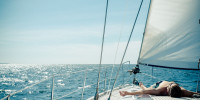
Everything You Need to Sail Around the World (by an expert)
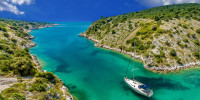
How Long Does it Take to Sail Around the World?
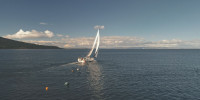
The Safest Sailing Routes Around the World (Which to Avoid)

How Big Should a Sailboat Be to Sail Around the World?

What Size Catamaran To Sail Around The World

Last Updated by
Daniel Wade
August 30, 2022
Catamarans are generally longer than monohulls, but their accommodations and handling vary widely between sizes.
The best size catamaran to sail around the world is 45 to 50 feet. The smallest catamaran with space for long-term provisions and a cabin is around 30 feet in length, and a 55 to 60-foot catamaran is the largest that can be accommodated at most marinas.
In this article, we'll go over the different sizes of catamarans and how they handle in the open ocean. Additionally, we'll cover each size category and the best sizes for traveling the Pacific and Atlantic Oceans.
We sourced the information used in this article from marine design guides and the consensus of experienced catamaran sailors.
Table of contents
What Sizes Are Catamarans?
Catamarans come in all shapes and sizes, but the smallest models don't have the accommodations required to sail around the world. Most catamarans under 30 feet in length don't have a cabin at all, which is a stark difference that they have with monohulls.
Small monohull sailboats often have cabins, as there's plenty of room below on a wide single-hulled sailboat. Monohulls can be as small as 16 to 18 feet and still have a cabin, but catamarans must be much larger to have suitable accommodations.
The smallest catamarans are about 12 to 15 feet long. These are small recreational craft used primarily for racing, and they aren't designed for the open ocean. Larger catamarans in the 20-foot range can (and have) been used on the ocean, but they're usually classified as day boats.
Catamarans become practical for longer excursions once they hit about 30 feet in length. A boat of this size is large enough for a cabin and can usually accommodate between two and four people comfortably. Catamarans commonly stretch beyond 50 feet, which is where they're the most useful and comfortable.
Smallest Catamaran to Sail Around the World
So, what's the smallest catamaran you could use to sail around the world? In theory, any catamaran can sail long distances—but you need one that's large enough for shelter and storing provisions. Generally speaking, 30 feet is the bottom limit for an ocean-crossing catamaran.
Let's take the ME Cat 30 (Maine Cat) as an example. This small and nimble 30-foot catamaran makes use of its limited space and provides comfortable accommodations for a few adults. The ME Cat 30 is a split design that houses the basic accommodations in either hull, with an open seating area between them.
Inside the ME Cat 30, there's barely enough room for all the living spaces. It features a head and a large bed in one hull and a galley and a smaller berth in the other. With that, all the useful cabin space is filled—and this is considered a very good design for the size. As you can see, the best catamarans for sailing across the world are usually much larger.
Typical Ocean Crossing Catamaran Size
Based on what we discussed above, a 30-foot cruising catamaran is really pushing the limits on size. However, it doesn't take a whole lot more length to make a catamaran exponentially more comfortable and suitable for long journeys.
The typical ocean-crossing catamaran is usually about 40 to 45 feet long. With the addition of 10 feet in length, designers can fit an enormous amount of additional accommodations in the hulls.
This is because adding a little extra length allows designers and boatbuilders to widen each hull significantly, which makes room for luxuries like private bedrooms, multiple bathrooms, and entirely separate dining and cooking spaces.
Cruising Catamaran Floor Plans
A 40-foot to 50-foot catamaran usually comes with a mirrored floor plan. The traditional catamaran has an identical layout in each hull. That means if one hull has a private berth in the bow and a shower and a toilet in the stern, the other hull will have the exact same layout except opposite.
This is usually because spaces like the galley and sitting area are kept in the center console, where there's much more space to move around. Spaces that are used at night or only occasionally are kept in the narrow hulls, as this has proven to be a more comfortable layout for crews.
Storage is usually kept deep in the hulls as well, as there's extra space to work with when the only other design purpose is for sleeping in bathing. Catamarans in this size range can also have separate hull layouts, but the mirrored design is by far the most common.
Best Catamaran Size for Pacific Ocean Cruising
Catamarans are very versatile craft, but some function better in the Pacific Ocean than others. One of the main considerations when choosing a catamaran for Pacific Travel is that the Pacific usually has greater distances between ports and stopping points.
This is especially true on the US West Coast, where there are only a handful of ports and safe anchorages. The best Pacific cruising catamaran size is between 45 and 50 feet in length, as you're likely to need more space to store provisions for extended cruising.
If you're starting in San Francisco or Seattle, even a 'short' trip along the coastline could mean you'll pass hundreds of miles of steep rocky cliffs and no stopping points insight. When crossing the Pacific, you may travel thousands of miles before you encounter a port or island with any infrastructure at all, let alone stocks of provisions and a full-service marina.
The Pacific is a huge ocean, and the last thing you want to do is run out of food or fuel a thousand miles from your destination. Larger boats store more supplies, and they also give you more breathing room when you're surrounded by empty blue water for months on end.
Best Catamaran Size for Atlantic Ocean Cruising
The Atlantic Ocean is smaller than the Pacific Ocean, and the coastlines of many countries that border it tend to be well-developed. This makes it easier to get away with owning a smaller boat, as you don't need to store as many supplies, and your voyages will be shorter.
Another factor to consider is that not all marinas on the Atlantic can accommodate extremely large catamarans, or it may be prohibitively expensive to dock a 55-foot or 60-foot double-wide vessel. That's why the ideal size for an Atlantic-crossing catamaran is between 40 feet and 50 feet. Today, 45 feet seems to be average.
The boat of this size will fit in at most marinas in developed countries around the Atlantic, and its draft is shallow enough for island hopping and exploring the coral reefs that the Atlantic Islands are known for. Additionally, 40 to 50-foot catamarans are usually just as seaworthy as the larger boats, and they're less expensive to maintain.
Unlike the US West Coast, where ports are few and far between, the Atlantic in the Gulf of Mexico is littered with marinas and safe anchorages. You can travel for weeks along the coastline of the United States and parts of South America and never be further than a hundred miles from a full-service marina.
There are also hundreds of islands, tourist destinations, and service locations that reduce your need for large stores of provisions aboard your catamaran. This gives you a lot more flexibility in choosing a size and a floor plan, as your needs are different than that of a Pacific sailor.
Best Catamaran Size for World Cruising
If you're planning to go on a world tour or a circumnavigation, you're going to need a catamaran that's large enough to fit your crew and your provisions comfortably.
You'll also need a boat that is small enough to be serviced and accommodated in most locations but also seaworthy enough to whether anything you're likely to encounter out of the water.
For most people, the sweet spot seems to be around 45 to 50 feet in length. A 50-foot catamaran is more than large enough to store enough provisions for many months of sailing. It's also roomy enough to house two to six people comfortably for many weeks at a time.
Catamarans between 40 and 50 feet in length are also extremely seaworthy and have been known to make circumnavigation frequently. You're almost guaranteed to find a 50-foot catamaran in almost any remote anchorage in the world where sailors are known to frequent.
Also, almost any marina can accommodate a 50-foot catamaran, and most boatyards can perform at least basic repairs on a boat of this size. Most marinas have fee schedules for boats based on size, and the cutoff for large boats is usually 60 feet. This keeps you in the 'medium' boat category, which can save you thousands.
How to Choose a Catamaran Size
Choosing the right size catamaran can be challenging, but there are a few things you can do to narrow it down. First, examine how you plan to use the vessel. You can travel the oceans in a catamaran between 30 and 40 feet long, so if you have a small crew, you may want to consider a compact model.
Larger catamarans can sleep eight or more people comfortably. This is large enough for most people, though some charter captains may need additional room. A 40 to 45-foot catamaran is usually large enough for a small family, though a 50-footer would be more comfortable, especially if there are kids running around.
Related Articles
I've personally had thousands of questions about sailing and sailboats over the years. As I learn and experience sailing, and the community, I share the answers that work and make sense to me, here on Life of Sailing.
by this author
Most Recent

What Does "Sailing By The Lee" Mean?
October 3, 2023

The Best Sailing Schools And Programs: Reviews & Ratings
September 26, 2023
Important Legal Info
Lifeofsailing.com is a participant in the Amazon Services LLC Associates Program, an affiliate advertising program designed to provide a means for sites to earn advertising fees by advertising and linking to Amazon. This site also participates in other affiliate programs and is compensated for referring traffic and business to these companies.
Similar Posts

How To Choose The Right Sailing Instructor
August 16, 2023

Cost To Sail Around The World
May 16, 2023

Why Do Catamarans Have Trampolines?
April 17, 2023
Popular Posts

Best Liveaboard Catamaran Sailboats
December 28, 2023

Can a Novice Sail Around the World?
Elizabeth O'Malley
June 15, 2022

4 Best Electric Outboard Motors

How Long Did It Take The Vikings To Sail To England?

10 Best Sailboat Brands (And Why)
December 20, 2023

7 Best Places To Liveaboard A Sailboat
Get the best sailing content.
Top Rated Posts
Lifeofsailing.com is a participant in the Amazon Services LLC Associates Program, an affiliate advertising program designed to provide a means for sites to earn advertising fees by advertising and linking to Amazon. This site also participates in other affiliate programs and is compensated for referring traffic and business to these companies. (866) 342-SAIL
© 2024 Life of Sailing Email: [email protected] Address: 11816 Inwood Rd #3024 Dallas, TX 75244 Disclaimer Privacy Policy
10 Best Catamarans in 2024

We gave our Sailing writers one job: Find the best and most popular catamarans and review them.
Our review team always considers durability, price, quality, and value in their reviews.

A catamaran is a sailboat that has a multi-hull design. It gives it more stability because it’s wider and that creates more livable space for more people.
Read about the best multihull boats in this article and learn which one is best for your voyages.
The biggest advantages of a multihull are:
- Multihulls are usually faster than monohulls, especially on downwind runs, reaches and broad reaches. You can travel further per day and outrun inclement weather
- They are more stable than a monohull. Sailing flat definitely has its advantages
- It is less tiring sailing a multihull
- More space!
- For cruising the draft is less than a monohull which means you can go into shallower water safely
Top 5 Catamarans in 2024
All the catamarans we've tested.
Lagoon Catamarans

Where to buy:
Where to buy lagoon 40:.
Lagoon has always enjoyed a sweet spot in the 38 to 40-foot catamaran market. The Lagoon 380 became one of the most popular cats ever, with nearly 1,000 hulls being produced over a 20-year run. The L400 and L39 attempted to tweak that popular design, but neither caught on to the extent the 380 did.
The new Lagoon 40 is turning heads for many reasons. The Lagoon 380 is officially off the Lagoon website, so it might finally be time for the torch to be handed to a new cat. And the 40 has just the right mix of modern features, small size, and affordability that many cruisers and families seek.
Here’s a go-anywhere boat that looks good, sails easily, and keeps you comfortable.
- Naval Architects: Van Peteghem-Lauriot Prevost (VPLP Design)
- Built: CNB Yards, Bordeaux, France
- Exterior Designer: Patrick le Quément
- Interior Designer: Nauta Design
- Length Overall: 11.74 m/ 38 feet, 6 inches
- Beam: 6.76 m/ 22 feet, 2 inches
- Draft: 1.35 m/ 4 feet, 5 inches
- Mast Clearance: 18.42 m/ 60 feet, 5 inches
- Sail Area: 80 square meters/ 861 square feet
- Engines: 2 x 29 hp Yanmar 3YM30 (upgradable to 45 hp)
- Fuel: 2 x 200 liters/ 56 gallons
- Fresh Water: 300 liters/ 76 gallons
- CE Certifications: A10/B12/C16/D20
Our Overall Review
Things we like:, things we don't like:.
Leopard Catamarans

Where to buy Leopard 42:
The Leopard 42 is the company’s replacement for the 40. It integrates several design elements that were proven on the new 50 and 45-foot models, including an upper lounge area atop the coachroof. The design also has the unique forward salon door that opens for direct access to the foredeck and a sun pad lounging area.
Like all Leopard catamarans, the 42 is not only comfortable to stay on, but it’s also fun to sail. All sailing controls lead to the compact helm. Everything can be handled from this one control station. The full-roach main and overlapping genoa provide plenty of power, and optional electric winches make sail handling a snap.
The Leopard 42 share company in the market for 42-foot cats with some very attractive boats–the Lagoon 42, the Bali 4.2, and the FP Astrea, to name a few.
- Year Launched: 2021 (There have been several designs to carry the "Leopard 42" name)
- Designer: Alex Simonis
- Builder: Robertson and Caine, Cape Town, South Africa
- Length Overall: 41 feet, 7 inches/12.67 meters
- Beam: 23 feet, 1 inch/7.04 meters
- Draft: 4 feet, 7 inches/1.4 meters
- Mast Height: 67 feet, 10 inches/20.68 meters
- Power: 2x Yanmar 45 hp diesel engines
- Fuel: 158 gallons/600 liters
- Water: 174 gallons/660 liters
- Holding: 44 gallons/ 166 liters
- Upwind Total Sail Area: 1,217 square feet/113.1 square meters
Catamarans-Fountaine-Pajot.com
Fountain Pajot 80 Catamaran Superyacht

Where to buy Fountain Pajot 80 Catamaran Superyacht:
Fountaine Pajot, one of the foremost builders of sailing catamarans, unveiled their biggest “ Super Catamaran ” ever: the Thira 80.
The release comes on the tail of an ever-increasing trend in the catamaran market—the bigger-the- better era . With Sunreef, Lagoon, and Gunboat all making boats in the 70 to 80-foot range, these companies clearly see a market for the catamaran superyacht.
Boats this size are easily comparable to a motor yacht of more than 125 feet long. The very wide beam provides cavernous interiors for more livable space. And they have plenty of room for the toys of the trade—tenders, jet skis, paddleboards, and more.
While sailing is always preferable, its 175 to 300-horsepower engines are more than capable of moving it on calm days. And it’s hard to beat the ride and comfort of a catamaran at sea, with its extra stability and lack of heeling in the wind.
So, is bigger really better? Let’s dive in and tour the new Fountaine Pajot 80 and all that she has to offer.
- Length: 78.7 feet/23.98 meters
- Beam: 36.4 feet/11.09 meters
- Draft: 6.9 feet/2.10 meters
- Displacement: 66.0 tons (approximate)
- Sail area Main: 2,153 sqft/200 sqm Genoa 1,507 sqft/140 sqm
- Power options: 2x 175-hp, 270-hp, or 300-hp
Kinetic Catamarans
Kinetic KC54

Where to buy Kinetic KC54:
The Kinetic may be fresh on the scene of the Super Cats but it is on the cutting edge of the finest fast craft in terms of performance and latest technology while also having features, impeccable finishes and the amenities of stylish cruising.
This has been awarded the Cruising World Best Large Multihull 50ft and Above Boat of the Year 2022 as well as the Special Recognition Award – for Overall Excellence 2022 by Sailing Magazine. Said Gerry Douglas of Sailing Magazine: ‘This was the Tesla of sailboats…in terms of design and execution and technology, it hit all three of those marks. This boat is built without compromise’.
These catamarans are all-carbon construction, an aggressively lightweight construction and set up for short-handed sailing. Mast is coachroof mounted and there are options for centreboards and daggerboard. There are three steering stations (two outside aft on each hull, one inside right behind the working cockpit) to suit weather conditions and personal preference.
- Length: 54 ft 2 in
- Beam: 27 ft 7 in
- Draft: Dagger Boards down 10.2 ft
- Standard Rudder up 4.5 ft
- Capacity: 3 or 4 double berths (6-8 persons)
- Motor: 2 x Yanmar 4JH80 - 80hp Diesel SD80
- Fuel Capacity: 264 gal
- Mast height: 85.3 ft (above water)
- Mainsail area: 1,102 sqft
- Fresh Water tank: 264 gal
Xquisite Yachts
Xquisite X5 Plus

Where to buy Xquisite X5 Plus:
2022 saw the Xquisite X5 named the Cruising World magazine’s Best Cruising Catamaran of the year – yet again (it won the Best Multihull over 50ft award in 2017) .
As Ed Sherman said: ‘There are 40,000 man-hours invested in this boat. And you can see it.’ To the bolts that are torqued to the 2 weeks spent with each new owner training them on systems – this is a strong product, well designed by Rudolf Jonker and built by Phoenix Marine incorporating all of Tamas Hamor’s ideas and experience. This really is a well thought out 53 ft cruising sailboat and is another South African-built catamaran loaded with important details, not only the visible ones.
The goal for Xquisite is to supply fully equipped catamarans for long-term live-aboard cruising with comprehensive lifetime service assistance for the owners.
There are so many features from the gutters to catch rain-water on the coachroof to footswitches for the electric winches at the helm. Solid handrails all around the deck for maximum security to the below deck running-rigging network! In terms of the design and construction much thought has gone into weight saving. There is no faulting the systems installations.
All lines lead to the helm through below deck channels that are easily accessible with winches well thought out. The helm is slightly raised to port under a bimini with a sliding fully-battened canvas roof that is easily raised and lowered. There is an overall ambiance of space and light in the berths and galley which opens onto the cockpit.
Sailing performance was impressive with its powerful rig – however a heavy, low-slung cruising cat with keels instead of boards to get to your destination in comfort and style.
See our complete list of the best catamarans here .
- Length: 53 ft
- Beam: 26 ft 2in
- Draft: 4 ft 4’
- Capacity: 3 double berths (6 persons)
- Motor: 2 x 80 HP Yanmar
- Fuel Capacity: 208 gal
- Mast height: 78 ft 7’ (above waterline)
- Mainsail area: 1,130 sqft
- Fresh Water tank: 227 gal
McConaghy Boats
McConaghy MC60

Where to buy McConaghy MC60:
The MC60 is the fastest and most luxurious flybridge catamaran. ‘Think next-gen fighter jet meets a New York style luxury loft apartment.’
McConagy boats was founded by John McConaghy in 1967 and in 2000 Mark Evans & Jono Morris embraced the opportunity to take over the country. They partnered with Tiger Group Investments and have grown from strength to strength – building the world’s fastest racing yachts , submarines, components for Formula One racing and developing solutions for architects, scientists and others. They have a proven track record on complex composite products which are lightweight, corrosion resistant, have design flexibility, durability and high strength.
In the MC60, designed and engineered with safety as priority, this performance sailing meets stylish living with only finest wood veneers and luxurious materials throughout – the wide saloon which offers a versatile but spacious living area, large windows and retractable glass doors aft, a galley well positioned best suited to socialising. The attention is to detail and innovation even in the storage solutions so that living space is maximised with semi-customisation of interiors too. She is the perfect blend of sophistication and high tech.
Sailing is in utmost luxury, effortlessly and safely due to meticulous control of weight. She is much lighter than other similar length cats and can approach cruising speeds close to true wind. A professional crew are required. For sailing there are dual helm positions on the streamlined flybridge for best sight lines. The precise hull forms achieve optimum strength to weight ratio with careful use of carbon which means that under full sail she points upwind like a monohull. The M60 has push button centerboards that raise on impact automatically – certainly one of the safest offshore performance catamarans .
- Length: 60 ft 04 in
- Beam: 28 ft 2 in
- Draft: 4 ft 7 in with centreboards up
- 12 ft 4 in with centreboards down
- Capacity: 2 double berths & 1 - 2 twin (6 - 8 persons)
- Motor: 2 x 57 HP
- Fuel Capacity: 123.19 gal
- Mast height: 92.85 ft
- Mainsail area: 2,034 sqft
- Fresh Water tank: 123.19 gal
Sunreef Yachts

Where to buy Sunreef 80:
Winner in the 2019 Oceanway China Yachts Award, the 2019 Yacht and Aviation Awards and claiming Best of Show Award in the 2020 Miami International Boat Show this mighty fine catamaran justly deserves all and more. It is an all-round sailing leisure yacht for exclusive getaways, charter and transocean adventures and is set up for professional crew.
The Sunreef is built in Poland under management of Founder and CEO Francis Lapp who has been producing large vessels from 50-165 ft since 2002 and knows well what semi-custom cruising is all about.
The Sunreef 80 fuses contemporary design with its layout flowing easily one into another area in ultimate luxury. Custom finishes ensure that you have found your ultimate catamaran – the vast central lounging space with panoramic view opens both onto the bow and cockpit. The cleverly designed bridge deck and superstructure facilitates the superior comfort onboard.
The spacious 54sqm flybridge is the epitome of leisure – a jacuzzi, wet bar, barbecue and large sunpads with the main boom well clear overhead ! It also houses all the navigation. Plenty of relaxation and pleasure space.
The sail controls are well laid out for the twin helms with carbon masts built by Sunreef themselves. The rig is built for power on this well equipped and luxury sailing vessel.
The tall bow has a fine entry aimed at reducing drag while the hulls are designed to reduce drag too while having super volume to accommodate the luxurious cabins are airy and impeccable in style. The master cabin is located midships starboard and is an opulent space while the other cabins each have queen sized beds, spacious en-suites and unquestionable privacy.
- Length: 80 ft
- Beam: 37 ft 7 in
- Draft: 7 ft 218 in
- Capacity: 4 - 5 double berths plus optional crew of 3 (8 - 10 persons plus crew max of 3)
- Motor: 2 x 280 HP John Deeres
- Fuel Capacity: 634.01 to 1585.03 gal
- Mast height: 2185 ft
- Mainsail area: 2152.78 sqft
- Fresh Water tank: 422.68 gal
HH Catamarans
HH50 cruiser

Where to buy HH50 cruiser:
The HH50 is a performance cruiser for the blue water with simple to use but intelligent systems, carbon construction and to top it all luxurious and spacious interior. She offers to best of all worlds – easy to manage sailing vessel which is robustly built, fully equipped and stylishly comfortable for your adventure.
The sailing systems and deck layout are designed for short-handed sailing with dual helm stations each giving the helmsman total sail control from either side and having excellent visibility. The C daggerboards are curved and are fully retractable. Push button mainsheet and self-tacking jib are standard. Equal-to-Wind speed is normal, this is a performance sailing vessel.
The large saloon has a good sized galley and when at anchor the sail handling area converts easily to a comfortable forward facing seating area. The aft cockpit has an integrated wet bar and barbeque – perfect for al fresco entertaining or dining. Luxury queen size beds await in the cabins.
- Length: 51 ft 8 in
- Beam: 24 ft 41 in
- Draft: 5 ft 43 in Board down
- 10 ft 83 in Board up
- Capacity: 2 double berths and 1-2 single (4 - 6 persons)
- Motor: 2 x Yanmar 40HP
- Fuel Capacity: 131.98 gal
- Mast height: 75 ft 36 in
- Mainsail area: 873.28 sqft
- Fresh Water tank: 87.99 gal
Excess Catamarans

Where to buy Excess 11:
This gem earned the title of Cruising World’s Boat of the Year 2021 impressing the judges with its allocation of space all the while offering superior sailing performance. All at a great price.
Using compact space effectively – effectively and seamlessly assimilating working and social areas in a thoughtful, pleasant, workable and innovative way. This is a sure winner for the Excess 11.
The Excess 11 is one of the smallest catamarans as well as the only large-scale production boat of this size, with comfort, space and thrilling sailing. She is comfortable in her simplicity and light style. It is very capable for long passages and meets the needs for life on board, built on the experience of previous models and designs.
Even with her smaller size she offers comfort on deck with a large open cockpit and twin helm stations.
Complete Excess 11 standard features list please email via website
- Length: 37 ft 5 in
- Beam: 21 ft 7 in
- Draft: 3 ft 9 in
- Capacity: 3 - 4 double berths (6 - 8 persons)
- Motor: 2 x 29HP
- Fuel Capacity: 106 gal
- Mast height: 56 ft 8 in
- Mainsail area: 592 sqft
- Fresh Water tank: 79 gal
Bali Catamarans
BALI Catspace

Where to buy BALI Catspace:
The BALI Catspace is the most successful catamaran in her class with the Catspace being the smallest of the BALI range, combining all the latest innovations in cruising. It was nominated for the Cruising World’s best boat of the year: Catamaran under 50 ft, 2022.
The Catspace was conceived by Olivier Poncin & designed by Lasta Design – combining all the latest innovations in cruising into a really neat vessel.
The sailing quality is not to be faulted for a catamaran of this size, the deck which is efficient for sailing allows smooth movement from the aft platform to the forward cockpit with lounge and sunbathing area. There is, in addition a full-comfort flybridge which has a safe relaxation area and a helm station which is designed for single/short handed use.
The 4 cabins each have private heads and the ability to open up the back end of the cats to create the indoor/outdoor platform is well planned and highly effective.
Complete Catspace standard features list
- Length: 40 ft 39 in
- Beam: 21 ft 59 in
- Draft: 3 ft 91 in Boards up
- Motor: 2 x 20HP up to 2 x 40HP
- Fuel Capacity: 107.78 gal
- Mast height: 58 ft 56 in
- Mainsail area: 1,087 sqft
- Fresh Water tank: 167 gal

Big ‘blue water’ Sailing
Blue water sailing refers to the open sea. Non-blue or pond sailing refers to inland waters and coastal areas.
The difference in specific design of a blue water or non-blue water vessel is for the ship captain’s visibility as well as based on the hazards of the area they are to be used. A bluewater (offshore) catamaran is designed for voyages in very rough seas. They are usually 40ft or longer, designed to be very stable, carry heavy loads and very safe. Ocean sailing has different dangers to coastal water with different challenges – sailing through storms, longer distances, more maneuvering space, night sailing – and more gear, better technology, skills and sturdier vessels are needed.
When sailing in confined waters it is important to have more reactive steerage, less maneuvering time, you do not need to store multiday provisions as you are more reliant on daytime sailing, do not need so much speed so have smaller sails and lower horsepower engines and perhaps the intention if for pleasure alone so one of the major considerations will be the layout of the vessel.
For most sailors the choice of size is between 40-50 feet which is manageable for 2 persons with lots of room to spread out and entertain or have friends on board and that is easy to dock both in terms of space and cost.

First questions to ask yourself
First up consider these 5 points before you decide on your multihull model, length and manufacturer.
Will you be using your sailing vessel for coastal or blue water adventures? What is your primary objective and then: is this for family pleasure or entertaining or Charter?
For sailing
Must it be suited for single-handed sailing? What proficiency of sailing do I have/need? Degree of technology required? Equipment required?
Functional Use
How many berths do I need? How much privacy? Elegance, comfort and style – what is required? Space for ‘toys’? If for charter or private use with crew – extra berths.
Your total budget must include the initial cost of the vessel plus survey, transport, upgrading of equipment, insurance, etc – there is a lot to consider. Would a second hand vessel be a consideration? What is the smallest I can go?
Annual Costs
What will my ongoing budget be for Insurance, berthing, maintenance, repairs, haul out fees, etc? This excludes any travel costs
Where do I want to berth my vessel? Or living aboard?
It is said that BOAT is an acronym for: Break Out Another Thousand!

Review of Our Favorite 15 Multihulls 2024
With cutting edge technology and the strive for sail performance this was no easy task – there are many deserving vessels who deserve to be in the Top Reviews such as Privilege 510, Outremer 51, Knysna 500SE and the St Francis 50. There are also other models by manufacturers we have selected that have proven themselves over the years that may be a better size for you.
Here’s our listing!
Related Reviews
Read full review
Final Thoughts
Multihull vessels have a lot of the potential for creature comforts that motor yachts have without the constant thrumming of the engines. But they still require a modicum or rudimentary understanding of sailing.
There’s also a bit of maintenance required, but this is something–like having kids–that you figure out along the way.
Another popular boating segment is the power catamaran. Like their sailing counterparts, power catamaran boats have great living space, but without the need to understand sailing principles. Either way, both multihull markets look to be growing in popularity over the next many years.
The resale market for multihull ships also looks promising, so getting one, trying it out for a couple of seasons and selling it again is a possibility without losing too much on the purchase price.
Before you sign the cheque….
So you’ve located some a catamaran for sale that looks promising. It’s one of the models on the list here and you’re wondering if its in the best shape relative to the price. Here’s what you do:
Take time out to go and view it in person. Book yourself an experience aboard and head over to your closest marina and speak to owners (this may well help you create your shortlist too). Consider these points before purchasing:
- Pre-book buyer’s sea trials for your shortlist
- Select the perfect sailing vessel for you (and if it’s for your family make sure they agree too!)
- Used – get a certified hull survey, safety comes first
- Get annual insurance quotes
- Calculate dockage – purchase or rent a slip or dock
- Calculate monthly upkeep and maintenance
- Calculate extra costs like navigational devices & fittings
- Draft your own checklist
- Draft & sign off sale & purchase contracts
- Draft & sign off a Memorandum of Agreement (MOA)
- Ensure you are satisfied 100%
- Execute payment and take transfer of ownership
- Register and insure your vessel
Check all necessary Stock is aboard – Sail away!
Pre-Departure Checklist
Some ideas for you –
- Always pre-check the weather and wind conditions prior to any excursion on the water
- Always know the tide table in your head, so you know what the ocean is doing at all times, incoming or outgoing tide, and what is the tidal range if you are in an ocean estuary or channel.
- Check you have fuel, water, food and all the basics before loading passengers aboard, and follow these easy steps to ensure safety is first at all times.
- Plan your upcoming voyage, does it feature high swells, rocky shores, and cold water
- Check Safety equipment, making sure you have enough life jackets for all sea-farers
- Check sails, sheets and lines. All sailing gear
- Check your engines – Open fuel lines, check oil and spark plugs
- Check fuel tank levels and have extra fuel aboard for an emergency
- Start the motor, make sure water is coming out to cool the motor
- Test both forward and reverse gears on the engine before guests board
- Check that you have a working and full battery communications radio, with all correct channels programmed, and that all the vessel lights and electrics are in working order
- Check for first aid kits , manual hand pump, paddles, lifejackets , additional lines, fresh drinking water and food for passengers plus some spare in case your voyage is longer than expected, necessary repair tools & kit and flags
- Strap any equipment and gear down safely before you start to motor
- If you have passengers boarding, ensure you give a proper safety briefing and point out where all the safety gear is on the vessel. Children should be included in the briefing and be secured properly before departure
Catamarans versus Trimarans
Trimarans have limited space in slimmer hull designs generally. This makes Catamarans with their comfortable open leisure space both above and below deck far preferred for leisure sailing.
On the plus side for Trimarans are their speed and seaworthiness.
How Safe are Multihull Boats at Sea?
Probably a close second in terms of questions asked. On a twin hull design the buoyancy is on the outer edges of the boat and their is greater stability and less rolling when drifting or trolling compared to a monohull.
Catamarans are safe in rough seas because of their wide stance which makes them stable with increased motion comfort and excess buoyancy due to lack of ballast. They are easy to maneuver and with high speeds that may help them outrun storms with skilled crew who know the vessel. A trimaran is the safest of multihulls with the 3 hulls, centering of its weight and anti-drift plan. The righting torque between a catamaran and trimaran is significantly different.
An important consideration is this – if your catamaran is anything longer than 45ft, unless specifically modified for single handed sailing, then it probably cannot be sailed alone. At some stage in your journey you may well have to sail alone – can it be done?
As Blue Water Sailing Vessels
Catamarans are more stable and fast and depending on conditions some can distance more than 200 miles in a day.
Cats usually sail faster than monohulls (standard) due to the weight of them and displacement, especially on a run or broad reach when the sails are perpendicular to the wind. There are many variables to consider.

Solo Sailing a Multihull
Most small and medium-sized cruising catamarans can be sailed single-handedly. The skill of the sailor with high tech equipment such as electric winches and powered sail control, layout (such as all lines to the cockpit, roller furling mainsail, autopilot, etc) and safety precautions make it an adventure not to be missed.
If your catamaran is longer than 45ft, unless specifically modified for single-handed sailing, you will not be able to safely sail it alone. Consider:
- What the minimum length of the vessel would suit your needs to handle on your own
- Layout planning is essential
- Space you need
- The bigger the boat means larger sails which will be harder to raise and repair
- The bigger the boat means more power and speed – be comfortable with your vessel
- Update your sailing skills
Finding the Right Size
It is a very personal choice but at the very least the advice would be to buy the smallest catamaran you think would meet your needs – this is because you have many other costs to consider and the bigger the vessel the more the costs of upkeep, dockage, space for crew.
A perfect size for blue water sailing (including around the world) is around 40 ft, small enough to be sailed by one person but big enough to provide safety and speed. The smallest size to consider to cross the ocean safely and in some comfort by consensus is around 30ft. Any smaller and you will possibly have the following problems as dealing with large seas the size of your vessel does count :
- A smaller vessel is always pitching and yawing and this impacts the crew negatively over a long period of time or in crisis situations
- Low bridge deck clearance due to the small size of the vessel
- when sailing upwind the waves are projected with speed and force into the decks understand (between the pontoons) creating bridge deck slamming. This vibration and noise impacts the crew and is very tiring – sailing downwind to prevent this may not be where you want to go
- Not having enough space for all the supplies and equipment needed for a long passage
- Alongside the problem of weight to be carried is the problem of distribution of this weight over the length of the vessel safely
Multihulls best for ponds, slow rivers and calm bodies of inland water benefit from having flat hulls to provide shallow draft with great deck space manufactured from aluminium or fibreglass. Make sure you take extra food and water and all safety supplies just in case of an emergency!
The question everyone wants to know – how much does it cost to live onboard?
There are many variables depending on your lifestyle, where you intend to cruise or berth and how much you want to travel aboard. A good estimate would be between US$2000-US$5000 per month for a family of 4, a little less for a couple/single person plus the maintenance cost of your boat which is on average 5-10% of the cost of the boat. The maintenance of your boat varies depending of equipment, age, condition and size.
What do I need to consider differently to live on-board rather than racing ?
Racing vessels are designed for speed and exhilaration and safe fun.
Living on-board requires space and comfort – space for storage, large-sized comfortable berths, living space, entertaining space, home-space! You need to know your long term goals and what your personal needs are – do you need a dedicated work area or desk space/permanent interconnectivity for work?
Generally cruising catamarans have wider hulls which give you more space as well as creating more drag which slows your boat down and is more costly on fuel.
Many used charter boats are seen as great purchases for living on-board, however make sure that they are suited for blue water sailing and not only for coastal water.
Here’s a list of the Top 15 best Multihulls reviewed in this article:
- Leopard Catamarans – 41 ft 7 in – Leopard 42
- Balance Yachts – 48 ft 26 in – Balance 482
- Kinetic Catamarans – 54 ft 2 in – Kinetic KC54
- Xquisite Yachts – 53 ft – Xquisite X5
- McConaughey – 60 ft 1 in – MC60
- Sunreef Yachts – 80 ft – Sunreef 80
- Leopard Catamarans – 50 ft 6 in – Leopard 50
- Voyage Yachts – 57 ft 42 in – Voyage 590
- Seawind – 52 ft 8 in – Seawind 1600
- HH Catamarans – 52 ft – HH50
- Fountaine Pajot – 39 ft 14 in – Isla 40
- Lagoon-Beneteau Group – 38 ft 5 in – Lagoon 40
- Excess Catamarans – 37 ft 2 in – Excess 11
- Maverick Yachts of SA – 44 ft – Maverick 440
- Chantier CATANA – 37 ft 5 in – Catspace
Frequently asked questions about Catamarans
This varies greatly, often defined used or new by the design, size, year and finish. Quality vessels are built to last and retain market-related value if undamaged.
On average a 45-foot catamaran can range from US$250,000-US$1,000,000.
The fully loaded Isla 40 costs around US$527,000. The Balance 42 sail away price fully cruise equipped is US$1,450,000 while the Kinetic 54’s price tag approaches US$3,000,000. The modern styled Sunreef 80 costs around $6.2 million.
We think that the Seawind 1600 is, for its size and quality, a superb priced performance product at US$900,000.
One of the major benefits for a cruising vessel is to be able to enter shallower seas – catamarans have a shallower draft than monohulls and therefore a great appeal to folk for whom this is a major consideration. Most lagoons are only 6-8 feet deep in the South Pacific. The Caribbean and other areas where you have reefs to navigate and shallow sandbanks to cross to enter overnight anchor stops draft is a very important consideration. Always remember to read your tide tables and swell.
A catamaran is lighter on the water and therefore takes less energy to move, however they have 2 engines which drives up fuel costs. They are more fuel-efficient on flat water (compared to equal horsepower and number of engines) but in heavy weather the monohull’s hull design causes less resistance and therefore higher efficiency.
With lighter weight and high buoyancy generally they have low water drag by comparison to the displacement of a monohull of the same length.
The trampoline serves many purposes – primarily to allow water to quickly pass through, allowing the bow to rise and so preventing the vessel from flipping and they are ideal for pleasure purposes.
To sail around the world the vessel needs to be equipped for offshore cruising and have a heavy load capacity.
The bigger Modern blue water cats are built with this in mind – supplies, crew, technology and gear.
A bigger boat has many advantages such as speed (not only to travel longer distance in shorter time but also to outrun potential bad weather) and comfort space, space for crew and friends, storage space for supplies and fun equipment, etc.
It is important to balance price against comforts, maintenance and repair costs as well as any potential income from your vessel (chartering, Air BNB, hosting courses on-board, etc) – generally here the bigger your vessel the higher the potential for greater income.
The larger your vessel the higher your expenses are in all ways – from Insurance to berthing, maintenance, haul out fees and equipment.
On this page
Table of content:, breadcrumbs.
- / Catamarans
Continue reading

Kingfisher 3025 GFX

Women’s Life Vest

Airhead Mach 2 Tube

Onyx MoveVent Dynamic
Gallery of catamarans review.

Three sailboats racing in the Indian Ocean

- Waterproof Backpacks
- Duffel Bags
- Hiking Backpacks
- Waterproof Gear
- Teepee Tents
- Camping Chairs
- Heated Socks
- Marine Binoculars
- Night Vision Goggles
- Windbreaker Jackets
- Collapsible and Folding Wagons
- Portable Power Stations

- Dive Computer
- Scuba Diving BCD
- Scuba Regulators
- Freediving Fins
- Underwater Scooters
- Diving Wetsuits
- Women’s Wetsuits
- Scuba Diving Drysuits
- Rebreathers
- Liveaboards
- Dive Destinations
- Best Underwater Cameras
- Waterproof Cameras
- Kids Wetsuits
- Snorkel Fins
- Scuba Diving Masks
- Snorkel Masks
- Full Face Diving Mask
- Full Face Snorkel Masks
- Prescription Dive Masks
- Prescription Snorkel Masks
- Seiko Dive Watches
- Best Dive Knife
- Dive Lights
- Underwater Metal Detector
- Reef Safe Sunscreen
- Scuba Tanks

- Paddle boards (SUP)
- Best Touring Paddle Boards
- Best Beginner Paddle Boards
- Motorized paddle boards
- Electric SUP Pumps
- Paddles For Paddle Boarding

- Beach Chairs
- Beach Umbrellas
- Beach Wagons
- Beach Tents
- Beach Canopy
- Beach Towels
- Beach Blankets
- Water Shoes
- Water Socks
- Boogie Boards

- Swimming Goggles
- Swimming Fins
- Swimming Earplugs
- Women’s Swim Shorts
- Getting into Sailing
- Boat Brands
- Life Jackets
- Marine Flares
- Waterproof Marine Radios
- Pontoon Boat Accessories
- Sailing Gloves
- Boat Fenders

- Inflatable Kayak
- Folding Kayaks
- Tandem Kayaks
- Sit On Top Kayaks
- Sea Touring Kayaks
- Ocean Kayak
- Pedal Kayaks
- Fishing Kayaks
- Kayak Life Vests
- Kayak Shoes
- Kayak Paddles
- Kayak Trailers
- Kayak Anchors
- How to Choose a Kayak – A Beginner’s Guide
- How To Choose a Kayak Paddle? [What You Need to Know]
- Kayaking Gear for Beginners
- What to Wear Kayaking
- Kayak Safety

- All Mountain Snowboards
- Snowboard Boots
- Snowboard Bindings
- Snowboard Helmets
- Snowboard Jackets
- Atomic Skis
- Blizzard Skis
- Ski Resorts in the US

- Travel Backpacks
- Weekender Bags
- Packing Cubes
- Suitcases and Travel Luggages
- The Best All-inclusive Resorts in the World

- Men’s Yoga Pants
- Yoga Shorts
- Yoga Mat Bags
- Yoga Blocks
- Laptop Backpack
- Mini Backpacks
- Mesh Backpacks
- Clear Backpacks
- Fanny Packs
- Water Bottles

- Waterproof Jacket
- Waterproof Pants
- Waterproof Watches
- Waterproof Headphones
- All Liveaboards
- Liveaboards in Australia
- Liveaboards in Fiji
- Liveaboards in French Polynesia
- Liveaboards in Micronesia
- Liveaboards in Myanmar (Burma)
- Liveaboards in the Maldives
- Liveaboards in the Philippines
- Liveaboards in Egypt
- Liveaboards in Costa Rica
- Liveaboards in Belize
- Liveaboards in Mexico
- Liveaboards in the Galapagos Islands
- Aggressor Liveaboards
- Liveaboard in Thailand
- Liveaboards in Indonesia
- Best Dive Sites in the World
- Best Dive Resorts in the World
- Central & South America
- North America
- Southeast Asia
- Indian Ocean
- Asia Pacific
- Middle East & Red Sea
- The Best Starboard Paddle Boards: A Brand Guide
- Bluefin Paddle Boards: A Brand Guide
- Isle Paddle Boards: A Brand Guide
- Red Paddle Co. Ride 10’6
- ROC Paddle Boards: A Brand Guide
- The Best iRocker Paddle Boards: A Brand Guide
- Blackfin Paddle Boards
- Pontoon Boats
- Bowrider Boats
- Motor Yachts
- Cabin Cruiser Boats
- Inflatable Boats
- Electric Surfboard
- Efoil Board
- Jet Body Boards
- All-Mountain Skis
- Ski Bindings
- Ski Poles for Downhill & Touring
- Ski Goggles
- Ski Gloves and Mittens
- Ski Jackets
- Ski and Snowboarding Pants and Bibs
- Ski Helmets
- Best Resorts in North America
- Whistler Blackcomb Ski Resort
- Copper Mountain Ski Resort
- Mammoth Mountain Ski Resort Area Review
- Jackson Hole Ski Resort
- Telluride Ski Resort
- Aspen Ski Resort
- Crested Butte Ski Resort
- Kirkwood Ski Resort
- Alta Ski Resor
- Park City Ski Resort
- Winter Park Resort
- Breckenridge Ski Resort
- Vail Ski Resort
- Snowmass Ski Resort
- Heavenly Ski Resort
- Taos Ski Valley
- Palisades Tahoe Ski Resort
- Ski Santa Fe
- Angel Fire Ski Resort
- Sun Valley Ski resort
- Killington Ski Resort
- All-Inclusive Resorts in Aruba
- All-Inclusive Resorts in Belize
- All-Inclusive Resorts in Cabo
- All-inclusive resort in Cancun
- All-Inclusive Resorts In Costa Rica
- All-Inclusive Resorts in Cozumel
- All-Inclusive Resorts in Hawaii
- All-Inclusive Resorts in Mexico
- All-Inclusive Puerto Rico Resorts
- All-Inclusive Resorts in Tulum
- All-Inclusive Resorts in Turks and Caicos
- All Liveaboards in Thailand
- Liveaboards in the Similan Islands
- All Liveaboards in Indonesia
- Liveaboards in Komodo
- Best Diving in the Caribbean
- Diving in Guadeloupe
- Diving in Aruba
- Diving in Antigua and Barbuda
- Diving in the Bahamas
- Diving in Barbados
- Diving in Bonaire
- Diving in the British Virgin Islands
- Diving in Cayman Islands
- Diving in Cuba
- Diving in Curacao
- Diving in Dominican Republic
- Diving in Grenada
- Diving in Jamaica
- Diving in Martinique
- Diving in Puerto Rico
- Diving in St. Maarten
- Diving in St. Lucia
- Diving in Tobago
- Diving in the Turks and Caicos
- Diving in Belize
- Diving in Costa Rica
- Diving in the Galapagos Islands
- Diving in Mexico
- Diving in Roatan Honduras
- Diving in California
- Diving in Florida
- Diving in North Carolina
- Best Diving in Southeast Asia
- Diving in Thailand
- Diving in the Philippines
- Diving in Indonesia
- Diving in Vietnam
- Diving in Cambodia
- Diving in the Maldives
- Diving in Australia
- Diving in Japan
- Diving in Fiji
- Best Diving in Europe
- Diving in Mallorca
- Diving in Malta
- Diving In Denmark
- Diving in Egypt
- Women’s Life Vest
- Pennsylvania
- All-Inclusive Resorts in Playa del Carmen
- All Diving in Mexico
- Diving in Cozumel
- Diving In Similan Islands – Khao Lak Area
- Diving in Malapascua
- All the Diving in Indonesia
- Diving in Bali
- Diving in Gili Islands
- Diving in Komodo
- Diving in Sulawesi
- Diving in Raja Ampat
- All Diving in Australia
- All Diving in Japan
- Diving In Brothers Islands
- Things to do in Sacramento
Paddle boarding
Everyday Life
- BOAT OF THE YEAR
- Newsletters
- Sailboat Reviews
- Boating Safety
- Sails and Rigging
- Maintenance
- Sailing Totem
- Sailor & Galley
- Living Aboard
- Destinations
- Gear & Electronics
- Charter Resources
- Ultimate Boat Giveaway

Sailing Across The Atlantic In A Catamaran
- By Sheryl and Paul Shard
- Updated: June 13, 2018
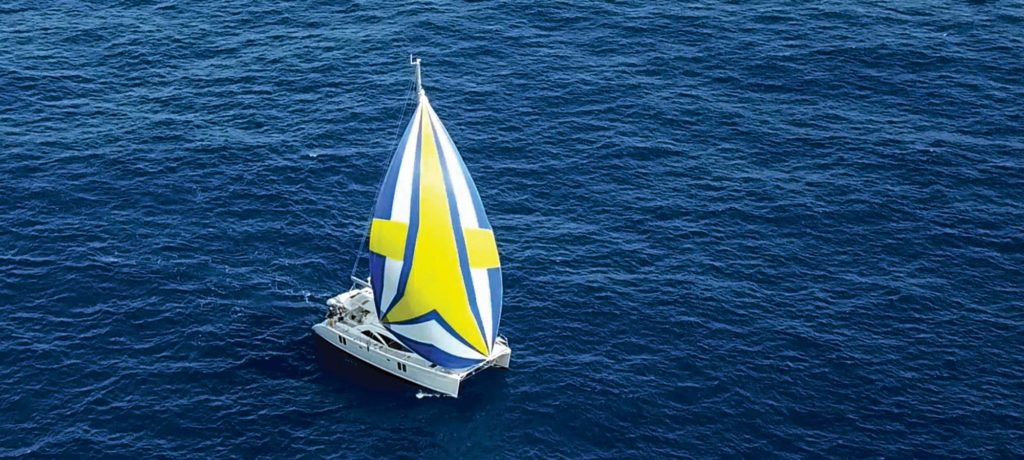
Monohull or multihull? Have you ever gone back and forth pondering the pros and cons of cruising on each? We certainly have, so when my husband, Paul, and I were given the chance to deliver a brand-new Bluewater 50 catamaran across the Atlantic from Las Palmas, Gran Canaria, in the Canary Islands to St. Lucia in the Caribbean last winter, we jumped at the chance. Paul and I have been cruising and living aboard since 1989 and have sailed more than 100,000 nautical miles on the four boats we’ve owned over our nearly three decades of global voyage-making. The boats were all monohulls, but every time we bought a new one, we toyed with the idea of moving to a catamaran. Why? We discovered that we enjoy shallow-draft sailing, which most multihulls offer, as much as we love offshore passagemaking. For long-term living aboard, the space offered aboard most multihulls is certainly attractive. We were proud of our first boat, Two-Step, a Sparkman & Stephens design called the Classic 37, but after a while, we found her depth restrictive as we discovered how much we enjoyed gunkholing and navigating through small inland waterways. Cruising had become a lifestyle for us, and we wanted more space on board plus a few more comforts. Paul and I feel blessed since, as independent television producers and travel-documentary filmmakers, we are able to earn our living while sailing full time, but all the camera, audio and editing equipment we need to carry takes up a lot of storage space. We needed to expand.
The criteria for our next boat was a good shallow-draft design with safe and comfortable offshore capabilities, so multihulls were definitely under consideration. In the end, we stuck with what we knew and ended up choosing a monohull with a swing keel, a configuration that has suited us on our cruising journeys for many years.
Although we are now in the process of building our new boat, a Southerly 480, we continue to be intrigued by catamarans. Feeling out of sorts being “between boats,” we chartered a Voyage 50 catamaran in the British Virgin Islands to get a much-needed sailing fix in the tropics, and spent the time with friends aboard. It was a luxurious boat, with four en-suite cabins with queen berths, and was set up well for chartering, but we wondered what a catamaran this size would be like for serious ocean cruising. We were soon to find out.
Discovery Yachts builds several brands of high-quality cruising yachts, including Southerlys and Bluewater catamarans, and the company reached out to us with an opportunity to deliver a new Bluewater 50 called Zão (pronounced zay-oh by the owners) from the Canary Islands to the Caribbean, leaving Gran Canaria in early November. Zão ‘s owners, John and Caroline Charnley, highly experienced sailors and the newly retired former owners of Discovery Yachts, had family and business commitments until Christmas but wanted the boat moved to the Caribbean so they could enjoy a winter of island-hopping before going through the Panama Canal. They asked us if we would take the boat across to St. Lucia for them. Seeing this as a great chance to sail a purpose-built 50-foot offshore cruising catamaran to learn how it performed on an ocean passage in the many conditions we were sure to encounter on a 2,800-nautical-mile Atlantic crossing, we accepted the offer.
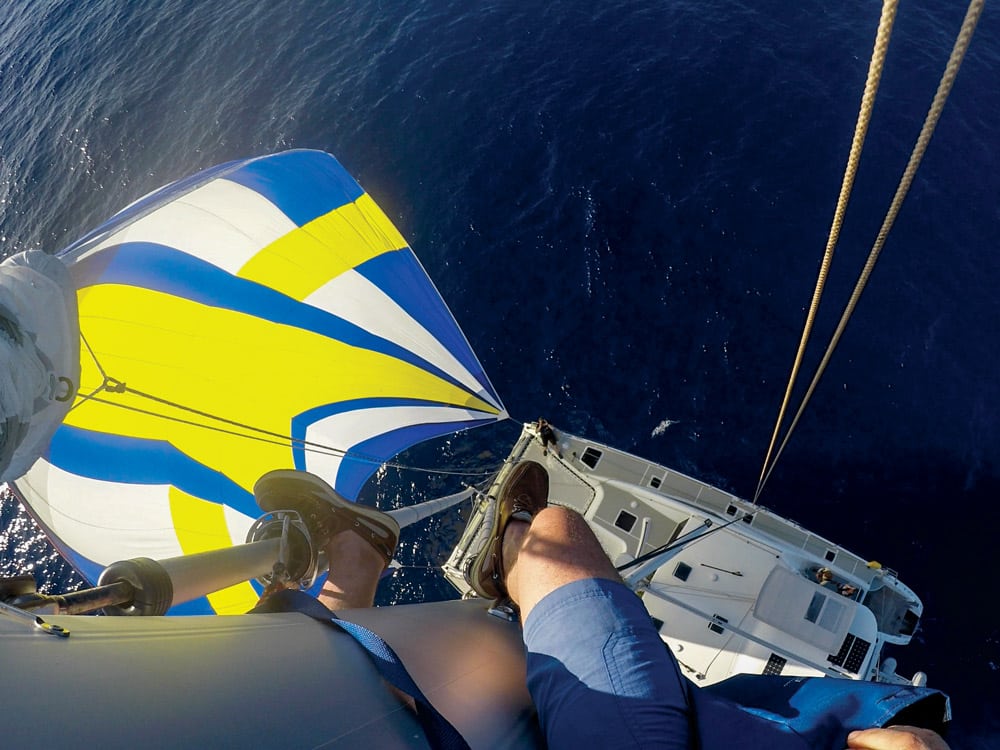
We flew to the Canary Islands the first week of November 2017 to meet up with John and his new Bluewater 50 in Las Palmas. Soon to join us would be four friends as crew, all fellow sailing bloggers and videographers — Alexandra Palcic and David MacDonald of Sailing Banyan ; Dan Krughoff, professional chef and videographer; and sailing vlogger and police officer Craig Bowman, of Cruising Off Duty . All were monohull sailors with some catamaran experience, mostly through chartering. Dave and Alexandra lived aboard their boat in the Caribbean, having sailed from Canada several years ago. Dan and Craig were each in the market for a catamaran for full-time voyaging.
November is a popular time to make the east-to-west crossing of the Atlantic Ocean because hurricane season is officially over and you arrive in the Caribbean in time for Christmas, a nice time to start a winter of exploring the islands. More than 200 boats participating in the Atlantic Rally for Cruisers were descending on the marina in Las Palmas to begin preparations for their ocean run to St. Lucia, as were many other independent non-ARC cruising boats and crews, so it was a crazy, busy, festive place at that time of the year. Las Palmas has one of the best marinas in the Canary Islands for sailors since every supplier and service needed for yachts preparing for an ocean crossing can be found there.
Seeing Zão at the dock when we arrived in Las Palmas was such a delight. Her long, swooping modern lines were a contrast to the more angular-shaped catamarans gathering in the marina. What a difference from the 50-foot cat we had chartered earlier, which, in fairness, was set up purely for vacationing. Zão was designed for long-term living aboard and long-haul passagemaking. This was the second Bluewater catamaran the Charnleys had built, so they had thought through every detail for comfortable living in their retirement but also set the boat up for serious adventure on their upcoming around-the-world voyage.
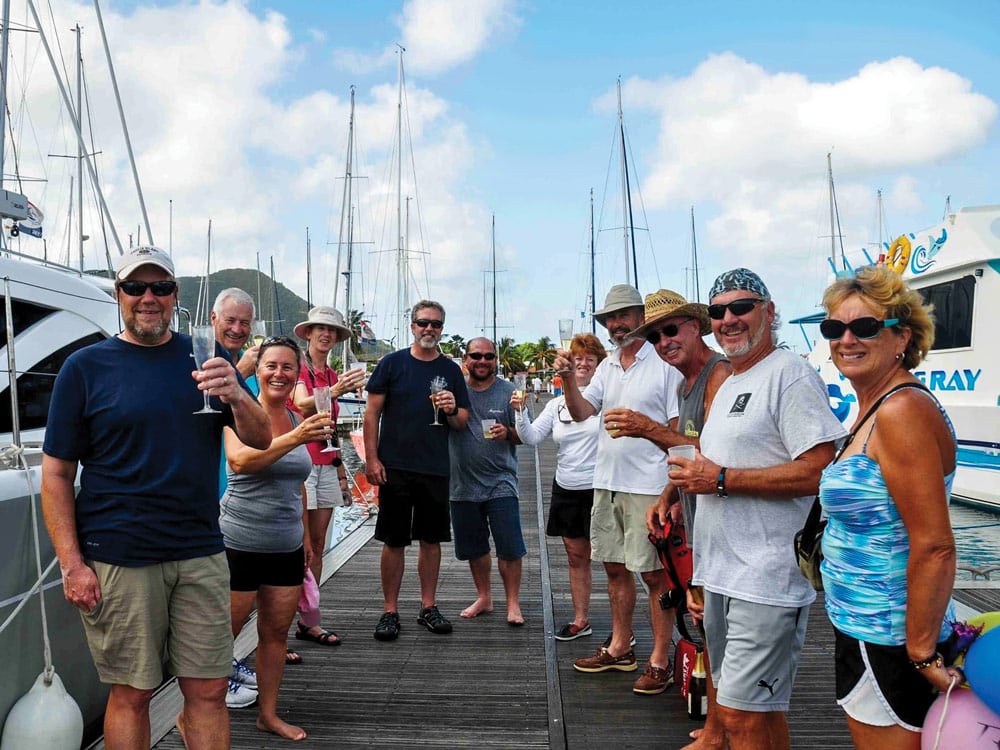
When Paul and I stepped on board, the first things we noticed were the fine table lamps and two free-standing lounge chairs in the main saloon, neither of which appeared to be bolted down. As monohull sailors, this made us nervous.
I asked John about how these were to be stowed offshore. He just smiled.
“You’re on a catamaran now. They will just sit here for the whole passage. You don’t have to stow things the way you do on a monohull,” he assured me. “You can even move the chairs around to watch the large-screen TV.” He continued to grin. This was going to be a very different passage compared to what we’re used to.
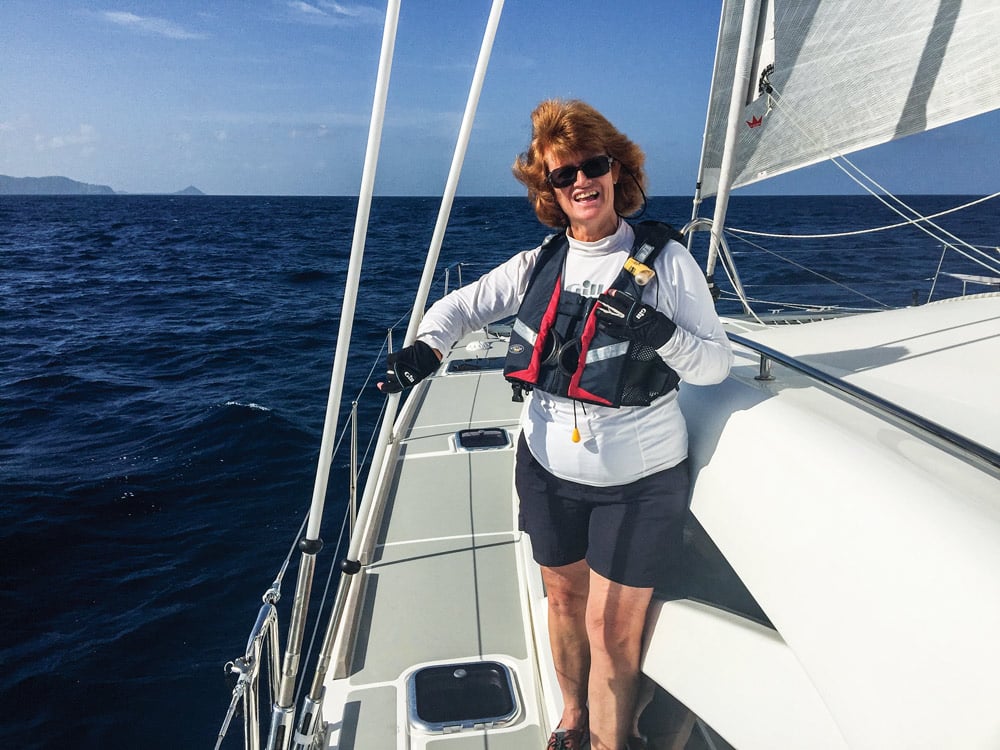
Paul and I had gotten somewhat comfortable with leaving things sitting on tables and countertops while sailing on the catamarans we had chartered in the past, but in the British Virgin Islands we were sailing in the comfortable confines of the protected Sir Francis Drake Channel, not on the open sea. John showed me how the chairs were positioned on the floor with mere strips of Velcro and how the heavy table lamps sitting around the main saloon and navigation station were sitting on nonskid mats. I still wasn’t convinced that once we got some serious waves at sea these things wouldn’t go flying.
The next thing I noticed, as one who loves to cook, was the expansive galley on the bridgedeck, with an all-around view and opening windows into the cockpit. There were large, easy-to-clean Corian countertops, including a peninsula countertop that you could work at from three sides. There would be six of us aboard, and although Alexandra, Dan and I would be sharing most of the meal preparations, everyone liked to cook and would be pitching in, so it was nice to see that there was space for all of us to work.
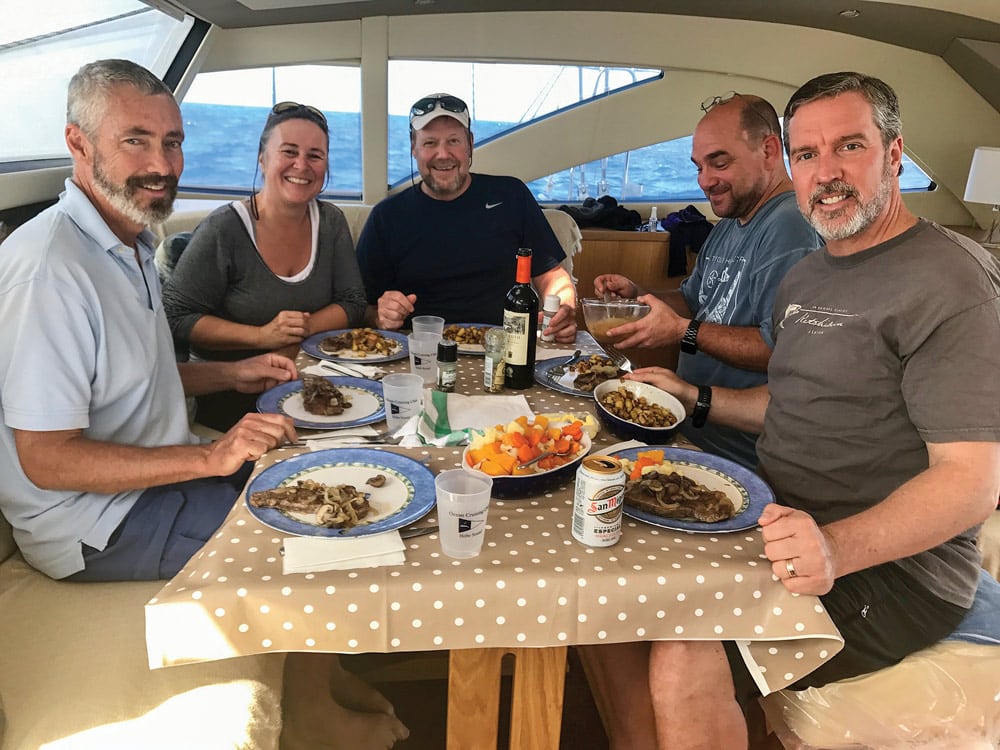
To add to our culinary creativity, there were a four-burner propane stove and oven, a microwave and a large front-opening fridge with two additional fridge/freezers in the owners hull to port. These had exterior temperature monitors and alarms. There were also numerous cupboards for storing supplies, so stowing our provisions was going to be a breeze!
Then Paul noticed a high-powered electric kettle.
“The electric kettle is just for port, right?” asked Paul.
“No, you can plug in this kettle anytime, even at sea,” John told us. “It’s the only one we’ve got or use.”
Paul looked skeptical, thinking of the power drain. Then John explained the electrical system — a hard Bimini the width of the cockpit, covered with solar panels; a 6 kW generator; and a large lithium battery bank. Right. The kettle wasn’t going to be a problem.
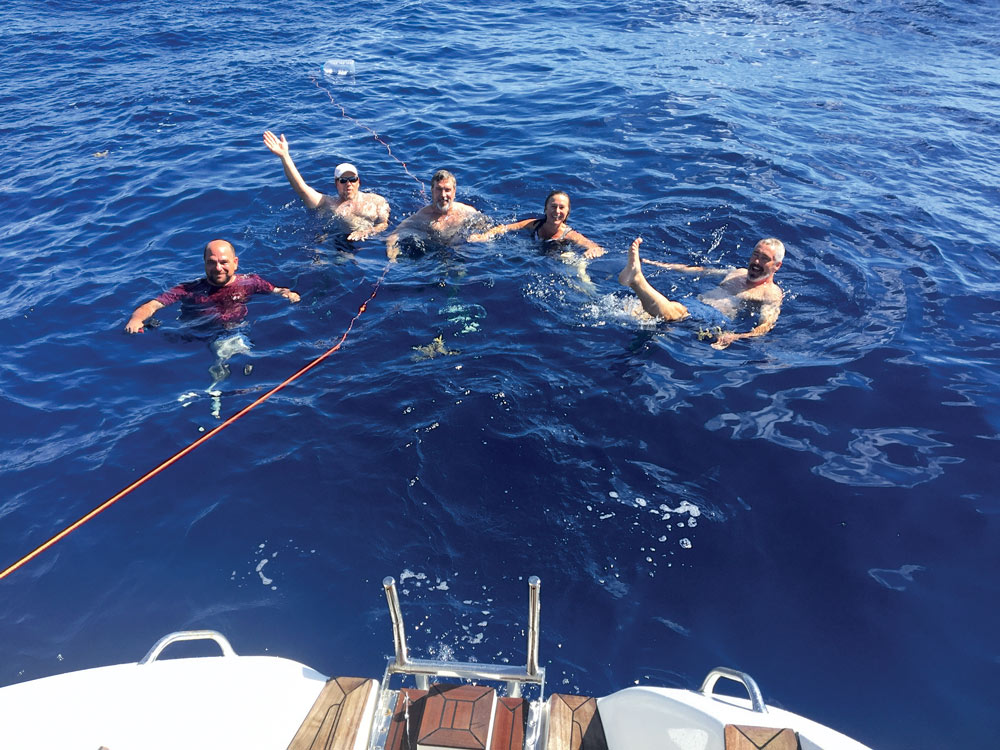
Paul and I made our home in the owners cabin, which featured a queen bunk aft and a head with separate shower and front-loading washer/dryer at the forward end. There were two other en-suite cabins on the starboard side. Dave and Alexandra took the queen berth aft. The forward cabin had a V-insert in the berth, which was removed to make twin bunks for Dan and Craig.
As soon as the crew was settled in, Alexandra and I began the mammoth job of provisioning for a crew of six people with help from Dan and Craig. Dave and Paul went over the boat’s systems with John, organizing repairs, doing maintenance and ensuring that everything was in good working order and that we understood the equipment before leaving for sea. Dan set up and tested our Iridium Go/PredictWind satellite and weather-routing system, and became our communications officer. Everyone pitched in whenever and wherever help was needed.
Alexandra is an impressive organizer and rearranged the contents of all the lockers for ease of access while we were underway, taking notes so we could return things to where John and Caroline had put them. She grouped all like items together, and put things close to where they would be used and where it would make the most efficient use of storage space. Then we started stowing bags and boxes, bottles and cans, long-life cartons of juices and milk, baskets of fresh produce, freezers full of frozen meat and shellfish, pizzas, berries and desserts. Since everyone on board was a foodie, this was not going to be a beans-on-toast cruise across the Atlantic!
This was our eighth transatlantic passage, and it turned out to be the lightest-wind Atlantic crossing we have ever made, with several days of total calm. Where were the trade winds?
Because we’re monohullers who don’t worry too much about weight on a boat, Zão was a bit heavy when we set sail from Las Palmas on November 12. An advantage, though, of a large cruising catamaran is that the boat can handle it, and as we were about to find out, we would be at sea for a lot longer than the two weeks we had planned on.
Fortunately, water usage wasn’t a concern either. Dave ran the generator twice a day during his and Alexandra’s 0800-to-1200 and 2000-to-2400 watch, and made plenty of water with the Dessalator watermaker at the same time. All six of us could have had two showers a day if we’d wanted to — and often did.
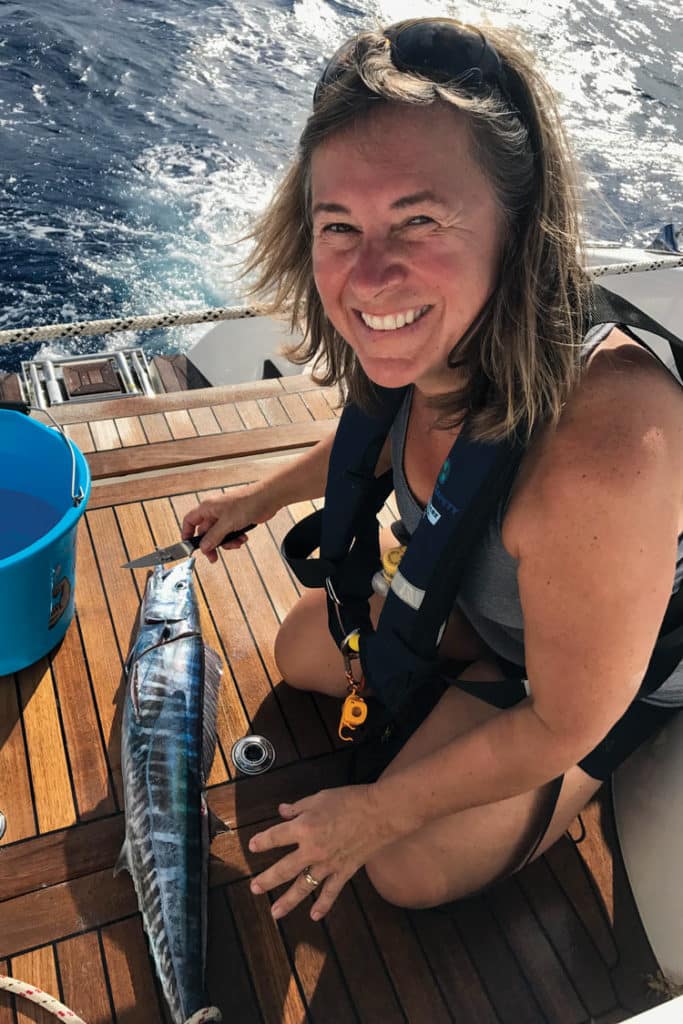
We had light but good breezes the first day out, which helped everyone get their sea legs and allowed us all to get used to the equipment on board and practice handling Zão ‘s sails. The boat has Elvstrøm Epex laminated sails, which hold their shape and work well with the Seldén in-mast furling system. It took us a few tries to get the hang of the furler, so we appreciated Craig’s instruction on how to use it. He has it on his boat. The trick is to maintain tension on the mainsail at all times while furling it. We came to love it and, as a result, we ordered the same for our new boat.
One of the things we didn’t like about the other catamarans we had sailed was the noise of the waves slapping the bridgedeck, which was loud and never rhythmic. It got on our nerves, so Paul and I were rather anxious about how we would handle this on a long passage. However, on the Bluewater 50, the hull shape was designed to counter this, and we found that startling wave slaps happened less often and weren’t as loud or bone-shaking when they occurred. Granted, we never got the big seas we had been hoping for to test out the boat.
This was our eighth transatlantic passage, and it turned out to be the lightest-wind Atlantic crossing we have ever made, with several days of total calm. Where were the trade winds? Like all the other boats around us (we were receiving position reports from the ARC and ARC+ fleets), we all ended up being at sea for at least an extra week longer than planned.
We checked the weather using PredictWind a couple of times a day, and there was nothing but days of extremely light wind or no wind at all in the forecasts. The Bluewater 50 is a fast cat and, thank goodness, handled the light airs well, but we never got the conditions to really put her through her paces.
We started by sailing wing-and-wing using two headsails but ended up flying the asymmetric spinnaker day and night, doing two-person watches around the clock just to keep the boat moving. We all got pretty good at sail trim. When the wind dropped, we doused the sail and, mid-Atlantic, had a swim 1,000 miles away from the closest land. We fished. We cooked. We ate. We slept. We celebrated Thanksgiving. Alexandra baked cakes. We read. We danced. There was lots of room. We chased birds off the deck, which must have mistook us for an island. We shouted with delight when dolphins came to play. Craig flew his drone. We saw amazing sunsets and shooting stars. We played cards, which included a three-week Wizard tournament. We watched TV. Had pizza-and-a-movie nights. We left our cameras and computers lying around. Were we on a boat? It was way too comfortable.
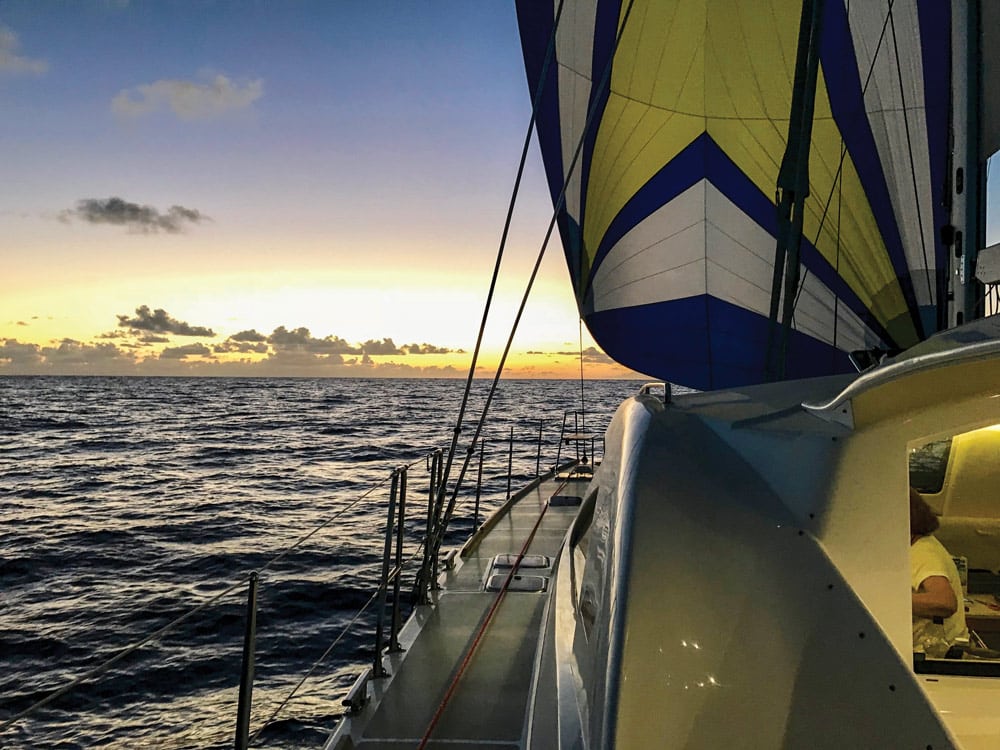
One thing I noticed about passagemaking on a multihull is that I had much more energy than when I go to sea on a monohull. Not being on a heel all the time means it doesn’t take as much physical effort to do simple tasks. Overall, everyone in the crew felt the same. We also dealt with tasks more readily since it didn’t take much effort to get up and deal with things.
Unfortunately, or fortunately, this applied to cooking. We were constantly preparing meals and feasting. No one lost weight as we usually do on a monohull passage, where you sometimes eat minimally since food prep and eating just feel like too much effort at times.
On December 3, 21 days and 3,000 nautical miles after setting sail from Las Palmas, Gran Canaria, we made landfall in St. Lucia. The boat felt enormous as we came into Rodney Bay Marina, but with the twin Yanmar 80 hp diesel engines, we could turn on a dime. Twin screws make even large multihulls easy to maneuver. We were greeted by the happy owners, John and Caroline.
So, have we become multihull converts? Well, we can definitely see the advantages now and understand why for some sailors they are a good choice for cruising. It all comes down to what works for each of us. After all, it’s love for being on the water that all cruising sailors share — be it on one hull or two.
Sheryl and Paul Shard have been living the cruising dream for nearly 30 years. Together they have traveled more than 100,000 miles under sail, including eight Atlantic crossings. Learn more about the Shards’ adventures and their TV series, Distant Shores, on their website .
- More: atlantic , bluewater sailing , canary islands , catamaran , discovery yachts , monohull , multihull , Sailboats , st lucia
- More Sailboats

Alubat Updates OVNI Models

For Sale: Little Harbor 63 Ketch

Sailboat Review: Fountaine Pajot Aura 51

A Superyacht Approach at Southerly Yachts
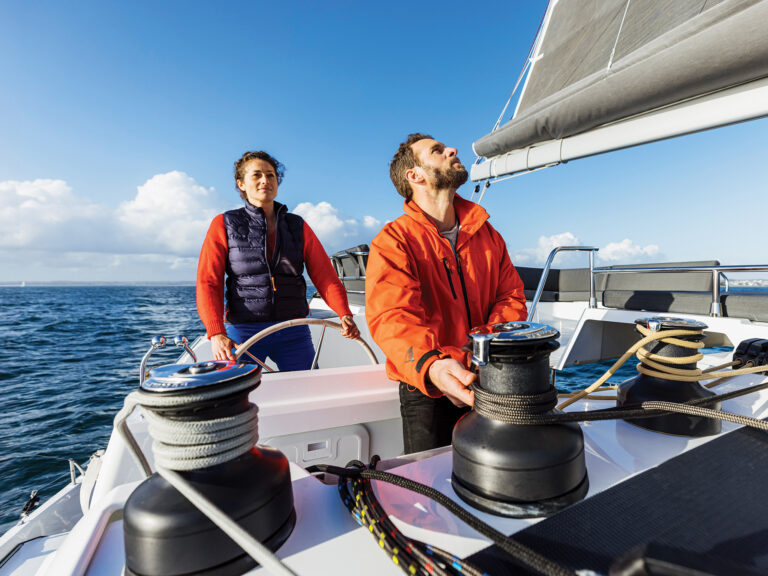
Introducing Bitter End’s Beach Bungalows

Off Watch: School Daze
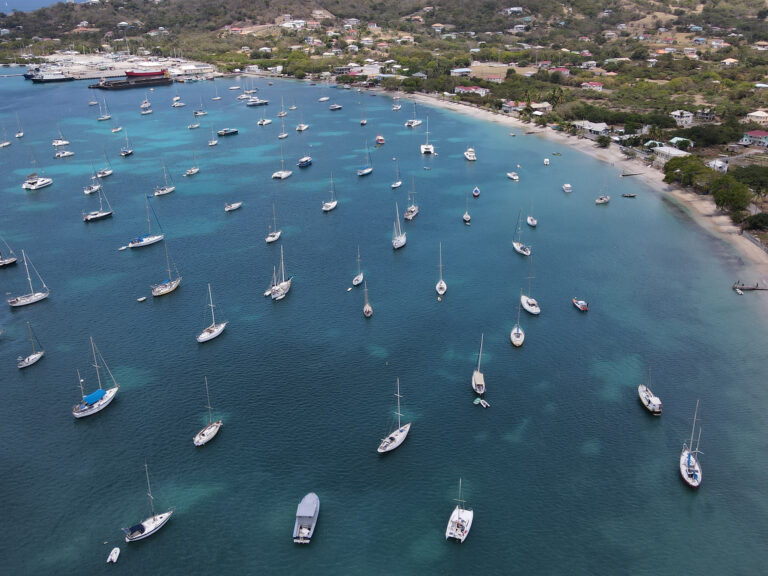
Paradise Pummeled
- Digital Edition
- Customer Service
- Privacy Policy
- Terms of Use
- Email Newsletters
- Cruising World
- Sailing World
- Salt Water Sportsman
- Sport Fishing
- Wakeboarding

What Size Catamaran to Sail Around the World

Table of Contents
Anyone who knows you says this trip is already long overdue. The ocean is calling out to you and has been for a long time now. You’re more than ready to sail the seven seas. In fact, you’re virtually dying to do so. But first, you need to pick out a catamaran — moreover, one that is the correct size not merely for getting you around the world, but also for serving all your needs, wants, and goals on your trip.
You need to find the catamaran that will make all your trouble worth it. This seems simple enough, but as you begin your search, you quickly discover that there are so many (too many) options out there. Now you’re probably wondering, “Which size is right for me?” and “How do I figure this out?” In this article, we will break down how to choose what size catamaran to sail around the world with.
Some consider catamarans sized at 35 feet to 45 feet to be the best for ocean sailing. Many consider 45 feet to be the sweet spot when it comes to picking out a catamaran for trips around the world.
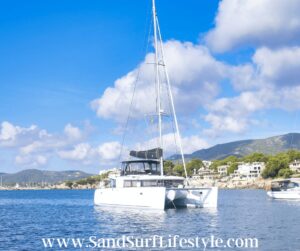
1) Basic comfort, speed, and circumnavigation of the vessel.
2) The amount of “cargo” you’ll have on the catamaran — in other words, the essential stuff needed in order to actually make your catamaran run, how many passengers will be on board, what it is you plan to do while on board, which items will be involved in making this happen, and how much space will be required for these activities.
3) Your budget in regards to catamaran size and, even more importantly, safety.
4) The actual measurements of the catamaran: 20 feet to 30 feet, 35 feet to 45 feet, and 50 feet to 60 feet being among the most popular sizes.
As we already stated before, the best catamaran size for a journey around the globe varies on a case-by-case basis. It depends entirely on your needs, wants, and intentions while out at sea. Nonetheless, the most important thing for everyone — new and seasoned sailors alike — to recognize while settling on a catamaran size is that it is never too early to consider anything and everything that might play a role on your trip. Every little thing matters, and the sooner you factor something in, the better you can plan for your voyage. This should also optimize the amount of fun you’ll have while on board.
Remember — it’s always better to be overprepared for the ocean than underprepared for it. Being underprepared while at sea can be the difference between life and death or, in less hazardous situations, the time of your life and utter, lasting misery.
The overall goal is generally to have a safe and successful experience while sailing your catamaran around the world. Of course, what counts as a successful trip will always vary from person to person, sailor to sailor, and passenger to passenger.
That’s why we went ahead and made you this little list — to make your intentions and, therefore, your catamaran size selection process — just a tiny bit easier. Ask yourself the following:
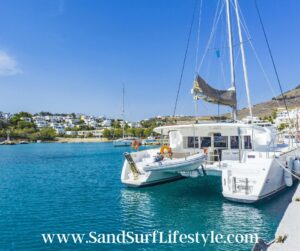
The ocean covered?
The places visited?
The company on board?
The memories made?
The knowledge gained?
The time spent on the water, and with the natural world?
The experience of actually steering a vessel through the sea, one of nature’s greatest miracles?
A combination of the above?
None of the above?
Think about it. Really take your time. Once you have a clear, honest idea of why you might want to sail a catamaran around the world, write it all down on a piece of paper. These notes will be your best friend while you read through this article and, eventually, decide on the appropriate vessel for your journey.
Initial Factors to Consider When Settling on a Catamaran Size
Primary items to consider when deciding on the size of your catamaran include basic comfort, speed, and circumnavigation.
For example, yes — the smaller, cheaper catamaran can carry a certain amount of people. But can it do so comfortably? Or will you and your passengers pay the price? We’ll get into this in more detail in just a moment. First, let’s talk about the speed of your catamaran. It’s all related — we promise.
When it comes to determining size, one must consider speed as well. Large, overloaded boats can move too slowly — but smaller ones can, too. This is where the shape of the boat comes into play. Boats with longer shapes and builds are absolutely your friends when selecting a catamaran — regardless of the size, you wind up going with. Not only are these better for speed, but they also come highly recommended by experts for circumnavigation and cargo purposes — the latter of which we will get into in more detail in the next section.
Regarding circumnavigation — what fun is sailing a catamaran if you can’t control it? Your ability to guide your catamaran should always be the top priority. Anything that seems to complicate or hinder this is something you should immediately rule out when deciding on a vessel.
How long does it take to learn how to sail? Find out here .
The relationship between catamaran size and essential “cargo”.
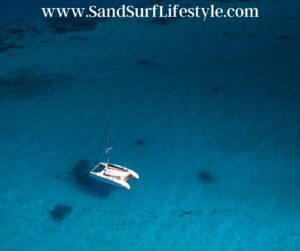
But there are other types of “cargo” as well. Necessary supplies, recreational items, the number of human beings, and how much space passengers will need while on board also matter — significantly.
For starters, ask yourself while you settle on a size for your catamaran whether you will have enough room for all the necessary supplies. Be honest with yourself. Longer, slower trips take more time and, therefore, require more of them. No matter what, you’ll need these items — food, water, first aid, medications, hygiene products, and other essential, rather heavy, and bulky supplies — while on board.
Additionally, if there are plans for fun and recreation while sailing — which, let’s be honest, there probably are — then you’ll need to ensure your vessel has the capacity for all of that as well. We’re talking furniture, sports stuff, audio equipment, and more. This aspect may seem like it should be an afterthought, but we promise you — it shouldn’t be. Be sure to keep it in mind while shopping around. What point is there to sailing around the world if you feel deprived, bored, or full of regret the entire time anyway? Make sure you have everything you’ll want and need before setting sail.
Furthermore, and as we already mentioned before, passenger “cargo” is also a thing. It’s vital that your catamaran have enough capacity for humans not only to survive but to travel comfortably.
Is this sail around the world all work with little to no play or human company? Then you won’t need as much room. The more likely scenario, however, is that you and the other people on board are looking to have fun — and therefore require adequate space to do so. This is a different type of “cargo,” but one that should be adequately considered throughout the selection process.
Similarly, imagine acquiring all the recreational items and loading them on board only to start sailing and discover that there isn’t even any room to use them all. Recreational, social, and even essential activities require the room in which to do them. Therefore, it’s important to have an idea ahead of time regarding what activities might be taking place on board. This will help you determine just how large of a vessel you need, as well as the shape of it.
What’s the point in sailing a catamaran around the world if you even can’t carry the things or people you need to make the trip worthwhile anyways?
Determining Catamaran Size in Relation to Your Budget
Of course, one of the most important considerations when deciding on a catamaran size is your budget. Larger catamarans with more features will cost more money upfront, yes. Nevertheless, the payoff regarding comfort, efficiency, practicality, and enjoyability while on board — as well as mandatory supplies you’ll need to carry on your travels and maintenance the vessel may eventually need — might make the investment worth it.
More importantly, safety is never worth skimping on, especially when it comes to sailing through the ocean over an extended period of time. If a smaller, simpler model is more affordable for you, just make sure it serves all your purposes, and that the lower price you’re paying is only in regards to the size of the catamaran. Paying less for a smaller vessel should not equal a higher risk factor while on board. Safety is key, and therefore, nonnegotiable.
The Best Catamaran Size(s) for Sailing Around the World
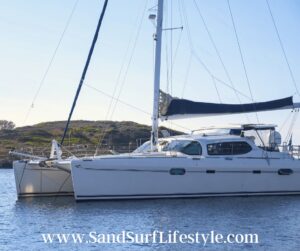
Some consider catamarans sized at 35 feet to 45 feet to be the best for ocean sailing. Many even consider 45 feet to be the sweet spot when it comes to picking out a catamaran for trips around the globe.
This isn’t to say that smaller vessels aren’t also an option. Catamarans sized at 25 feet to 30 feet are far more affordable — though, again, boats in this size range do tend to be more uncomfortable and less convenient. They also have less capacity. However, it is still possible to sail around the world in a catamaran sized within this 25 feet to 30 feet range.
Conversely, very large vessels are also doable. Catamarans in the 50 feet to 60 feet range absolutely do exist and are available for interested parties. However, they are extremely expensive. They are very much intended for those seeking total luxury while ocean sailing.
Again, a catamaran ranging between 35 feet and 45 feet should absolutely do the trick — for comfort, efficiency, space, and more importantly, function. These will get you around the world, and happily at that.
Either way, don’t forget that the size and price of your catamaran aren’t everything. Shape, safety, and circumnavigation are equally, if not more, important when it comes to ocean sailing.
Related Questions
What kind of recreational activities are popular while sailing? Depending on the length of the trip, people may want to do anything from eating fine cuisine to drinking and dancing, to sipping coffee and reading books, to even just tossing a basketball around. It just depends on the passengers on board.
Is a faster catamaran a better catamaran? Not necessarily. It just depends on how much time you want to spend at sea, and whether your trip is more about efficiency or luxury, and land time or water time. Just keep in mind that more time at sea means you’ll need more supplies and, therefore, more capacity for storing them.
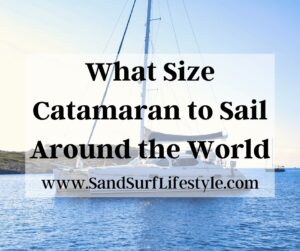
Please note: This blog post is for educational purposes only and does not constitute legal or medical advice. Please consult a legal expert or medical professional to address your specific needs.
Aloha! My name is Shawn and I Love the Beach and Ocean! From surfing to beach sports to boating and fishing I like it all. More importantly, I Love the people I get to meet who also share a passion for the sand and surf. Living and growing up near the ocean my heart has always been connected to the beach and its lifestyle. I wish to share my experience with those around the world. Mahalo (Thank You) for visiting and enjoy your stay here on my site!
Recent Posts
Adaptive Surfing: Overcoming Challenges and Inspiring Stories
Adaptive surfing has truly opened my eyes to the power of resilience and determination. The sport's inclusive nature has broadened my perspective and highlighted how adaptive surfers face and...
Spotlight on Surfing Destinations: Hawaii Edition
Exploring Hawaii's Surfing ParadiseSurfing in Hawaii has been a dream come true for me, as it's where I've discovered some of the most incredible waves and surfing cultures in the world. In this...

Published on August 19th, 2024 | by Editor
Record setting World Championship
Published on August 19th, 2024 by Editor -->
Imagine a line of the fastest single-handed racing catamarans stretching over a kilometre in length if placed end to end. This is the size of fleet that will assemble at the 2024 A-Class Cat World Championships to be held September 9-13 in Punta Ala, Italy.
At 18-feet in length, that’s over half an acre of boat area alone in what looks like being the year’s biggest single class cat party takes place on the lovely blue waters of the Mediterranean, on the Golfo Di Follonica off the Tuscan coast, to the East of Elba.
With 184 boats from 20 nations registered, this breaks the previous record of 155 coincidentally set at the 2015 Worlds which were held in… Punta Ala. The fleet is nearly split in half for its two class categories – Open Foiling and Classic non-foiling – which are essentially the same other than their allowed foil shapes and operation.
It was also at the 2015 Worlds when Glenn Ashby won the 9th of his 10 class World titles, and it was the first time a foiling cat had been seen in anger at any championships.

For this development class which had been non-foiling, Ashby and Dutch sailor Mischa Heemskerk totally dominated the races using J shaped foils which were tricky, hard to master, and somewhat unstable, leading to spectacular landings and crashes.
It was also at that 2015 event that the landmark vote took place on abolition, or not, of the class rule which required daggerboards to be inserted from the top, and was preventing further foiling development.
It was voted to be retained by a mere 0.3% majority in favour of the retention the rule, based on the Class rules sensibly requiring a two-thirds majority for any rule change.
This decision had a significant effect upon stabilising the class future, and ultimately led to the class becoming the twin fleet seen today with the Open (Foiling) and Classic (Non Foiling) categories now officially designated by World Sailing.
The reigning Classic World Champ Scott Anderson (AUS) and Open World Champ Kuba Surowiec (POL) will seek to defend their titles
Event information – Race details – Entry list
Source: Gordon Upton

Tags: A-Class Catamaran , A-Class Catamaran World Championship
Related Posts
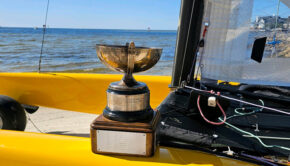
2024 A Class Catamaran North Americans →
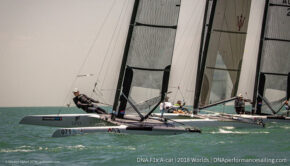
A-Class Catamaran having it both ways →
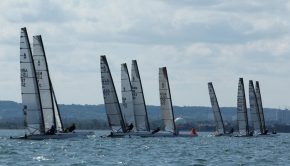
Two winners at A-Class North Americans →

Some kind of rodeo at A-Class Worlds →
© 2024 Scuttlebutt Sailing News. Inbox Communications, Inc. All Rights Reserved. made by VSSL Agency .
- Privacy Statement
- Advertise With Us
Get Your Sailing News Fix!
Your download by email.
- Your Name...
- Your Email... *
- Phone This field is for validation purposes and should be left unchanged.


The Ultimate Guide to Choosing Between a Sailboat or Catamaran for Your Sailing Adventures
C hoosing between a sailboat and a catamaran for your sailing adventures is a significant decision that depends on various factors, including your sailing preferences, experience level, budget, and intended use. Here's an ultimate guide to help you make an informed decision:
1. Sailing Experience:
- Sailboats: Typically require more skill and experience to handle, especially in adverse weather conditions. Ideal for sailors who enjoy the traditional feel of sailing and are willing to invest time in learning and mastering the art.
- Catamarans: Easier to handle, making them suitable for beginners. The dual-hull design provides stability, reducing the learning curve for those new to sailing.
2. Space and Comfort:
- Sailboats: Generally have a narrower beam and less living space. However, some sailboats may offer comfortable cabins and amenities.
- Catamarans: Wider beam creates more living space. Catamarans often have multiple cabins, spacious saloons, and expansive deck areas, providing a more comfortable living experience.
3. Stability:
- Sailboats: Monohulls can heel (lean) while sailing, which some sailors enjoy for the thrill but can be discomforting for others.
- Catamarans: Greater stability due to the dual hulls, providing a more level sailing experience. Reduced heeling makes catamarans suitable for those prone to seasickness.
4. Performance:
- Sailboats: Known for their upwind performance and ability to sail close to the wind. Some sailors appreciate the challenge of optimizing sail trim for efficiency.
- Catamarans: Faster on a reach and downwind due to their wide beam. However, they may not point as high into the wind as monohulls.
- Sailboats: Typically have a deeper draft, limiting access to shallow anchorages and requiring deeper marina berths.
- Catamarans: Shallow draft allows access to shallower waters and secluded anchorages, providing more flexibility in cruising destinations.
- Sailboats: Generally more affordable upfront, with a wide range of options available to fit different budgets.
- Catamarans: Often more expensive upfront due to their size and design. However, maintenance costs may be comparable or even lower in some cases.
7. Mooring and Docking:
- Sailboats: Easier to find slips and moorings in marinas designed for monohulls.
- Catamarans: Require wider slips and may have limited availability in certain marinas, especially in crowded anchorages.
8. Intended Use:
- Sailboats: Ideal for traditional sailors who enjoy the art of sailing, racing enthusiasts, or those on a tighter budget.
- Catamarans: Suited for those prioritizing comfort, stability, and spacious living areas, especially for long-term cruising and chartering.
9. Resale Value:
- Sailboats: Generally have a more established resale market, with a wider range of buyers.
- Catamarans: Growing in popularity, and well-maintained catamarans often retain their value.
10. Personal Preference:
- Consider your personal preferences, the type of sailing you plan to do, and the kind of lifestyle you want aboard your vessel.
In conclusion, both sailboats and catamarans have their advantages and disadvantages. Your decision should be based on your individual preferences, experience level, budget, and intended use. If possible, charter both types of vessels to experience firsthand how they handle and to help make a more informed decision based on your own preferences and needs.
The post The Ultimate Guide to Choosing Between a Sailboat or Catamaran for Your Sailing Adventures appeared first on Things That Make People Go Aww .

Advertisement
Supported by
A Waterspout Was Seen When a Luxury Yacht Sank. What Is It?
Witnesses reported seeing the tornado-like phenomenon hit the Bayesian, a sailing yacht that sank off the coast of Sicily on Monday.
- Share full article

By Eve Sampson
What caused the sinking on Monday of a sailing yacht carrying the British billionaire Mike Lynch and 21 other people off the coast of Sicily is still unknown. But some attention has focused on observations by witnesses, who described seeing a small tornado-like column known as a waterspout forming over the water during an abrupt and violent storm as the vessel sank.
Fifteen passengers on the 180-foot yacht, the Bayesian, escaped on a raft before being rescued by a neighboring cruise ship. The body of the ship’s cook was recovered on Monday and six people remain unaccounted for , including Mr. Lynch and his daughter Hannah, according to officials with Sicily’s civil protection agency.
Prosecutors in the nearby city of Termini Imerese have opened an inquiry into the cause of the sinking.
Here is what to know about waterspouts, a surprisingly common weather phenomenon that may have helped sink the luxury yacht.
What are waterspouts?
Waterspouts are columns of spinning air and moisture — similar to tornadoes over water, according to the National Weather Service .
While some form in fair weather, and are aptly called fair weather waterspouts, another more dangerous variety called tornadic waterspouts develops downward from a thunderstorm. These tornadic waterspouts can either form as regular tornadoes over land and move out to sea, or form in a storm already over a large body of water, according to the National Oceanic and Atmospheric Association .
Fair weather waterspouts are weak, often dissipate quickly and do not cause major damage, according to the agencies, but tornadic waterspouts are more often associated with high winds, dangerous and frequent lightning, and hail. The Italian authorities recorded strong winds and intense lightning activity at the time the yacht went down.
How common are waterspouts?
Experts say waterspouts may be more common than tornadoes, but because oceans are so vast, they are more difficult to track — and as difficult to predict.
“The Mediterranean is possibly one of the places where waterspouts are most likely around the world due to the warm ocean surface and a climate that is very susceptible to thunderstorms throughout the summer and autumn,” according to a statement by Peter Inness, a meteorologist at the University of Reading in the United Kingdom.
Mr. Inness pointed to a 2022 study by scientists from University of Barcelona , which found that waterspouts occurred more frequently over warmer sea surfaces. The North Atlantic ocean has been unusually hot for over a year, repeatedly reaching record highs for the time of year , according to data from the oceanic association.
The International Centre for Waterspout Research on Monday said on X , the platform formerly known as Twitter, that it had confirmed 18 waterspouts near Italy in recent days, and several fishermen in the area of the accident told Italian media that they had witnessed a waterspout near the yacht.
What may have happened?
Karsten Börner, the captain of the nearby boat that rescued the 15 passengers, said in an interview that he saw the Bayesian about 490 feet away before the wind and lightning picked up.
While it was difficult to see what happened amid the storm, “my theory was that she was capsized first and then went down over the stern,” he said.
Towering over 237 feet tall, the Bayesian mast was one of the tallest aluminum masts in the world and it also had a special keel that could be raised or lowered, according to its manufacturer, Perini Navi. A keel is the downward-extending centerline underneath a boat that can help stabilize the vessel.
“In this case, having a tall aluminum mast would not make it the safest port to be in case of a storm,” said Andrea Ratti, associate professor of nautical design and architecture technology the Politecnico di Milano.
He added that “a lot of questions will remain until we have other elements at our disposal.”
Elisabetta Provoledo contributed reporting.
Eve Sampson is a reporter covering international news and a member of the 2024-25 Times Fellowship class, a program for journalists early in their careers. More about Eve Sampson

Berthon Winter Collection

Latest issue

August 2024
In the August 2024 issue of Yachting World magazine: News Few finish a tempestuous Round The Island Race European rules are eased for cruising to France and Greece Olympic sailing…

Yachting World
- Digital Edition

Breaking news: One dead, six missing after sailing superyacht sinks off Sicily
- Helen Fretter
- August 19, 2024
Italian coastguards have reported that one man has died and six others are missing after a 183ft/56m sailing super yacht sank off the coast of Sicily in the early hours of Monday, 19 August

Update Tuesday 20 August: Specialist divers have, this morning launched a fresh search for the six people missing off the coast of Sicily. The missing individuals have been named as Mike Lynch, a British tech entrepreneur, Hannah Lynch, his 18-year-old daughter, Chris Morvillo, a lawyer who represented Lynch during a trial, and his wife Neda Morvillo, as well as Jonathan Bloomer, the chair of Morgan Stanley International bank, and his wife Judy Bloomer, a charity trustee.
The yacht Bayesian is a Perini Navi, launched in 2008 under the name Salute, and had 22 people onboard with 10 crew and 12 passengers. Those onboard included British, American and Canadian nationals.
The yacht left the Sicilian port of Milazzo on Wednesday 14 August, and AIS data shows the yacht last transmitted its position off Palermo around 0400 local time.
Italian press are reporting that the yacht was at anchor 300 meters from the Porticello harbour, near Palermo when it was hit by severe and sudden weather, and sank rapidly. It is not clear what caused the sinking, but some eyewitness accounts suggest it may have been suddenly dismasted.
The sudden storm is being reported as tornado-like conditions, or a waterspout.
Those onboard were assisted by other sailing vessels in the harbour, as well as emergency services, and 15 were rescued, including a one-year-old child and their parents.
Six are believed to still be missing, and search and rescue operations are still ongoing with divers on the scene. The yacht is understood to have sunk in around 50 meters of water. One body has been recovered by emergency services.
The yacht is British flagged and managed by Camper and Nicholsons International. It is the last of the 56m Perini Navi series, designed in collaboration with Ron Holland and built of aluminium, with a sloop rig 75m mast.
We’ll update more when we have further information.
- AROUND THE SAILING WORLD
- BOAT OF THE YEAR
- Email Newsletters
- America’s Cup
- St. Petersburg
- Caribbean Championship
- Boating Safety
- Ultimate Boat Giveaway

Cruising Cat Racing Franco Style
- By Herb McCormick
- August 20, 2024
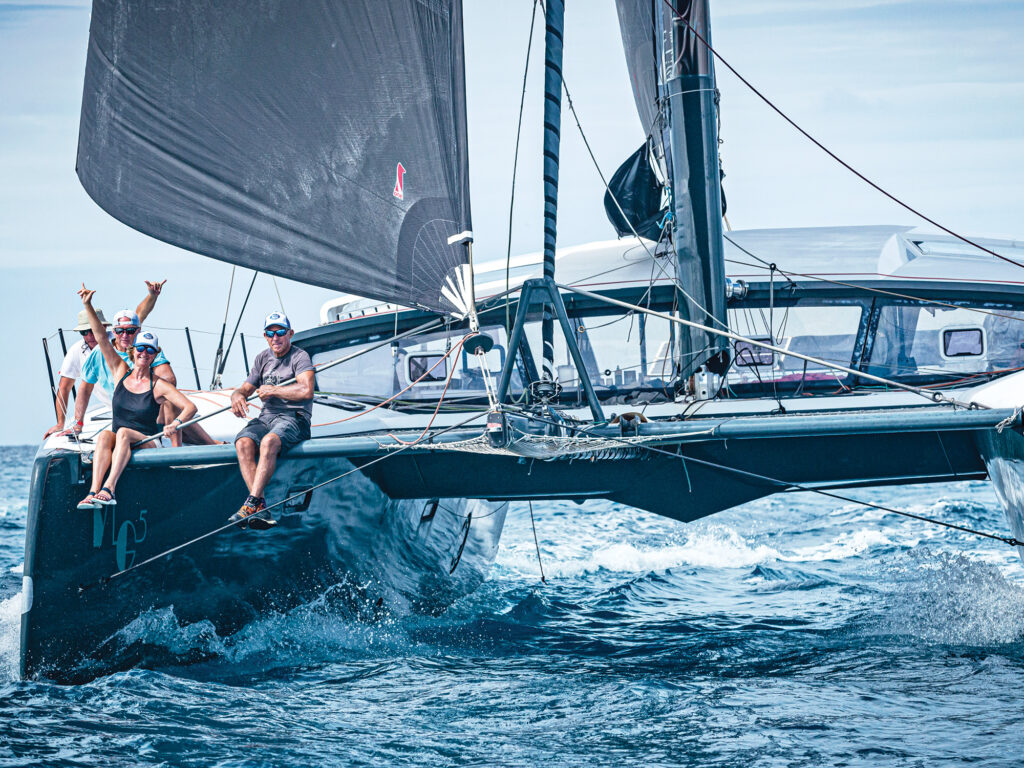
The French are different from us. After years of covering offshore sailing, particularly the shorthanded scene, that’s always been my take. What event could possibly be more French than the Vendée Globe, the quadrennial nonstop solo race around the planet on foiling IMOCA 60 rockets that’s front-page news in France for months on end, mainly because impending catastrophes and daring Southern Ocean rescues are seemingly daily occurrences? From ports along the Brittany coast and elsewhere, this nation produces the best ocean-racing specialists, and in my opinion, the greatest among them is ironman Francis Joyon, who holds or has held almost every major voyaging record, including winning the Jules Verne Trophy in 2017 for circling the globe in just over 40 days.
Surprisingly, given their prowess across multiple racing venues, the French have always mounted horrible America’s Cup campaigns, but even there, they’ve put their personal stamp on it. When ballpoint-pen magnate Baron Bich was consistently getting smoked in his four challenges during the 12-Metre days, the old joke was we could always tell that the French were about to tack when the crew flicked their cigarettes over the side.
All that said, other than occasional boat reviews with French sailboat manufacturers, I’d never really gone sailing with an all-French squad. That changed early this past February, when I score a ride with legendary competitor Marc Guillemot and his team for a day of racing off St. Maarten in the annual Caribbean Multihull Challenge Race and Rally. I’m eager to discover if the French boys are really playing the game differently.
Guillemot has enjoyed a long and productive career, the highlight of which was his third-place win in the 2008 Vendée aboard his IMOCA 60, Safran. Now in this mid-60s, his latest boat is a Christophe Barreau-designed 53-foot MG5 catamaran called Dazelad , roughly translated as “alternative” in English, as a nod to its innovative carbon construction and upcycled components.
“He’s won a lot of stuff and wanted his own personal boat, his home; it’s not about sponsors,” says French yachting journalist Emmanuel van Deth, who’d hooked me up with Guillemot. “It’s a compromise, so he can cruise with friends or race with friends.”
As a compromised “retirement” vessel that Guillemot plans to charter occasionally to offset expenses, it’s still pretty quick: He nabbed an impressive third place on its maiden voyage in the 2022 Route du Rhum.
Like jockeys and movie stars, it’s always a little jarring to meet French solo sailors in person; Joyon is a certified beast, but most of them are of rather diminutive stature, as is Guillemot. His English is spotty (but way better than my French), but he has an easy, elfin smile, and an extremely laid-back demeanor. I like him immediately. His extremely cool boat, in spirit and execution, is a crazy work of nautical art, the sum of many disparate parts.
Guillemot conducts a quick tour, which is fascinating. Much of the gear is stuff he scavenged from Safran. But that is just the start of it. It is in many ways a history of and tribute to the French singlehanded racing scene, with contributions from Guillemot’s many IMOCA pals. The rudder is from one of Jérémie Beyou’s old boats; Damien Seguin supplied the daggerboards; the running rigging is off Loick Peyron’s Gitana ; Jean Le Cam donated an old spar. If Frankenstein’s monster were a boat, it would be Dazelad.
The crew of close friends, including Guillemot’s brother, Regis, who dinghies over from his big cruising cat, is also notable. Longtime pro sailor and sailing writer Nicolas Raynaud is a jolly, Falstaffian character with a ready laugh and a twinkle in his eye who definitely seems like a kindred soul.
His polar opposite is tactician Bruno Jourdren, quiet and studious, who’d suffered a serious accident in his youth that had permanently damaged his right arm; he sails with his hand always in his pocket. A three-time Paralympic sailor, he has also cleaned up in dedicated one-design classes such as the Melges 24, where he is a former national champion.
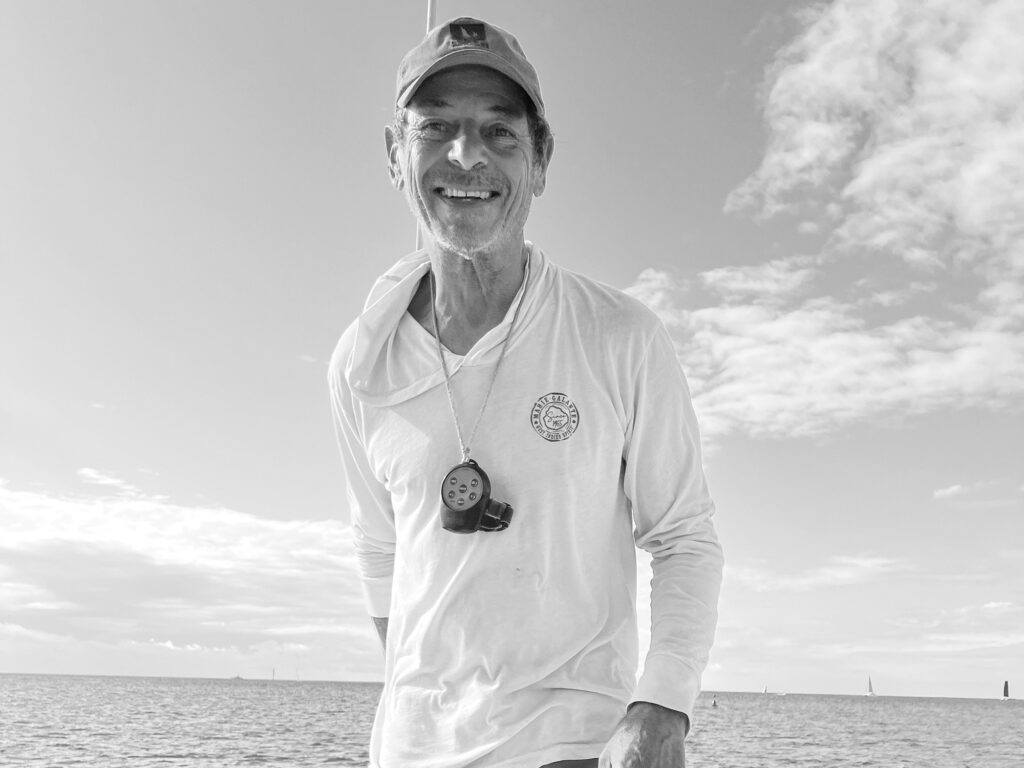
Before the day’s first race, Guillemot and Jourdren, huddled prerace over an iPad with the sailing instructions, are clearly very tight. Van Deth speaks of the latter in almost reverential terms: “They call Michel Desjoyeaux ‘the professor’ because of his navigational approach, but when it comes to tactics, Bruno is also considered an academic. If he says, ‘Go left,’ you go left. You do not question him.”
The most I can get out of Jourdren is a raised eyebrow, which is pretty much in keeping with all the previous professors in my life.
It is a strange day, weather-wise, for the Caribbean; the generally pumping, reliable easterly trade winds are on hiatus, replaced by an unusual northwest breeze of 10 knots. With a downwind start, there is a short debate about the merits of an asymmetric kite versus a code zero headsail, with the latter getting the call. I am relegated to the foredeck with Regis and Van Deth to furl and then unfurl the code zero through tacks and jibes. Foolishly, I’ve brought only flip-flops, thinking I’d sail barefoot, as I often do in the islands. But the trampolines on Dazelad are like razor wire, and footwear is a must. Rookie mistake.
Thanks to the headsail discussion, we are slightly late for the start, but once the code zero is sheeted home and Dazelad begins manufacturing its own apparent wind, we take off, easily notching 12-plus knots, and Desjoyeaux carves through the pack and picks off the competition (though there was no catching the HH66 and Gunboat 66 at the front of the fleet). The French are cooking.
There is a refreshing squall on the last tack to the finish line in a race with a little bit of everything, including a couple of lulls in the breeze. Guillemot seems pleased and philosophical with the midfleet result. “Under 12 knots [of wind], not so good,” he says. “Twelve or more, that’s when we go.”
The sun pops out and the breeze pipes up for Race 2, and Dazelad is in jailbreak mode off the starting line, ripping around the racecourse with average speeds in the midteens. The cat spins through tacks and jibes like a Hobie, and noticeably accelerates in every puff. The results aren’t any different from the first race, but the sailing itself is fantastic.
And then comes lunch. In this aspect of actual French cooking, there is no question that they will raise the bar. Raynaud has effortlessly whipped together a fresh pasta dish brimming with cucumbers, melons, avocado and cheese that is nothing less than magnificent. An obligatory break for a cigarette caps off the meal. Très bien, mon ami.
It is apparently an inspiring repast as Guillemot crushes the start for the third and final contest of the day. At this stage, spinning around the same triangle course off the southern coast of St. Maarten, the entire exercise is beginning to feel a little like Groundhog Day. By this time, however, we’ve become a pretty well-honed team, and our maneuvers are fairly flawless, if I do say so myself. For this race, the only cats ahead of us at the end are the pair of 66-footers. In surfing, it’s often been said that the best surfer is the one who’s having the most fun. If that’s also the case in sailboat racing, Dazelad is the day’s clear-cut winner. Raynaud, who is rapidly becoming my idol, passes out cold beers all around.
And then, at the literal end of the day, Guillemot and his mates hastily put away the boat. They have another important appointment. The French rugby team is about to play an international match with Ireland, and they are eager to get to a bar in Marigot on the island’s French side to watch the action. Yes, they are on their merry way to guzzle brews and basically watch football. Hmm. That’s when it hits me: Maybe these French dudes aren’t so different from us after all.
- More: Multihull , Print Summer 2024 , Racing , Sailboat Racing
- More Racing

The Marvelous AC75s On Deck
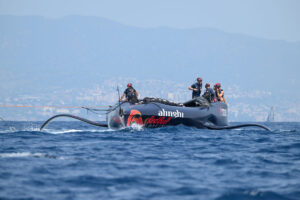
Alinghi Red Bull Racing Suffers Second Mast Failure

Hot Summer Scrimmages In Barcelona

The Caribbean’s Hot One-Design Fleet

Cole Brauer’s Voyage of Influence

New Extremes On the Horizon

- Digital Edition
- Customer Service
- Privacy Policy
- Terms of Use
- Cruising World
- Sailing World
- Salt Water Sportsman
- Sport Fishing
- Wakeboarding

9 Safest Catamarans For Cruising, Circumnavigation and Why!
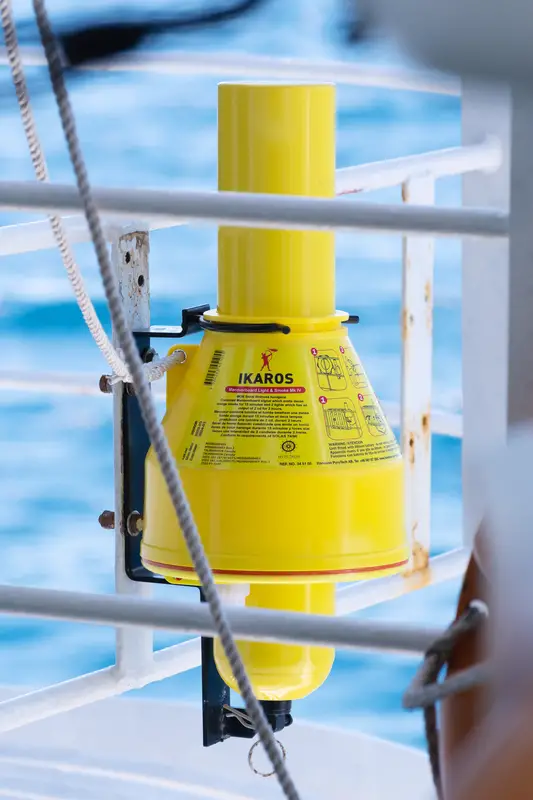
As an Amazon Associate, we earn from qualifying purchases. We may also earn commissions if you purchase products from other retailers after clicking on a link from our site.
Catamarans (cats) have become sailors’ favorite sea vessels in recent years, thanks to the extra space, comfort, and speed they offer. Additionally, they’ve built a reputation for their unrivaled safety. But which are the safest catamarans on the market?
The safest cruising catamarans offer a good beam to length ratio, sail fast, and are over 42ft. These include the Manta 42, the Lagoon 450F, and the Catana 44. They are stable, waterproof, easy to handle in stormy weather, and feature a sturdy design.
When boarding a boat, you expect to get to your destination safely, and with your bluewater boat intact, this is what cats are made for, but not all cats are created equal. Read on to learn what to consider when assessing a catamaran’s safety and check out my list of the safest cats available!
Table of Contents
What Does It Mean To Say a Catamaran Is Safe?
Cruising for weeks on open water comes with several risks, like strong winds, heavy rains, and other potentially dangerous obstacles. Because of that, you need a bluewater boat that’s designed to take a beating from the most demanding conditions because if you compromise your safety, you might end up in a very dire situation with possible deadly outcomes.
What does it mean to say something is safe?
In this context, the word safe means protected from danger , free from harm, or not likely to lose the boat, as well as not likely to cause danger or harm to either personal or cat.
Therefore, when a catamaran is said to be safe, it comes with features that protect you and your crew from danger. As a result, it would be best to consider a catamaran’s safety features before choosing it.
Here are some of the factors i (and sailboat engineers i should add) consider to be the most critical when determining a cat’s safety:

Beam-to-Length Ratio
Although catamarans generally have exceptional stability, this aspect is always relative, as you’ll find some cats more stable in rough seas than others. Therefore, you’ll want to check their beam-to-length ratio. As a general rule, a boat in the 42 to the 48-foot range should have a beam to length ratio of about 50%.
A ratio lower than that can hurt your boat’s stability in heavy winds, but a larger boat can be okay with a lower value. On the other hand, a larger ratio can make sailing more difficult.
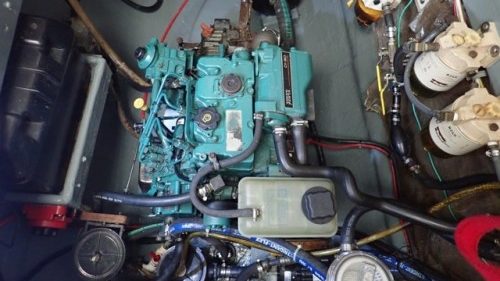
Engine and Powertrain
Catamarans come with twin engines, which is a significant benefit since you can always use one if the other fails. However, a poor choice of engine location can be a safety risk. Generally, a central location distributes the weight evenly, which is better for safety.
On bigger cats, this is not much of a problem since the weight of the engines is only a small fraction of the total weight of the boat. But on smaller and lighter ships, weight location is of greater interest.
Nonetheless, a watertight bulkhead between the main cabin and engine room prevents flooding if the sail drive or shaft gets damaged.
Having strong engines will also make the boat go faster and offer extra protection from getting stuck in bad weather.
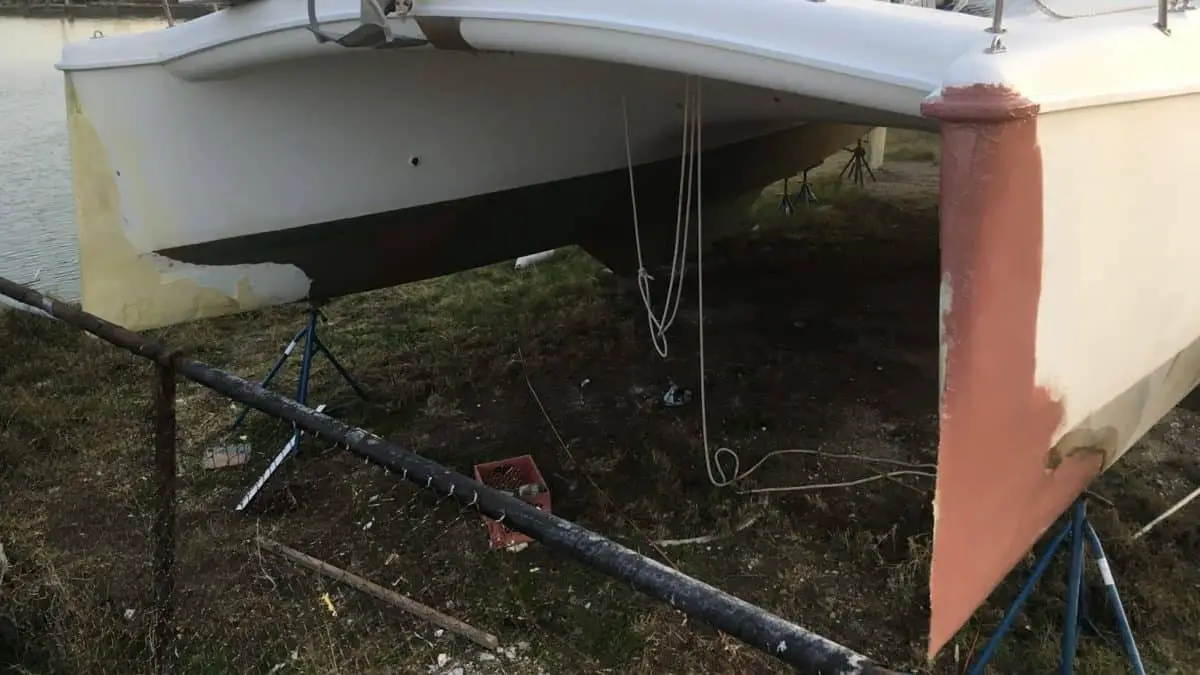
Build Integrity and Quality
Build quality is a critical factor when determining whether a given cat is safe, depending on the nature of your voyages. You’ll want to check the manufacturer’s reputation, the strength and quality of the materials used, and waterproofing features.
For instance, catamarans made of plywood or cored balsas are could be less safe since they often have maintenance problems once water enters them.
The underwater section of a cat should be solid, impact-resistant, and easy to repair for the boat to be considered safe. A significant portion of the vessel must be made of lightweight fiberglass to prevent the hull from sinking during a collision or capsizing. In other words, you’re safer with your boat upside-down on the water surface than right-side-up but submerged.
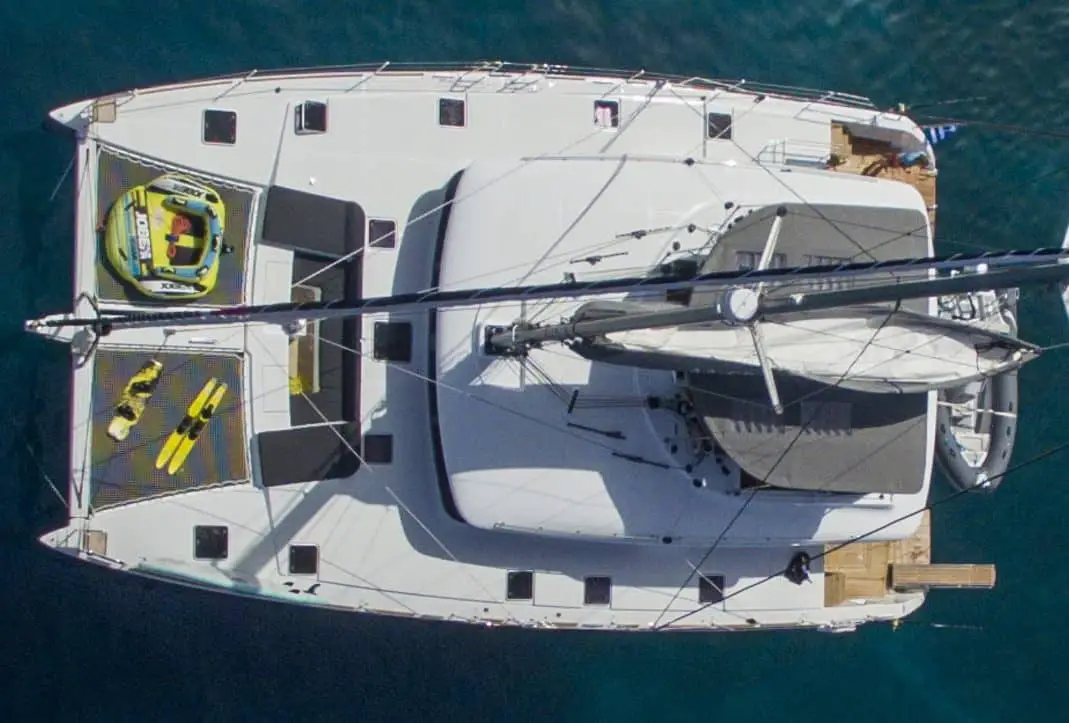
Check for Uncluttered and Flat Decks
A cat’s deck is another essential factor to consider when assessing its safety. Generally, uncluttered and flat decks tend to be safer for sailing since the risk of tripping or getting in stuck on something is reduced. Most notably, you should check if your boat comes with an aggressive non-skid surface to prevent slip and fall accidents among your crew. The deck should have robust, quality fittings and large backing plates to distribute heavy loads evenly.
Shrouds and stays should be located so they only minimally interfere with moving about on deck.
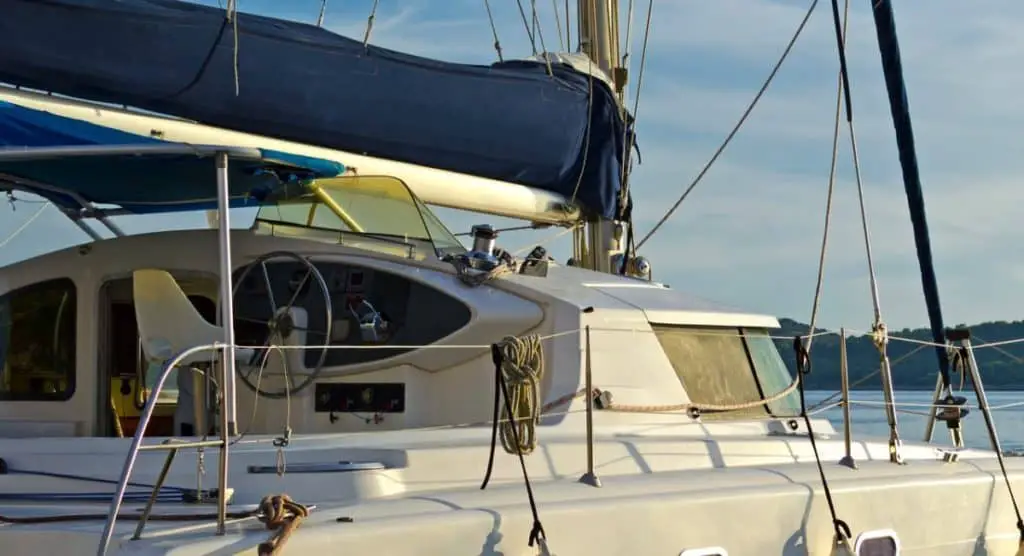
Helm Placement and Cockpit Protection
The primary helm station should have an unobstructed view of all four corners of your cat that should be well protected from the elements, like wind and water, and accessible from the cockpit. The idea is to prevent damage to your cat by the weather and prevent flooding, which compromises your safety.
Cockpit Covers
Your cat’s cockpit cover can make or break it under heavy rains. A carefully designed cover protects it from water infiltration when it’s raining and allows for sufficient ventilation.
Generally, the best cockpit covers come with removable curtains, allow for solar panel mounting, and can collect a significant amount of rainwater, which your crew can drink and use for washing.
Now that you have an idea of the things to consider when evaluating a cat’s safety, chances are you’re thinking of reviewing some of the boats on the market to determine if they’re suitable for your needs. To get you started on finding your dream boat I have put together this list, here are some of the best bluewater boats worth considering:
If you are looking for a specific type of cat i suggest you read on of my other articles such as:
- Best cats under 200k
- Best cats under 50ft
- Best cats for couples
- Best liveaboard cats
The Manta 42
Arguably, the Manta 42 holds near-iconic status among sailors because it has a solid reputation as a capable, practical long-range sailing bluewater boat. The laminated hull-to-deck joint and collision bulkheads create watertight compartments at the end of each hull, making the multihull flood-proof.
For additional structural integrity, the manufacturer joins the hull and deck using high-grade marine sealants and reinforces it with a 360-degree unidirectional laminate.
Overall, this is an excellent cruising cat.
It offers an impressive sail-area-to displacement ratio and a pretty decent amount of deck and interior space, and its pushpit contraptions come in handy when you need to secure wind vanes, solar panels, and dinghies. Undoubtedly, this boat offers great performance and stability.
| Beam-to-Length Ratio | 53% | 5 | |
| Helm Placement and Cockpit Protection | 8 | Good visuals and fully enclosed | |
| Engine and Powertrain | 5 | Dual inboard diesels | |
| Build Integrity and Quality | 5 | ||
| Check for Uncluttered and Flat Decks | 5 | ||
| Dagger or centerboards | NO | 5 | |
| Ease of handling | 5 | ||
| Offshore |
Lagoon 450F
The Lagoon 450F (F stands for Flybridge) is designed to deliver prestige and safety and features a deck layout centered on an easy-to-reach flybridge . Accessing the engine controls or steering station is a breeze, especially when you need to steer away from danger.
The cockpit comes with a dining table to the left, an attractive comfort couch to the right, and a wraparound settee. The boat’s hard dodger comes with an apt opening hatch that offers good ventilation and sunshine in favorable weather and protection from harsh conditions in bad weather.
The construction is sturdy, waterproof, and durable. Besides, its construction can withstand high impact, a solid selling point. If you need a boat that gives you ultimate control and offers all-around comfort, spaciousness, and elegance, you’ll never go wrong with this elaborate cat.
| Beam-to-Length Ratio | 56% | 5 | |
| Helm Placement and Cockpit Protection | 8 | Very good visuals and fully enclosed | |
| Engine and Powertrain | 5 | Dual inboard diesels 90HP | |
| Build Integrity and Quality | 5 (?) | * | |
| Check for Uncluttered and Flat Decks | 7 | High lifelines | |
| Dagger or centerboards | NO | 5 | |
| Ease of handling | 5 | ||
| Coastal |
Catana cats prove that the Bali Group means business when it comes to sailors’ safety. These boats are only produced in France, so the company maintains high-quality standards. Aboard Catana, you’ll immediately notice the manufacturer’s efforts to make it safe for cruising.
For instance, this boat’s foam sandwich construction is high density and lightweight, making it unsinkable, resistant to shock and impacts, and rigid. The use of aramid fiber makes this boat even more rigid and resistant to perforation. The helmsman can continue sailing even after impact.
It also comes with crash boxes and waterproof compartments to prevent water entry after a major impact. Arguably, this is a sure-fire way to guarantee buoyancy, making this boat hard to sink!
You can also use the multihull’s daggerboards to tack into strong winds and heavy weather, enabling it to glide over waves instead of capsizing. The high bridge deck clearance is another boost to safety since it prevents waves from reaching the cat’s deck.
| Beam-to-Length Ratio | 50% | 4 | |
| Helm Placement and Cockpit Protection | 6 | Single wheel partial view | |
| Engine and Powertrain | 5 | Dual inboard diesels 80HP | |
| Build Integrity and Quality | 5 | High-density PVC foam (balsa core) | |
| Check for Uncluttered and Flat Decks | 6 | Daggerboards in the way | |
| Dagger or centerboards | YES | 5 | Daggerboards |
| Ease of handling | 5 | ||
| Offshore |
Aventura 44
The Aventura 44 is the successor to the Aventura 43 built between 2012 and 2017, and its safety features are profound.
The deck mold is integrated with its coachroof to make it lightweight and buoyant, while the hulls feature polyester with NPG Gelcoat. Its structural partitions come with laminated CTBX plywood, and the rudders come with foam-epoxy composite and a stainless-steel stock, making it solid and durable.
This boat can withstand high impact from waves, winds, and collisions because of its ingenious construction. The company proudly tells how they intentionally oversized much of the hardware just to make sure it is up for offshore cruising.
| Beam-to-Length Ratio | 53% | 5 | |
| Helm Placement and Cockpit Protection | 6 | Single wheel partial view | |
| Engine and Powertrain | 7 | Dual inboard diesels 114HP | |
| Build Integrity and Quality | 6 | Oversized standard equipment | |
| Check for Uncluttered and Flat Decks | 6 | ||
| Dagger or centerboards | NO | 5 | |
| Ease of handling | 5 | ||
| Offshore |
Fountaine Pajot Elba 45
The Elba 45 is a well-respected blue water cruiser, as it is safe, dependable, and beautiful to look at. The slightly aft-raked bows and fixed stub keels deliver excellent windward performance.
The multihull features keels glued into a recess in its hulls, ensuring no keel bolts will rip out if it gets grounded or collides. Because of that, this boat deserves to be mentioned among the safest.
Safety aside, this boat provides ultimate bliss while cruising, as it comes with a generous living space with a large sofa, low dining table, and an open galley. The interior fittings in the cabins allow your crew to settle comfortably with an en-suite bathroom in each cabin.
As some put it, this is a true catamaran and it deserves a sweet spot for anyone looking for adventurous, open water cruising.
| Beam-to-Length Ratio | 56% | 5 | |
| Helm Placement and Cockpit Protection | 9 | Flybridge 360 view | |
| Engine and Powertrain | 7 | Dual inboard diesels 120HP | |
| Build Integrity and Quality | 5 | ||
| Check for Uncluttered and Flat Decks | 5 | Lots of space but high boom | |
| Dagger or centerboards | NO | 5 | |
| Ease of handling | 5 | ||
| Coastal |
Dolphin Ocema 42
The Dolphin 42 is the ideal option for any sailor looking for a catamaran that defies all conventions. It comes with daggerboards, which you can use to point higher into the wind and also reduce the draft when anchoring or moving in shallow water thus reducing the risk of grounding.
This vessel balances stunning performance and remarkable comfort in one package, a rare feat in blue water boats. The foam core makes it lightweight and impact-resistant at the same time, making cruising in the most demanding conditions less strenuous.
If you need a cruising boat that will never let you down, then you can never go wrong with the Dolphin 42.
Caveat: Pointing high on the wind using this boat requires pretty decent sailing expertise. If you lift the daggerboards too high, you may expose the rudders or interfere with the hulls if it runs aground.
| Beam-to-Length Ratio | 56% | 5 | |
| Helm Placement and Cockpit Protection | 7 | Partially obstructed | |
| Engine and Powertrain | 5 | Dual inboard diesels | |
| Build Integrity and Quality | 5 | Laminated wood | |
| Check for Uncluttered and Flat Decks | 5 | Daggerboards in the way | |
| Dagger or centerboards | YES | 7 | Daggerboards |
| Ease of handling | 5 | ||
| Offshore |
Atlantic 42
Since its introduction in 1993, the Atlantic 42 has grown its loyal fan base, thanks to its aesthetics and efficiency.
The multihull comes with a high-waist cockpit located in front of the pilothouse and behind its mast. As evidenced by the metal girder-like bearers that transverse the bulkheads, the solid construction is a selling point for any cruising enthusiast with safety considerations in mind.
Most notably, these features make it stronger, improve circulation, and offers a helm position in the middle of the boat.
Although some consider this boat’s style conservative, its durable, impact-resistant build quality is unrivaled. Without a doubt, the Atlantic 42 is built with your safety in mind, but it also comes with beautiful interior and exterior finishes. If you need a boat that delivers comfort, safety, and efficiency in a compact package, you’ll never go wrong with this blue water cruiser.
| Beam-to-Length Ratio | 56% | 5 | |
| Helm Placement and Cockpit Protection | 7 | Unprotected forward helm | |
| Engine and Powertrain | 5 | Dual inboard diesels | |
| Build Integrity and Quality | 5 | ||
| Check for Uncluttered and Flat Decks | 6 | Wide unobstructed areas | |
| Dagger or centerboards | NO | 5 | |
| Ease of handling | 5 | ||
| Coastal Offshore) |
Outremer 45
Looking at the Outremer 45, you can tell that it took careful, detailed planning to build. Its weight distribution is remarkably balanced for added stability, and it minimizes pitching, ensuring you have the smoothest sailing. Its parts meet international quality and safety standards.
The boat’s interior structure is pretty stiff since the components are directly laminated to its hull, improving its sturdiness.
It features the proprietary Jefa steering system, which is light and highly responsive to winds, a true mark of a quality multihull. If you try out its autopilot feature, you’ll immediately notice how its rigs and hulls balance remarkably.
In a nutshell, this boat is designed to take good care of your crew.
It comes in different versions, like an owner’s version, a club version with additional berths in the owner’s hull, and a four-cabin version. Arguably, this multihull deserves to be on the list of the best and safest blue water catamarans.
| Beam-to-Length Ratio | 51% | 5 | |
| Helm Placement and Cockpit Protection | 7 | 360 from inside | |
| Engine and Powertrain | 5 | Dual outboard 60HP | |
| Build Integrity and Quality | 8 | ||
| Check for Uncluttered and Flat Decks | 8 | ||
| Dagger or centerboards | YES | 8 | |
| Ease of handling | 6 | Very low boom, self tack | |
| Offshore |
What Is The Best Sized Catamaran For Ocean Sailing?
The best-sized catamaran for ocean sailing is around 42ft; it is small enough to be sailed by one person but big enough to provide safety and speed. But, of course, there are many variables to consider, if you want to understand why, I suggest you read my article on the topic:
Best sized Catamaran for Ocean Sailing and Liveaboard?
Wrapping Up
Cruising on a catamaran can be thrilling and worthwhile, as they come with impressive features that make them the favorite option for those seeking open water adventure. They offer incredible comfort, speed, maneuverability, and room space. Besides, they’re safer than monohull boats, thanks to their twin-hull design, which uniformly distributes their load.
Nonetheless, before buying any of the cats mentioned in this article, ensure you check the following specifications about them:
- Their beam-to-length ratio
- Helm placement
- Their structural integrity and quality
- Passagemaker: The Top Catamarans of 2020
- Sail Magazine: 10 Great Cruising Cats
- Catamaran Guru: Catamaran Safety
- Dream Yacht Sales: Best Catamaran Brands Guide – 6 Top Catamarans
- Aeroyacht: Catamaran Safety
- Yachts International: Sailboat Debate: Monohull vs. Catamaran
- PureTravel: Are Catamarans Safe in Rough Seas?
- Ocean Navigator: Evaluating Modern Catamarans
- Velmundi: Catamarans – Advantages and Disadvantages
- Catamaransite: Brand: Manta 42
- Multihull Solutions: Catana Safety
- Sail Magazine: Boat Review: Outremer 45
- Instant Sailing: Lagoon 450 F: Prestige at Its Peak
- Sail Magazine: Heavy Weather Strategies When Sailing a Catamaran
- Caribbean Multihulls: Fountaine Pajot Elba 45
- Boat Safe: Best Catamarans (Plus Pro Tips and Buying Guide)
Owner of CatamaranFreedom.com. A minimalist that has lived in a caravan in Sweden, 35ft Monohull in the Bahamas, and right now in his self-built Van. He just started the next adventure, to circumnavigate the world on a Catamaran!
Leave a Reply Cancel reply
Your email address will not be published. Required fields are marked *
Save my name and email in this browser for the next time I comment.
Recent Posts
Must-Have Boat Gear for Catamaran Sailors!
Sailing is probably the most gear-intensive activity I've ever done; there are so many decisions to be made about what gear to buy now, for tomorrow, and what to definitely never buy. The gear on...
6 Best Trailerable Trimarans For Bluewater and Coastal Sailing
Having a boat costs a lot of money, even when you are not using it, marina fees, etc. And once it is in the water most sailors never go very far from their "home marina" and sailing will be somewhat...

IMAGES
COMMENTS
The best catamarans for sailing around the world include: Lagoon 42. The Fountaine Pajot Ipanema 58. Manta 42. Catana 50. Dolphin 42. Gunboat 62. These cats focus on speed, safety, and comfort for longer journeys. This article will show you the seventeen best catamarans for long journeys, and why they're the best.
Yes, you can sail a catamaran around the world. In fact, full-size catamarans are some of the best circumnavigation sailboats on the market. They offer superior comfort, safety, storage space, and speed when compared to monohulls. Catamarans have become increasingly popular since the 1990s, and they're seen in ports all over the world.
A circumnavigation sailing trip on a catamaran : a 1,546-day adventure across 27 countries. The couple sailed their catamaran around the world for no less than 546 days, covering more than 34,140 nautical miles and 27 countries.
1) Lagoon 42 sailing catamaran - From $365,000. Features: Self-tacking jib, 3 or 4 cabins layout, island bed in the master cabin, 6 to 12 berths, up to 4 heads, 2 45hp engines, up to 4 heads, 300L water capacity, 300L fuel capacity. If you value comfort over speed, then the Lagoon 42 is the best sailing catamaran for you.
The Trade Winds route is the classic itinerary followed by most ocean-going catamarans. It promises crews the chance to sail around the world pushed by the wind, downwind, as long as they follow the rhythm of the seasons. It's possible to sail a catamaran from east to west, crossing three oceans and stopping off at some fantastic destinations.
Bénédicte can testify to this development: "The catamaran we've chosen sails easily in light airs. From 4-5 knots, it moves under sail, whereas classic catamarans need 10 to 15 knots to move properly, depending on the points of sail. So we use the engine very little and sail almost exclusively. On long journeys, sometimes the weather ...
There are 8 different ways to Sail around the world, Join a research vessel. Get on a friend's boat that is already out sailing. Date the owner of a boat. Get paid to work as a; Mechanic, Chef, or General helper. Use Your specialty skill to help the crew; online marketing, language teacher, musician, etc.
The Fast Route - for the minimum time. The Pleasure Route - for the maximal pleasure. The Traditional Route - the road most taken. The Arctic Route - for the rough ones. The Dangerous Route - without regards for piracy. The Cheap Route - with a budget in mind. The Coast Lover's Route - never going far from the coast.
The market for catamarans was worth approximately $1.5 billion in 2017. It then jumped significantly after back-to-back hurricanes, Maria and Irma, destroyed much of the Caribbean charter fleet late that same year. The industry expects catamarans to grow over 6.5 percent annually until 2024, which is great news for two reasons.
Sail with the weather forward or aft of the beam. Keep an eye on heel angle. Reduce sail if you start to see any more than 5° or so, unless you have a catamaran that is designed to lift a hull ...
Gemini 105M Courtesy of Gemini Catamarans. Pioneering catamaran sailor, builder and designer Tony Smith launched the first of his 33-foot Gemini 105M's (10.5 meters = 33′) in 1993, and soon after found a ready and willing stream of sailors enamored of the boat's compact size, affordable price tag, and such innovations as the nifty lifting rudder and transom steps.
Recently named the "Boat of the Year" for 2019 by Cruising World Magazine and Sail Magazine, the Elba 45 is the latest model in the incredible line of Fountaine Pajot catamarans. This boat was designed to replace the outgoing Helia 44 and stands to be one of the most popular catamarans with Fountain Pajot having sold over 100 Elba 45 hulls long ...
Catamarans are generally longer than monohulls, but their accommodations and handling vary widely between sizes. The best size catamaran to sail around the world is 45 to 50 feet. The smallest catamaran with space for long-term provisions and a cabin is around 30 feet in length, and a 55 to 60-foot catamaran is the largest that can be ...
Fountaine Pajot, one of the foremost builders of sailing catamarans, unveiled their biggest "Super Catamaran" ever: the Thira 80. The release comes on the tail of an ever-increasing trend in the catamaran market—the bigger-the- better era. With Sunreef, Lagoon, and Gunboat all making boats in the 70 to 80-foot range, these companies ...
Seeing this as a great chance to sail a purpose-built 50-foot offshore cruising catamaran to learn how it performed on an ocean passage in the many conditions we were sure to encounter on a 2,800-nautical-mile Atlantic crossing, we accepted the offer. Paul investigated a noise at the masthead; while the view was outstanding, he found the motion ...
Sailing performance was another key facet in the battle of the big cats from the big cat yards, Lagoon and Fountaine Pajot. Both models offer luxurious amounts of space for home from home comfort ...
Our PREFERRED Sailmaker: http://bit.ly/precision_sailsPLEASE SUBSCRIBE: http://bit.ly/2EmmGnLWANT US TO MAKE MORE VIDEOS? https://www.patreon.com/nahoaWe're ...
Below, we have selected ten of the world's largest power and sailing catamarans, which offer guests stylish and stable cruising experiences with oodles of space. World's Largest Power Cats 1. Hodor (Astilleros Armon) - 217 feet 2. Sunreef 49 Power Cat - 160 feet 3. Charley (Echo Yachts) - 150 feet 4. Moecca (Bannenberg & Rowell) - 148 feet 5.
Catamaran Sailing Techniques: Everything you need to know - Yachting World. The wind will give you a hard time. A catamaran is basically a big box with floating sleds; boxes are not famous for aerodynamics. This box-shaped floater will catch a lot of wind and will make slow speed movements, such as docking, a little bit trickier.
#sailingfamily #boatlife #sailing #liveaboard #boattour #yachttourIt's finally here! The much requested and much desired full boat tour video of our 2013 Lag...
Plenty of ideas here from a new French brand building speedy spacious catamarans from volcanic rocks and plastic bottles. Toby Hodges sails the first to laun...
3) Your budget in regards to catamaran size and, even more importantly, safety. 4) The actual measurements of the catamaran: 20 feet to 30 feet, 35 feet to 45 feet, and 50 feet to 60 feet being among the most popular sizes. As we already stated before, the best catamaran size for a journey around the globe varies on a case-by-case basis.
Imagine a line of the fastest single-handed racing catamarans stretching over a kilometre in length if placed end to end. This is the size of fleet that will assemble at the 2024 A-Class Cat World ...
Choosing between a sailboat and a catamaran for your sailing adventures is a significant decision that depends on various factors, including your sailing preferences, experience level, budget, and ...
Over 180 boats competing in Punta Ala from September 7th to 14th: a historic event for the A-Class.
What caused the sinking on Monday of a sailing yacht carrying the British billionaire Mike Lynch and 21 other people off the coast of Sicily is still unknown. But some attention has focused on ...
Italian coastguards have reported that one man has died and six others are missing after a 183ft/56m sailing super yacht sank off the coast of Sicily in the early hours of Monday, 19 August
Sailing World contributor Herb McCormick joins a crew of top-notch French sailors on their cruising cat in the Caribbean. ... Marc Guillemot's 53-foot MG5 catamaran is a cruising and trans ...
The safest cruising catamarans offer a good beam to length ratio, sail fast, and are over 42ft. These include the Manta 42, the Lagoon 450F, and the Catana 44. They are stable, waterproof, easy to handle in stormy weather, and feature a sturdy design. When boarding a boat, you expect to get to your destination safely, and with your bluewater ...
We are excited to see what this tropical paradise has in store for us and look forward to discovering the unique underwater world and unspoilt nature. #atoll #reef #snorkling #diversity #worldtraveler #SailingAdventures #sailing #bluewatersailing #glywo500 #outremercatamaran #yachting #culture #sailing #sailinglife #sailinginstagram # ...